
The 6 types of presentation (and why you need them)
Hrideep barot.
- Presentation , Public Speaking

We all have been exposed to different types of presentations right from school years.
Group presentations, lectures by teachers and professors, seminars, webinars or online presentations, e-learning, e-conferences, etc., are all different types of presentations that we come across in our daily lives.
But each of them work for different settings.
In this article, we will take a look at 6 such types of presentations and when and why you need them.
1. Informative Presentations
This is the most common type of presentation, be it in an educational setting or business or corporate setting.
The aim of an informative presentation is to give detailed information about a product, concept, or idea to a specific kind of audience.
They are often analytical or require a rational analysis of the data presented.
Training sessions or one-day workshops are good examples where this kind of presentation is used.
Here is an example of an informative presentation on public speaking and presentations.
Now, there are different situations where you can use informative presentations.
a) Reporting

Although a report is a written explanation of an event, it can also be verbal.
A perfect place to use informative presentations is news reporting , as it requires the presenter to present information systematically.
b) Briefing

This involves explaining both positive and negative aspects of a particular topic in a few words.
It is providing information quickly and effectively about an issue to influence decisions or to come to solutions.
Hence, the decision-making bodies of an organization can make use of this kind of presentation to save time and effectively come to conclusions.
c) Research
Informative presentations are often used to present research findings to a specific audience , as it involves reporting the findings and briefing it to the audience.
Hence, almost everywhere where research takes place, be it in an educational context or occupational , can make use of this kind of presentation.
Tips for giving informative presentations
- As there would be a lot of technical information and statistics, focus on the main points or agenda first and if you have more time, you can add them at the end
- Keep your presentation simple and clear . Avoid complex sentence structures and graphics
- Tell the outline of your presentation briefly in the introduction for a better flow
- Make sure that your presentation does not stretch for too long. 10-15 minutes is what your audience can concentrate on
- Restate your keyphrase at the end and briefly summarize all the important points of your presentation
Speech topics for an informative presentation
- Cropping techniques
- Organic Farming
- Corporate Farming
- Hydroponics
- Sustainable Agriculture, etc
- Climate change
- Environmental issues
- Eco-friendly ways of management
- Eco-politics
- Eco-feminism, etc
- Gender studies
- Gender and education
- Religious studies
- History of education
- Philosophy of education, etc
- Ethnic cultures
- Indigenous cultures
- Multiculturalism
- Popular culture
- Cultural trends, etc
- Business administration
- Business ethics
- Business models
- Promotion and marketing communications
- Finance, etc
2. Persuasive presentations
Persuasion is the art of motivating or convincing someone to act or make a change in their actions or thoughts.
If you are planning to give a persuasive presentation, and are looking for how to give a persuasive speech, check out our article on A Comprehensive Guide to Writing a Persuasive Speech to gain in-depth knowledge about the art of giving persuasive presentations.
Persuasive presentations are also widely used form after informative presentations.
There are various circumstances where persuasive presentations can be used.
a) Policy-making

Government bodies make use of persuasion almost every time, be it the legislative or decision-making bodies, executive bodies, or even courts.
Even election campaigns involve using persuasive presentations as an instrument of their pre-determined goals of swaying the citizens.
For that matter, any executive or management body of an organization can make use of these kinds of presentations.
b) Value judgment

This kind involves answering the question “why” and supplementing it with possible benefits.
Most Ted talks and YouTube videos try to persuade the audience and fall into the persuasive presentation category.
Even religious heads use this as a means of persuading their believers to follow their belief system.
Deciding on a procedure or telling an audience the correct procedure of doing something is another situation.
An example of a persuasive presentation
Bailey parnell: is social media hurting your mental health.
This TED talk by Bailey Parnell is a good example of a persuasive presentation.
She starts strong by asking rhetorical questions that set the mood for her further points.
We can also see how the speaker is genuinely concerned regarding the issue, engaging the audience till the end.
Tips for giving a persuasive presentation
- Start your presentation with a relevant quote or statistics about your topic to establish credibility
- Tell personal anecdotes and examples wherever necessary to develop an emotional connection with your audience
- Deliver your presentation with passion and genuine interest to motivate your audience to think
- Answer the question “why” for better understanding and clarity in your presentation
- State your viewpoint clearly and clarify doubts if your audience seems to have any
Speech topics for persuasive presentations
- Is animal testing ethical?
- Should cosmetic surgery be banned?
- Can the death penalty be the only solution to the rising crime rates?
- Should the legal age be 18?
- Should immigration laws be revised?
- Why you should never add your parents on Facebook
- Guys are more interested in gossip than girls
- It is your major duty to annoy your parents
- You are not enjoying student life if you are not procrastinating
- Endless memes can be made on my life, etc
- Is taming wild and exotic animals ethical?
- The importance of emotional support animals
- Why are bunnies the perfect pet?
- Why do animals make the best companions?
- Why there is a need for patients to have emotional support animals, etc
- How and why there is a need to do business analysis before opening your business?
- Why small businesses are successful and more profitable?
- Why do sales and customer service departments need to be paid more?
- Why does the HR department need to be polite and understanding?
- Why should you not do business with a family member?
- How charity is a means of converting black money to white?
- Why is detaining people on the suspicion of terrorism justified?
- Should euthanasia be made legal?
- Should violent crime offenders be sentenced to death?
- Should foreigners be allowed to buy a property?
3. Demonstrative presentations
This involves demonstrating a process or the functioning of a product in a step-by-step fashion.
So, a master class on communication skills or making a product model is an example of a demonstrative presentation.
Usually, the audience is an active part of such presentations and these can work in any context where you want the audience to learn a new skill.
a) Instructions

This involves giving guidelines or steps of a process or work .
Teaching how to make a car model step-by-step is a good example where you can use this kind of informative presentation to guide your audience.
Another instance can be at the workplace , to train the employees or introduce them to a new product at work.
This type also works with demonstrating recipes and cooking workshops.
An example of demonstrative presentation
The easy guide on making just about any smoothie.
In this recipe demonstration, he tells his audience how many ingredients are involved and briefs them about the outline of his presentation at the start of his speech.
He also shows all steps in real-time so that the audience have a better understanding of the process and keeps them engaged.
Tips to give a demonstrative presentation
- Introduce your product and its function to your audience before telling them how to go about with the steps
- Explain the steps with diagrams or show them in real-time along with the audience
- Give equal time to every person in the audience for clearing doubts, if any
- Keep your introduction short. Not more than 5 minutes
- Discuss options or variations that the audience can try at the end of the presentation
Speech topics for demonstrative presentations
- How to administer CPR
- How to wrap a gift professionally
- How to budget your monthly income
- How to choose a car insurance
- How to restore a piece of antique furniture
4. Inspirational presentations
As the name suggests, this type of presentation involves inspiring others!
The main aim of an inspirational presentation is to motivate or move your audience and is also known as a motivational presentation.
Using techniques like storytelling, narrating personal anecdotes , or even humor work wonders as your audience develops an emotional connection to the message.
This TED talk by Luvvie Ajayi Jones is humorous but a lot more inspirational. Check it out!
Tips for giving an inspirational presentation
- Start with a question that will leave the audience thinking. Pause for some time and then begin with your presentation
- Develop a sense of connection by narrating personal incidents and experiences to grow empathy
- Have some main points that you want to emphasize on
- Make use of humor ! It instantly builds a connection with the listener
- Non-verbal elements like paralanguage, body language, speech modulations, tone, etc., makes a huge difference
Speech topics for an inspirational presentation
- Importance of diversity and inclusion
- Building mental resilience
- Need for change management
- Valuing small victories in life
- How procrastinating is your enemy
5. Business presentations
In the corporate world, presentations are the go-to solution to do anything: planning or strategizing, articulating company goals, screening candidates, status reports , and many more.
Let us take a dive into the different types of business presentations.
a) Sales presentation

Also known as sales pitches , sales presentations involve providing information about a product or a service to sell it.
It has a pre-defined strategy of initiating and closing the sales deal.
This can be done in person or nowadays, on the phone, or via e-communication .
b) Training sessions

Often employees have on-the-job training sessions that are aimed to increase the knowledge and skills of the employees.
This kind can also involve the audience to participate , like in demonstrative presentations.
c) Meetings

Meetings can be called for for different reasons and can be of different forms as well.
Conferences ( both video and in-person), board meetings, informal team meetings, daily reporting, etc., are all various contexts of meeting in a business setting.
d) E- presentations
E- presentations existed before the COVID pandemic as well but were used seldom.
But, with the ongoing pandemic, e-presentations or remote presentations have replaced all other types of presentations and will be with us for a while longer.
However, on the brighter side, it is an eco-friendly alternative to normal face-to-face kind of a set-up, and it also saves transportation and other costs !
e) Seminars

Seminars are widely used in the health sector , usually involving a panel of speakers on a topic. The audience is anywhere between 10 to 100.
It ends with a question and answers session , and the audience gets to take handouts with them.
f) One-on-one or 1:1

Interviews are usually one-on-one and involve presenting your achievements and capabilities to your prospective employer.
Apart from interviews, 1:1 meetings are also used in sales and marketing to crack a business deal.
Tips for giving business presentations
- Include key phrases and other important details on your slides and make them bold
- Avoid casual slangs and informal tone of speech
- If you are giving a sales presentation, explain your product or service in simple and clear words , and list the reasons why it is beneficial for your potential clients
- Make sure to be on time ! Delaying your audience will work against you and leave a bad impression on you and your company
- Know your material or content thoroughly to answer the questions asked by your audience
Speech topics for business presentations
- Implementing an Agile Project
- Introduction to data modeling
- Introduction to UML(Unified Modeling Language)
- Social Media strategies for a successful business
- Business writing for managers
6. Powerpoint presentations
PowerPoint presentations or PPTs are the most effective ones among all types of presentations simply because they are convenient and easy to understand .
They are available in different formats and are suitable to use in practically any type of presentation and context, be it business, educational, or for informal purposes.
There are various types of PowerPoint presentations that you can use depending on the context.
a) PPTs for general audience

- For general audiences, avoid using jargon terms
If you feel that you need to use them, provide the audience some background information about the field or topic being covered
- Avoid using more than 8 words per line, as anything more than that becomes difficult to remember
- Use bullets or a numbered list for better retention
- Try not to read from your PPT
- Give handouts or record your presentation in case anyone wants it
b) PPTs for teaching

- In this case, the PowerPoint is content-based
- Make sure that the words on the slides are visible
- Use bigger font and avoid fancy fonts
- Add relevant pictures and graphics to keep your audience engaged
- You can also add documentaries or relevant videos to aid in understanding
c) Repurpose PPTs
- This involves reinventing an earlier ppt or combining 1 or more than 1 PowerPoints
- Giving new touches to an earlier PPT or changing the format
- You can take any slide of your PPT and upload it on social media for growing your brand or business
- You can even convert your PPT into mp4 , i.e, video format
- You can even add voice and save the mp4 format, and you have a good marketing plan!
d) PechaKucha

- This type of PowerPoint presentation comes from the Japanese word PechaKucha meaning sound of a conversation or chit-chat
- This involves changing slides every 20 seconds
- There can be a maximum of 20 slides , which means your presentation lasts for only 6 minutes and 40 seconds
- The PPT mostly has graphics and fewer words
- This type of presentation is best suited for telling a story or a personal anecdote
e) Multimedia presentations

- This is the best kind of PPT to engage your audience
- It contains texts along with pictures, videos, infographics, music, illustrations, GIFs , and many more
- Add higher resolution images and videos , or even a 360-degree snapshot if you are in the sales and marketing industry
- Adding infographics such as charts and graphs makes the process of understanding easier and saves time
- Music in a PPT helps your audience to be relaxed, at the same time making them alert and engaged
Types of slides in a presentation
PowerPoint presentation slides are broadly classified into 3 categories: Text, Visual, and Mixed slides.
1. Text slides
As the name suggests, this category of slides involve words or texts.
You can format the text as plain sentences or pointers.
You may even arrange them all in a single slide or one line per slide.
The slide seen below is an example where every point is mentioned in a single slide.
2. Visual slides
This type of slide has visual elements such as images or videos , and are better known as conceptual slides since they are a better option than text slide to explain a particular concept.
You can use them at the start of the presentation to better visualize and grasp the meaning of the presentation.
The slide right below is a good example of a visual slide.

3. Mixed slides
Mixed slides combine the texts and visuals to give a comprehensive understanding of any concept or a speech.
Graphs and charts are the best examples of mixed slides.
Mixed slides have an advantage over the other slides; they keep your audience engaged, listening and participating more actively!
![different types of ppt presentation Presentation Design: A Visual Guide to Creating Beautiful Slides [Free E-Book]](https://visme.co/blog/wp-content/uploads/2017/10/Say-It-Visually.jpg)
Types of Oral presentations
So far we came across 6 types of presentations, and they all share one common feature. They are all one of the types of oral presentations.
Oral presentations involve the use of verbal and non-verbal elements to deliver a speech to a particular or general audience.
All the types we discussed fall into these 4 broad categories:
1. Extemporaneous presentations
This type of presentation involves making short pointers or key phrases to aid while speaking.
You do not memorize, but organize the points and structure the speech way in advance.
Hence, on the day of your presentation, by just looking at the key points , you expand on them and move to the next point.
2. Impromptu presentations
Impromptu presentations are spoken without any preparation . It can be nerve-wracking for many, and hence not many are in favor of it.
There is a valid reason for their fear, as you have to make your speech as you say it!
However, those who are experts in their fields and are called upon to share a few words can easily give this type of presentation.
3. Manuscript presentations
The other extreme of the spectrum is manuscript presentations.
Here you have a script and you speak from it, word by word.
News anchors and show announcers usually engage in this type, since there are a lot of specific details that cannot be said wrong, and also, time constraints.
Usually, a prompter is used, from which the speaker speaks to their audience.
Nowadays, there are teleprompters , that are heavily used in the entertainment and media industry.
It is a digital screen that displays the contents, and the speaker speaks from it.
4. Memorized presentations
This type does not have any notes or cues , but you memorize or rote learn the whole speech.
School and some presentations at the workplace involve using this kind of presentation.
In most cases, we recommend not to memorise your speech in most cases. We’ve made a video on the same and how it could lead to you potentially blanking out on stage. Highly recommend you view this quick vid before choosing memorisation as a presentation path:
But, if you do choose it for whatever reason, since you are free from notes, you are free to focus on other aspects, such as body language and gestures.
Types of presentation styles
There are various presenting styles, but they do not work for all types of presentations.
Let us get familiar with them, and know which style works with which type.
a) The storyteller

This style of presentation involves the speaker narrating stories and engaging the audience emotionally .
This technique works best with persuasive and inspirational types of presentation.
So, how to tell a story in a presentation?
- Understand and know your audience : Knowing your audience will help you with how you will frame your story, at the same time gauging the relevance of your narrative
- Know your message : Be clear with what you want to convey through your story or how you are connecting the story with your actual presentation
- Try narrative a real-life story : Inspiring presenters often take their own stories or the stories of people whom they know as a supplement to their presentation. When the audience listens to your real-life examples, they become genuinely interested in your story
- Add visual aids : Using visual aids such as pictures, videos, multimedia, etc., increases the memory retention and engagement of your audience
- Use the “you” attitude : Tell the story keeping your audience in mind because ultimately they are going to be the receivers and hence, the story should be relevant and should include their point of view as well
Want more storytelling tactics? Mystery, characterisation and the final takeaway are some more key elements of a good story for your next presentation. We’ve gone deeper into this topic in this video if you would like to know more:
b) The Visual style

Most of us are visual learners, making visual information easy to understand and retain.
Visual aids like graphics, images, diagrams, key pointers or phrases , etc., are very useful when giving any type of presentation.
Some tips of presenting with visual style:
- Include only important pointers in your PowerPoint presentation and highlight or bold them
- Try including visuals that complement what you are saying and use them as a supplementary tool to aid in understanding your audience
- If you are giving a business presentation and want to include visuals, instead of plain texts, include graphics and charts to make information simpler to present and understand
- Avoid overly complex visuals as it will confuse the audience more
- Avoid using more than 6 lines per slide
c) Analytic style

If you have data records or statistical information to be presented, an analytic style will be more helpful.
It works best for Informative and Business types of presentations.
Tips to deliver in analytic style:
- Give handouts so that the audience is on track with your presentation and the information will be easier to comprehend
- Focus and speak on selected data as too much data statistics can be overwhelming for the audience
- You can make use of humor and personal anecdotes to keep the presentation interesting and engaging
- If you have too much data and are worried that you will not be able to explain it in the time frame given, avoid writing content of more than 2000 words
Quick tip: In case you have a PDF to present and want to edit the data points, there are multiple software programs that you can use to allow you to easily do this. Check out this list of the Best Free Recording Software Programs to know more.
d) The Connector

The connector style of presentation involves the speaker establishing a connection with the audience by pointing out similarities between them and the listeners.
This style works well with Sales and marketing presentations.
How to give a presentation using connector style?
- Have a Q & A round with the audience at the end of your presentation for clarifying any doubts and avoiding miscommunication
- Use audience polls at the start of your presentation to know your audience and tailor your speech accordingly
- Make use of body language and gestures for delivering your presentation effectively. If you are confused or want to know more about the aspects of how to use body and gestures, check out our article on To walk or stand still: How should you present when on stage?
- Ask questions to your audience at regular intervals for a better audience engagement
- Make use of multimedia sources to keep your audience engaged and entertained
Which type of presentation is best?
Although all the presentation types have their own bonuses and are suitable for certain circumstances, some are universal and can be used with a little bit of modification almost everywhere!
These are persuasive presentations!
You can use them in various settings; from political, business to educational.
Just remember to choose the right topic for the right audience, and a style that you think is the most suitable and you are good to go!
Level up your public speaking in 15 minutes!
Get the exclusive Masterclass video delivered to your inbox to see immediate speaking results.
You have successfully joined our subscriber list.
To conclude
We saw 6 types of presentation and understood it in detail.
We also gained some tips on how to make our presentation more engaging and also came across things to avoid as well.
We then explored the types of slides that you can use, and also the types of presenting orally.
We also gave you some tips and a few topic ideas that you can incorporate in your next speech!
Enroll in our transformative 1:1 Coaching Program
Schedule a call with our expert communication coach to know if this program would be the right fit for you

7 Keys to Emcee Like a Pro: Unlock Your Hosting Potential

8 Ways to Rise Above the Noise to Communicate Better

How to Negotiate: The Art of Getting What You Want

- [email protected]
- +91 98203 57888
Get our latest tips and tricks in your inbox always
Copyright © 2023 Frantically Speaking All rights reserved
Kindly drop your contact details so that we can arrange call back
Select Country Afghanistan Albania Algeria AmericanSamoa Andorra Angola Anguilla Antigua and Barbuda Argentina Armenia Aruba Australia Austria Azerbaijan Bahamas Bahrain Bangladesh Barbados Belarus Belgium Belize Benin Bermuda Bhutan Bosnia and Herzegovina Botswana Brazil British Indian Ocean Territory Bulgaria Burkina Faso Burundi Cambodia Cameroon Canada Cape Verde Cayman Islands Central African Republic Chad Chile China Christmas Island Colombia Comoros Congo Cook Islands Costa Rica Croatia Cuba Cyprus Czech Republic Denmark Djibouti Dominica Dominican Republic Ecuador Egypt El Salvador Equatorial Guinea Eritrea Estonia Ethiopia Faroe Islands Fiji Finland France French Guiana French Polynesia Gabon Gambia Georgia Germany Ghana Gibraltar Greece Greenland Grenada Guadeloupe Guam Guatemala Guinea Guinea-Bissau Guyana Haiti Honduras Hungary Iceland India Indonesia Iraq Ireland Israel Italy Jamaica Japan Jordan Kazakhstan Kenya Kiribati Kuwait Kyrgyzstan Latvia Lebanon Lesotho Liberia Liechtenstein Lithuania Luxembourg Madagascar Malawi Malaysia Maldives Mali Malta Marshall Islands Martinique Mauritania Mauritius Mayotte Mexico Monaco Mongolia Montenegro Montserrat Morocco Myanmar Namibia Nauru Nepal Netherlands Netherlands Antilles New Caledonia New Zealand Nicaragua Niger Nigeria Niue Norfolk Island Northern Mariana Islands Norway Oman Pakistan Palau Panama Papua New Guinea Paraguay Peru Philippines Poland Portugal Puerto Rico Qatar Romania Rwanda Samoa San Marino Saudi Arabia Senegal Serbia Seychelles Sierra Leone Singapore Slovakia Slovenia Solomon Islands South Africa South Georgia and the South Sandwich Islands Spain Sri Lanka Sudan Suriname Swaziland Sweden Switzerland Tajikistan Thailand Togo Tokelau Tonga Trinidad and Tobago Tunisia Turkey Turkmenistan Turks and Caicos Islands Tuvalu Uganda Ukraine United Arab Emirates United Kingdom United States Uruguay Uzbekistan Vanuatu Wallis and Futuna Yemen Zambia Zimbabwe land Islands Antarctica Bolivia, Plurinational State of Brunei Darussalam Cocos (Keeling) Islands Congo, The Democratic Republic of the Cote d'Ivoire Falkland Islands (Malvinas) Guernsey Holy See (Vatican City State) Hong Kong Iran, Islamic Republic of Isle of Man Jersey Korea, Democratic People's Republic of Korea, Republic of Lao People's Democratic Republic Libyan Arab Jamahiriya Macao Macedonia, The Former Yugoslav Republic of Micronesia, Federated States of Moldova, Republic of Mozambique Palestinian Territory, Occupied Pitcairn Réunion Russia Saint Barthélemy Saint Helena, Ascension and Tristan Da Cunha Saint Kitts and Nevis Saint Lucia Saint Martin Saint Pierre and Miquelon Saint Vincent and the Grenadines Sao Tome and Principe Somalia Svalbard and Jan Mayen Syrian Arab Republic Taiwan, Province of China Tanzania, United Republic of Timor-Leste Venezuela, Bolivarian Republic of Viet Nam Virgin Islands, British Virgin Islands, U.S.

10 Types of PowerPoint Slides for Convincing Presentations!
When it comes to creating presentations, PowerPoint is indispensable. Obviously, the most important part of any presentation are PowerPoint slides with the right content to communicate your message.
We’ll show you 10 types of PowerPoint slides that you can use in your presentation. We’ll also explain the benefits of each slide type and the added value they can bring to your presentation.
PowerPoint slides: Different slide types for your presentation
A presentation lives and dies by its PowerPoint slides and content. Have you ever noticed how many diverse types of PowerPoint slides there are? Text and picture slides usually have different layouts. And this is just the beginning – there are so many more slide types and layouts.
In the following breakdown, we’ll show you what PowerPoint slides are out there and how to use them to create a professional presentation!
10 types of PowerPoint slides
1. the text slide.
You’re sure to have at least one text slide in very presentation. Text belongs in your presentation . This type of slide is unavoidable if you want to simply convey information .
Be sure to use text in measured doses ; no one wants to read large blocks of text anymore. Less is definitely more . As soon as you display your slide, your audience will begin to read the text to themselves. This limits their capacity to focus on your presentation.
Use the 5×5 rule or reduce your text to one key message per slide . Click here to find out how the 5×5 rule works and how you can further reduce text .
You can also play with the design of text slides!

2. The picture slide
You’re probably no stranger to PowerPoint slides with picture elements. This slide type is the perfect way to underscore your statements and visually enhance your presentation – true to the motto, “A picture is worth a thousand words”. Moreover, the right use of images will inspire emotions in your audience and grab their attention .
But just like text, images should be used wisely . Pictures that are meaningless and only used to fill empty slides look unprofessional and out of place. Also make sure to use professional images and avoid stock images as much as possible, as they don’t add any individuality.
Take a look at these articles for more information about images in PowerPoint:
- Insert images quickly with the Scan&Paste app
- Compress pictures
- Flip pictures
- Make images transparent
- Optimize images in presentations
- Highlight pictures with a grid design

3. Introduction and closing slides
These PowerPoint slides belong in every presentation. Whether it’s a business or university presentation, introduction and closing slides will bookend your presentation perfectly .
With an introduction slide, you pave the way for a strong start to your presentation . With a closing slide, you summarize the main points of your presentation . This guarantees that by the end of your presentation, these points are clear to your audience and will stay fresh in their minds.
Tip: Looking for tips on how to end your presentation on the perfect note ? This post summarizes some effective ways to do just that. We also have helpful tips for kicking off your presentation in this post .
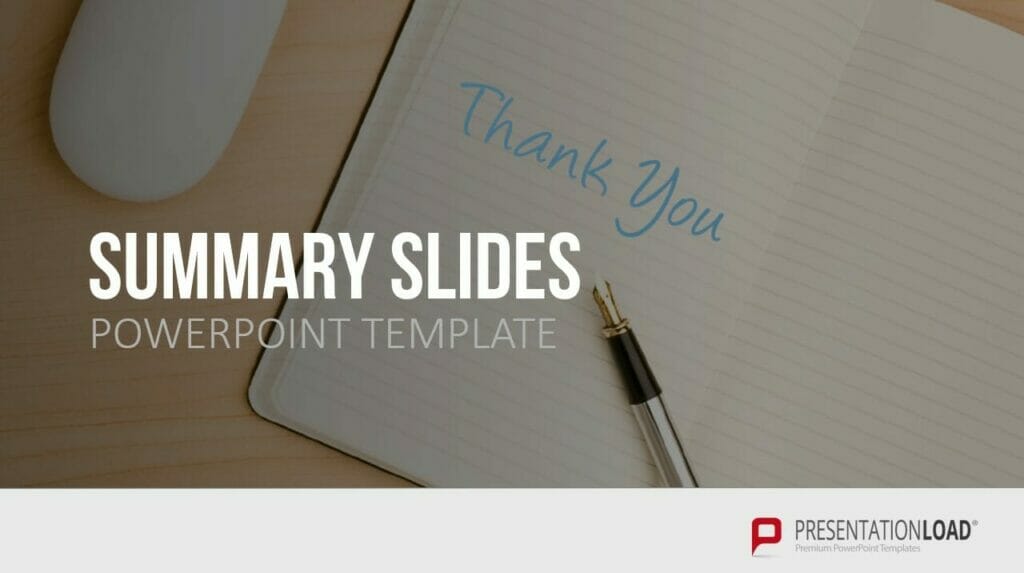
4. The agenda slide
This PowerPoint slide should be included in every high-quality and professional PowerPoint presentation. The agenda slide provides an audience with a brief outline of the presentation’s content and structure right from the get-go.
It also provides you, the presenter, with a quick reminder of how the presentation will flow and gets you off to a good start.
This article explains how you can create your own PowerPoint table of contents for your agenda slide.
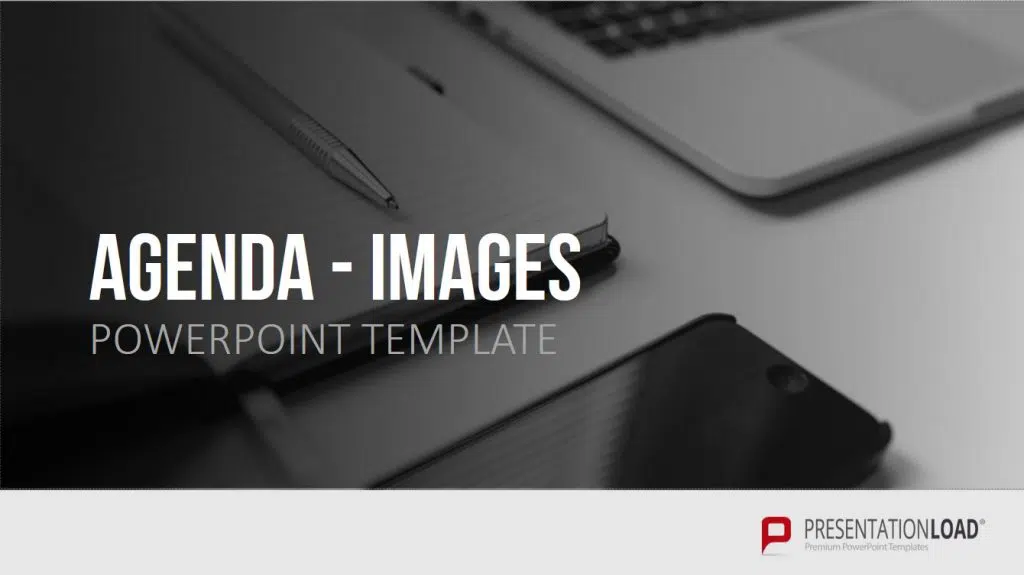
5. The quote slide
The quote slide is effective and shouldn’t be overlooked. As the name suggests, this slide consists only of a quote, usually placed in the center, without any further expository text or images . Quotes are mostly short-form statements of opinion, either personal or from well-known individuals.
Why should you use this type of PowerPoint slide? How will a quote slide support your presentation?
Quote slides support your content . For example, you can use a quote from a famous person (e.g., successful entrepreneur) to support your data and key messages . The truthfulness of the quote also provides weight to your content and supports the veracity of your key messages.

6. Chart and diagram slides
Chart and diagram slides are used often in presentations, particularly in presentations for companies within the financial sector.
Chart and diagram slides are similar to picture slides in that they underscore what is being said. Numbers and data can be clearly presented to the audience using a chart and diagram slide, making the content understandable without the need for any additional text.
Charts and diagrams also add visual appeal and variety to your presentation. By using a diagram, you avoid long blocks of text, which are often less interesting for your audience.
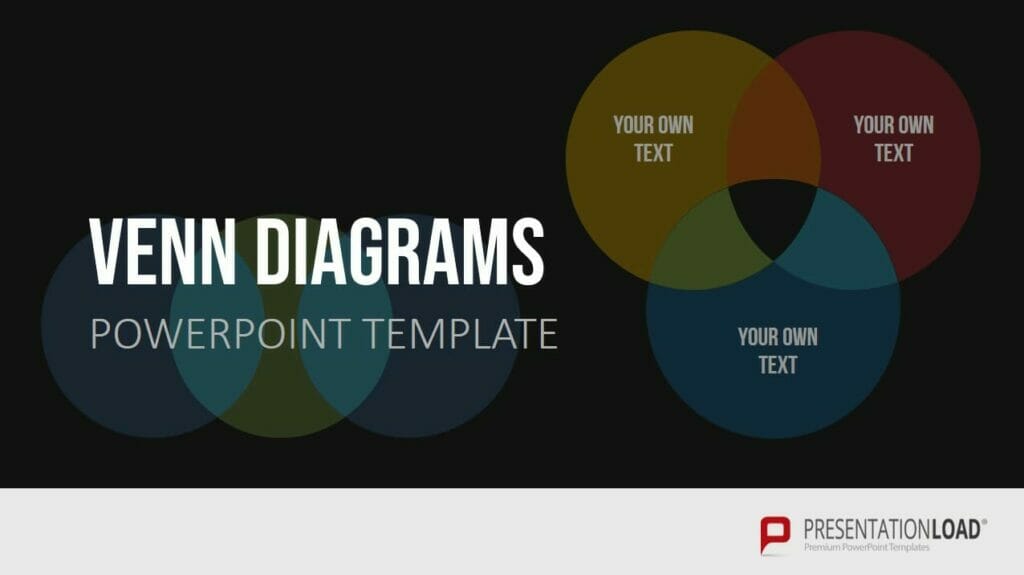
7. The table slide
Similar to chart and diagram slides, table slides visually support your data and facts. They help declutter presentations and clearly convey your messages to your audience .
This type of PowerPoint slide also helps you avoid overly long blocks of text that honestly, your audience won’t read anyway.

8. The link/hyperlink slide
Do you want to link to an internet page within your presentation? Maybe to a YouTube video that supports your topic or to an internal website with your products? Links can be used in so many ways in a presentation.
This PowerPoint slide type will also be a positive change for your audience. Calling up a link creates a new visual stimulus, which in turn helps you hold your audience’s attention.
Links reinforce your slide content and leave a professional impression on your audience.
Using a link slide can only benefit your presentation. Think about how you can use this PowerPoint slide type effectively for your topic.
9. The animation slide
How about some moving images? With these PowerPoint slides, you’ll definitely grab your audience’s attention! Animations are visually engaging and offer the audience a welcome change from a presentation’s typically static slides .
The broad range of animation options is something you can really use to your advantage. For example, you can focus your audience’s attention by making text appear with a click of the mouse . This is especially effective with bullet points. When you display all the bullet points simultaneously, your audience will start reading through them, meaning they’ll be paying less attention to you and what you’re saying.
Or try using a unique GIF as an animation. You can find out how to do this here .
Other animation options are animation paths , such as flashing arrows, emphasis effects , color effects, etc. Read more about what you can do with animations here .
The important thing with animations is to stick to your presentation style and use them in moderation. A presentation full of flashing slides or pop-up images can be irritating and look unprofessional. Always use animations carefully and sensibly.

10. The call-to-action slide
Even though you may not be familiar with this PowerPoint slide, you should really think about using it in a professional presentation. Especially if your presentation goal is to attract new customers or to sell products.
A call to action – what is it exactly? In short, it’s a prompt from a company or presenter to encourage an audience to perform an action . For example, this can be a request on what to do after the presentation (visit an online store to see products, write an email with questions, etc.). You can find more information in this post .
Do you want to make a request or invitation to your audience at the end of the presentation? Then this is the PowerPoint slide for you!
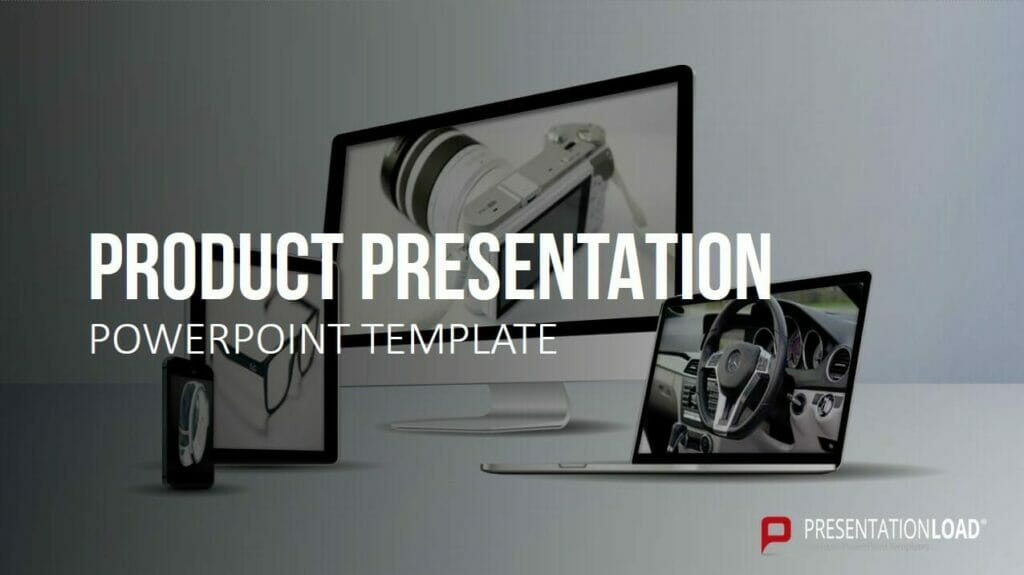
10 Types of PowerPoint slides: So many ways to make your presentation more varied and professional
No doubt you’ve already used some of the 10 types of PowerPoint slides from our breakdown and integrated them perfectly into your presentations.Maybe it’s time to try a novel approach and use a wide variety of PowerPoint slides to suit your topic .
Remember: The PowerPoint slides you choose should be cohesive , especially if you use different slide types.
A variety of slide types will always be a welcome addition to your presentation. So, ask yourself what might be exciting for your audience and incorporate these ideas into your presentation preparation .
Do you have questions about the 10 types of PowerPoint slides in this article or are you looking for PowerPoint help in general? Please feel free to contact us by email at [email protected] . We’d be happy to help you!
Looking to add variety to your slides, but would like to have the work of creating a presentation taken off your hands? No problem. Our team will create a professional presentation for you according to your wishes. Click here to get in touch.
These articles might also interest you:
- 6 modern ideas for your slide layout
- The ideal presentation structure
- Creating a presentation: Tips & tricks
- PowerPoint slide master
- How many slides does a presentation need?
- Viva presentations: Tips & tricks
Share this post
- share
- save

Design Thinking: Problem Solving with a Difference

Why Corporate Mission Statements Are So Important

7 Tips & Learnings from the Apple Keynote
Home Blog Education Presentation Skills 101: A Guide to Presentation Success
Presentation Skills 101: A Guide to Presentation Success
Getting the perfect presentation design is just a step toward a successful presentation. For the experienced user, building presentation skills is the answer to elevating the power of your message and showing expertise on any subject. Still, one can ask: is it the same set of skills, or are they dependable on the type of presentation?
In this article, we will introduce the different types of presentations accompanied by the skillset required to master them. The purpose, as always, is to retain the audience’s interest for a long-lasting and convincing message.

Table of Contents
The Importance of Presentation Skills
Persuasive presentations, instructional presentations, informative presentations, inspirational presentations, basic presentation skills, what are the main difficulties when giving a presentation, recommendations to improve your presentation skills, closing statement.
Effective communication is the answer to reaching business and academic goals. The scenarios in which we can be required to deliver a presentation are as diverse as one can imagine. Still, some core concepts apply to all presentations.
We define presentation skills as a compendium of soft skills that directly affect your presentation performance and contribute to creating a great presentation. These are not qualities acquired by birth but skills you ought to train and master to delve into professional environments.
You may ask: is it really that evident when a presenter is not prepared? Here are some common signs people can experience during presentations:
- Evasive body language: Not making eye contact with the audience, arms closed tightly to the body, hands in pockets all the time.
- Lack of interest in the presenter’s voice: dull tone, not putting an effort to articulate the topics.
- Doubting when asked to answer a question
- Irksome mood
The list can go on about common presenter mistakes , and most certainly, it will affect the performance of any presented data if the lack of interest by the presenter is blatantly obvious. Another element to consider is anxiety, and according to research by the National Institute of Mental Health, 73% of the population in the USA is affected by glossophobia , which is the fear of public speaking, judgment, or negative evaluation by other people.
Therefore, presentation skills training is essential for any business professional who wants to achieve effective communication . It will remove the anxiety from presentation performance and help users effectively deliver their message and connect with the audience.
Archetypes of presentations
Persuasive presentations aim to convince the audience – often in short periods – to acquire a product or service, adhere to a cause, or invest in a company. For business entrepreneurs or politicians, persuasive presentations are their tool for the trade.
Unless you aim to be perceived as an imposter, a proper persuasive presentation has the elements of facts, empathy, and logic, balanced under a well-crafted narrative. The central pillar of these presentations is to identify the single factor that gathered your audience: it could be a market need, a social cause, or a revolutionary concept for today’s society. It has to be something with enough power to gather critiques – both good and bad.
That single factor has to be backed up by facts. Research that builds your hypothesis on how to solve that problem. A deep understanding of the target audience’s needs , concerns, and social position regarding the solution your means can offer. When those elements are in place, building a pitch becomes an easy task.
Graphics can help you introduce information in a compelling format, lowering the need for lengthy presentations. Good presentation skills for persuasive presentations go by the hand of filtering relevant data and creating the visual cues that resonate with what your audience demands.
One powerful example of a persuasive presentation is the technique known as the elevator pitch . You must introduce your idea or product convincingly to the audience in a timeframe between 30 seconds and less than 2 minutes. You have to expose:
- What do you do
- What’s the problem to solve
- Why is your solution different from others
- Why should the audience care about your expertise

For that very purpose, using engaging graphics with contrasting colors elevates the potential power of your message. It speaks professionalism, care for details, and out-of-the-box thinking. Knowing how to end a presentation is also critical, as your CTAs should be placed with care.
Therefore, let’s resume the requirements of persuasive presentations in terms of good presentation skills:
- Identifying problems and needs
- Elaborating “the hook” (the element that grabs the audience’s attention)
- Knowing how to “tie” your audience (introducing a piece of information related to the hook that causes an emotional impact)
- Broad knowledge of body language and hand gestures to quickly convey your message
- Being prepared to argue a defense of your point of view
- Handling rejection
- Having a proactive attitude to convert opportunities into new projects
- Using humor, surprise, or personal anecdotes as elements to sympathize with the audience
- Having confidence
- Be able to summarize facts and information in visually appealing ways

You can learn more about persuasive presentation techniques by clicking here .
In the case of instructional presentations, we ought to differentiate two distinctive types:
- Lecture Presentations : Presentations being held at universities or any other educative institution. Those presentations cover, topic by topic, and the contents of a syllabus and are created by the team of teachers in charge of the course.
- Training Presentations : These presentations take place during in-company training sessions and usually comprise a good amount of content that is resumed into easy-to-take solutions. They are aimed to coach employees over certain topics relevant to their work performance. The 70-20-10 Model is frequently used to address these training situations.
Lecture presentations appeal to the gradual introduction of complex concepts, following a structure set in the course’s syllabus. These presentations often have a similar aesthetic as a group of professors or researchers created to share their knowledge about a topic. Personal experience does tell that course presentations often rely on factual data, adequately documented, and on the theoretical side.
An example of a presentation that lies under this concept is a Syllabus Presentation, used by the teaching team to introduce the subject to new students, evaluation methods, concepts to be learned, and expectations to pass the course.

On the other hand, training presentations are slide decks designed to meet an organization’s specific needs in the formal education of their personnel. Commonly known as “continuous education,” plenty of companies invest resources in coaching their employees to achieve higher performance results. These presentations have the trademark of being concise since their idea is to introduce the concepts that shall be applied in practice sessions.
Ideally, the training presentations are introduced with little text and easy-to-recognize visual cues. Since the idea is to summarize as much as possible, these are visually appealing for the audience. They must be dynamic enough to allow the presenter to convey the message.

Those key takeaways remind employees when they revisit their learning resources and allow them to ruminate on questions that fellow workers raise.
To sum up this point, building presentation skills for instructional presentations requires:
- Ability to put complex concepts into simpler words
- Patience and a constant learning mindset
- Voice training to deliver lengthy speeches without being too dense
- Ability to summarize points and note the key takeaways
- Empathizing with the audience to understand their challenges in the learning process

The informative presentations take place in business situations, such as when to present project reports from different departments to the management. Another potential usage of these presentations is in SCRUM or other Agile methodologies, when a sprint is completed, to discuss the advance of the project with the Product Owner.
As they are presentations heavily dependent on data insights, it’s common to see the usage of infographics and charts to express usually dense data in simpler terms and easy to remember.

Informative presentations don’t just fall into the business category. Ph.D. Dissertation and Thesis presentations are topics that belong to the informative presentations category as they condense countless research hours into manageable reports for the academic jury.

Since these informational presentations can be perceived as lengthy and data-filled, it is important to learn the following professional presentation skills:
- Attention to detail
- Be able to explain complex information in simpler terms
- Creative thinking
- Powerful diction
- Working on pauses and transitions
- Pacing the presentation, so not too much information is divulged per slide

The leading inspirational platform, TEDx, comes to mind when talking about inspirational presentations. This presentation format has the peculiarity of maximizing the engagement with the audience to divulge a message, and due to that, it has specific requirements any presenter must meet.
This presentation format usually involves a speaker on a stage, either sitting or better standing, in which the presenter engages with the audience with a storytelling format about a life experience, a job done that provided a remarkable improvement for society, etc.

Empathizing with the audience is the key ingredient for these inspirational presentations. Still, creativity is what shapes the outcome of your performance as people are constantly looking for different experiences – not the same recipe rephrased with personal touches. The human factor is what matters here, way above data and research. What has your experience to offer to others? How can it motivate another human being to pursue a similar path or discover their true calling?
To achieve success in terms of communication skills presentation, these inspirational presentations have the following requirements:
- Focus on the audience (engage, consider their interests, and make them a part of your story)
- Putting ego aside
- Creative communication skills
- Storytelling skills
- Body language knowledge to apply the correct gestures to accompany your story
- Voice training
- Using powerful words

After discussing the different kinds of presentations we can come across at any stage of our lives, a group of presentation skills is standard in any type of presentation. See below what makes a good presentation and which skills you must count on to succeed as a presenter.
Punctuality
Punctuality is a crucial aspect of giving an effective presentation. Nothing says more about respect for your audience and the organization you represent than delivering the presentation on time . Arriving last minute puts pressure on the tech team behind audiovisuals, as they don’t have enough preparation to test microphones, stage lights, and projector settings, which can lead to a less powerful presentation Even when discussing presentations hosted in small rooms for a reduced audience, testing the equipment becomes essential for an effective presentation.
A solution for this is to arrive at least 30 minutes early. Ideally, one hour is a sweet spot since the AV crew has time to check the gear and requirements for your presentation. Another benefit of this, for example, in inspirational presentations, is measuring the previous presenter’s impact on the audience. This gives insights about how to resonate with the public, and their interest, and how to accommodate your presentation for maximum impact.
Body Language
Our bodies can make emotions transparent for others, even when we are unaware of such a fact. Proper training for body language skills reduces performance anxiety, giving the audience a sense of expertise about the presented topic.
Give your presentation and the audience the respect they deserve by watching over these potential mistakes:
- Turning your back to the audience for extended periods : It’s okay to do so when introducing an important piece of information or explaining a graph, but it is considered rude to give your back to the audience constantly.
- Fidgeting : We are all nervous in the presence of strangers, even more, if we are the center of attention for that moment. Instead of playing with your hair or making weird hand gestures, take a deep breath to center yourself before the presentation and remember that everything you could do to prepare is already done. Trust your instincts and give your best.
- Intense eye contact : Have you watched a video where the presenter stared at the camera the entire time? That’s the feeling you transmit to spectators through intense eye contact. It’s a practice often used by politicians to persuade.
- Swearing : This is a no-brainer. Even when you see influencers swearing on camera or in podcasts or live presentations, it is considered an informal and lousy practice for business and academic situations. If you have a habit to break when it comes to this point, find the humor in these situations and replace your swear words with funny alternatives (if the presentation allows for it).
Voice Tone plays a crucial role in delivering effective presentations and knowing how to give a good presentation. Your voice is a powerful tool for exposing your ideas and feelings . Your voice can articulate the message you are telling, briefing the audience if you feel excited about what you are sharing or, in contrast, if you feel the presentation is a burden you ought to complete.
Remember, passion is a primary ingredient in convincing people. Therefore, transmitting such passion with a vibrant voice may help gather potential business partners’ interest.
But what if you feel sick prior to the presentation? If, by chance, your throat is sore minutes before setting foot on the stage, try this: when introducing yourself, mention that you are feeling a bit under the weather. This resonates with the audience to pay more attention to your efforts. In case you don’t feel comfortable about that, ask the organizers for a cup of tea, as it will settle your throat and relax your nerves.
Tech Skills
Believe it or not, people still feel challenged by technology these days. Maybe that’s the reason why presentation giants like Tony Robbins opt not to use PowerPoint presentations . The reality is that there are plenty of elements involved in a presentation that can go wrong from the tech side:
- A PDF not opening
- Saving your presentation in a too-recent PowerPoint version
- A computer not booting up
- Mac laptops and their never-ending compatibility nightmare
- Not knowing how to change between slides
- Not knowing how to use a laser pointer
- Internet not working
- Audio not working
We can come up with a pretty long list of potential tech pitfalls, and yet more than half of them fall in presenters not being knowledgeable about technology.
If computers aren’t your thing, let the organization know about this beforehand. There is always a crew member available to help presenters switch between slides or configure the presentation for streaming. This takes the pressure off your shoulders, allowing you to concentrate on the content to present. Remember, even Bill Gates can get a BSOD during a presentation .
Presentations, while valuable for conveying information and ideas, can be daunting for many individuals. Here are some common difficulties people encounter when giving presentations:
Public Speaking Anxiety
Glossophobia, the fear of public speaking, affects a significant portion of the population. This anxiety can lead to nervousness, trembling, and forgetfulness during a presentation.
Lack of Confidence
Many presenters struggle with self-doubt, fearing that they may not be knowledgeable or skilled enough to engage their audience effectively.
Content Organization
Organizing information in a coherent and engaging manner can be challenging. Presenters often grapple with how to structure their content to make it easily digestible for the audience. Artificial Intelligence can help us significantly reduce the content arrangement time when you work with tools like our AI Presentation Maker (made for presenters by experts in presentation design).
Audience Engagement
Keeping the audience’s attention and interest throughout the presentation can be difficult. Distractions, disengaged attendees, or lack of interaction can pose challenges.
Technical Issues
Technology glitches, such as malfunctioning equipment, incompatible file formats, or poor internet connectivity, can disrupt presentations and increase stress.
Time Management
Striking the right balance between providing enough information and staying within time limits is a common challenge. Going over or under the allotted time can affect the effectiveness of the presentation.
Handling Questions and Challenges
Responding to unexpected questions, criticism, or challenges from the audience can be difficult, especially when presenters are unprepared or lack confidence in their subject matter.
Visual Aids and Technology
Creating and effectively using visual aids like slides or multimedia can be a struggle for some presenters. Technical competence is essential in this aspect.
Language and Articulation
Poor language skills or unclear articulation can hinder effective communication. Presenters may worry about stumbling over words or failing to convey their message clearly.
Maintaining appropriate and confident body language can be challenging. Avoiding nervous habits, maintaining eye contact, and using gestures effectively requires practice.
Overcoming Impersonal Delivery
In virtual presentations, maintaining a personal connection with the audience can be difficult. The absence of face-to-face interaction can make it challenging to engage and read the audience.
Cultural and Diversity Awareness
Presenting to diverse audiences requires sensitivity to cultural differences and varying levels of familiarity with the topic.
In this section, we gathered some tips on how to improve presentation skills that can certainly make an impact if applied to your presentation skills. We believe these skills can be cultivated to transform into habits for your work routine.
Tip #1: Build a narrative
One memorable way to guarantee presentation success is by writing a story of all the points you desire to cover. This statement is based on the logic behind storytelling and its power to connect with people .
Don’t waste time memorizing slides or reading your presentation to the audience. It feels unnatural, and any question that diverts from the topic in discussion certainly puts you in jeopardy or, worse, exposes you as a fraud in the eyes of the audience. And before you ask, it is really evident when a presenter has a memorized speech.
Build and rehearse the presentation as if telling a story to a group of interested people. Lower the language barrier by avoiding complex terms that maybe even you aren’t fully aware of their meaning. Consider the ramifications of that story, what it could lead to, and which are the opportunities to explore. Then, visualize yourself giving the presentation in a natural way.
Applying this technique makes the presentation feel like second nature to you. It broadens the spectrum in which you can show expertise over a topic or even build the basis for new interesting points of view about the project.
Tip #2: Don’t talk for more than 3 minutes per slide
It is a common practice of presenters to bombard the audience with facts and information whilst retaining the same slide on the screen. Why can this happen? It could be because the presenter condensed the talk into very few slides and preferred to talk. The reality is that your spectators won’t retain the information you are giving unless you give visual cues to help that process.
Opt to prepare more slides and pace your speech to match the topics shown on each slide. Don’t spend more than 3 minutes per slide unless you have to introduce a complex piece of data. Use visual cues to direct the spectators about what you talk about, and summarize the principal concepts discussed at the end of each section.
Tip #3: Practice meditation daily
Anxiety is the number one enemy of professional presenters. It slowly builds without you being aware of your doubts and can hinder your performance in multiple ways: making you feel paralyzed, fidgeting, making you forget language skills or concepts, affecting your health, etc.
Meditation is an ancient practice taken from Buddhist teachings that train your mind to be here in the present. We often see the concepts of meditation and mindfulness as synonyms, whereas you should be aware that meditation is a practice that sets the blocks to reach a state of mindfulness. For presenters, being in the here and now is essential to retain focus, but meditation techniques also teach us to control our breathing and be in touch with our body signals when stress builds up.
The customary practice of meditation has an impact on imagination and creativity but also helps to build patience – a skill much needed for connecting with your audience in instructional presentations.
Having the proper set of presentation skills can be quite subjective. It goes beyond presentation tips and deepens into how flexible we can be in our ability to communicate ideas.
Different presentations and different audiences shape the outcome of our efforts. Therefore, having a basic understanding of how to connect, raise awareness, and empathize with people can be key ingredients for your career as a presenter. A word of advice: success doesn’t happen overnight. It takes dedication and patience to build communication skills . Don’t condition your work to believe you will be ready “someday”; it’s best to practice and experience failure as part of the learning process.

Like this article? Please share
Business Presentations, Presentation Approaches, Presentation Skills Filed under Education
Related Articles

Filed under Business • April 22nd, 2024
Setting SMART Goals – A Complete Guide (with Examples + Free Templates)
This guide on SMART goals introduces the concept, explains the definition and its meaning, along the main benefits of using the criteria for a business.

Filed under PowerPoint Tutorials • April 1st, 2024
How to Add Subscript and Superscript in PowerPoint
Using subscript and superscript in PowerPoint shouldn’t be a challenge. Learn how to properly use these two special type symbols with this guide.

Filed under Design • March 27th, 2024
How to Make a Presentation Graph
Detailed step-by-step instructions to master the art of how to make a presentation graph in PowerPoint and Google Slides. Check it out!
Leave a Reply

< Go back to Login
Forgot Password
Please enter your registered email ID. You will receive an email message with instructions on how to reset your password.

6 Types of Presentation You Must Know (+ Tips)
Are you tired of giving the same old boring presentation, using the same format every time? Have you ever wondered if there are different types of presentations to achieve different objectives?
If any of these questions resonate with you, this blog is the perfect resource.
In today’s world, presentations are an essential part of almost every profession. At some point in your life, whether you are a student, business professional, or teacher, you will have to deliver a presentation. But do you know there are different types of presentations, each with a specific purpose and objective?
This blog will cover the six essential types of presentation that you should be familiar with. We will explain each type, its purpose, and some tips to deliver it effectively.
Let us delve into the different types of presentation and explore them together.
Why Do We Need Different Types of Presentations?
Different types of presentations effectively communicate ideas and information in a variety of settings and for different audiences. The purpose of a presentation can vary depending on the goals of the presenter and the needs of the audience. For example, a sales pitch may require a persuasive and visually appealing presentation to convince potential customers to buy a product, while a training session may need a more instructional and detailed approach.
The choice of presentation type depends on several factors, such as the purpose of the presentation, audience’s needs and preferences, and the presenter’s strengths and weaknesses. By selecting the appropriate type of presentation, the presenter can effectively communicate their message and achieve their desired outcome.
What are Different Types of Presentations?
To effectively communicate ideas and information, it is important to understand the different types of presentations that can be used for different purposes and audiences. Below is a list of different types of presentations:
Informative Presentations
Demonstrative presentations, persuasive presentations, instructional presentations, inspirational presentations, entertaining presentations.
Let’s explore them one by one:
Informative presentations, as the name implies, provide information or knowledge to the audience about a specific topic.
This type of presentation is often used in educational settings or business environments where information needs to be communicated clearly.
Tips for Creating Effective Informative Presentations:
- Know Your Audience: Understanding your audience is the key to creating an effective informative presentation. This means knowing their level of knowledge on the topic and what information will be most relevant and useful to them.
- Choose a Clear Topic: A clear and concise topic is essential for an informative presentation. This ensures that the audience understands the presentation’s focus and helps keep the content organized and easy to follow.
- Organize Your Content: Organizing your content into a logical structure can help to make the presentation easier to follow and understand. This means starting with an introduction, providing background information, and then moving into the main content of the presentation.
Demonstrative presentations are one of the many types of presentation methods that aim to show or demonstrate how something works or how a particular process is completed.
These presentations are highly effective in technical or scientific fields but can also be used in other industries where hands-on demonstrations are necessary.
Tips for Creating Effective Demonstrative Presentations
- Choose the Right Props: Choosing the right props or models is essential for an effective demonstrative presentation. Ensure that the props accurately represent the topic and are easy to understand and use.
- Highlight Key Points: To make a demonstrative presentation effective, it is crucial to emphasize the critical points. This can help maintain the audience’s attention and concentration on the presented topic.
- Use Visual Aids: Incorporating visual aids like videos or images can significantly improve a demonstrative presentation. They can assist in simplifying intricate procedures or processes and increase audience engagement.
The purpose of persuasive presentations is to convince the audience to take a specific action or adopt a particular point of view. This type of presentation is focused on influencing the audience’s beliefs or behavior by presenting arguments, evidence, and emotional appeals.
These types of PowerPoint presentations are often used in sales, marketing, and advocacy, but they can also be used in other industries where persuasion is necessary.
The key to creating an effective persuasive presentation is to know your audience and tailor your message to their needs and interests.
Tips for Creating Effective Persuasive Presentations
- Use Emotional Appeals: Emotional appeals such as fear, guilt, or empathy can effectively persuade the audience. Ensure that your emotional appeals are relevant and not manipulative to the topic.
- Use Statistics and Facts: Using statistics and facts can add credibility to your persuasive presentation. Ensure that your statistics and facts are accurate and relevant to the topic.
- Use Stories: Using stories can be effective in persuading the audience. Stories can help to create an emotional connection with the audience and make your message more memorable.
- Provide a Clear Call to Action: Ensure your call to action is clear, actionable, and directly related to the topic.
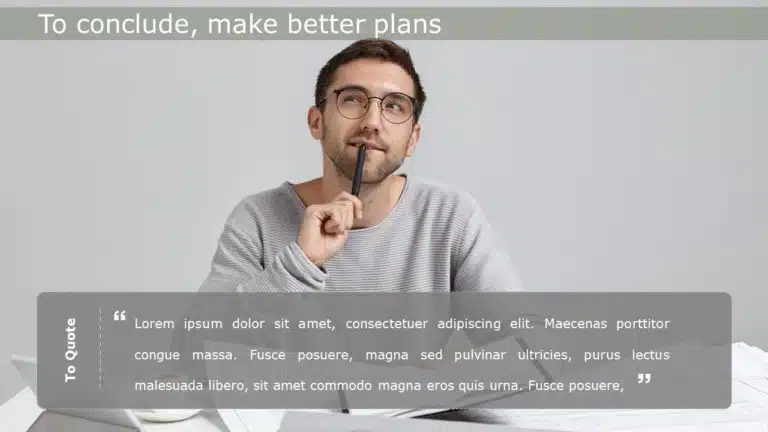
Instructional presentations provide step-by-step instructions on how to perform a task or complete a process.
These presentations are often used in training, education, and technical fields.
Whether you’re teaching a new software program, demonstrating a manufacturing process, or explaining a complex concept, instructional presentations can be an effective tool for breaking down information into digestible pieces.
Tips for Creating Effective Instructional Presentations
- Identify Your Objectives: Identifying your objective is important for an effective instructional presentation. This helps you to focus your presentation on the most critical information and ensure that you are meeting the needs of your audience.
- Keep It Simple: Use simple language, avoid technical jargon, and break down complex procedures into manageable steps.
- Provide Examples: Use real-world examples relevant to your audience and demonstrate how the concepts or procedures can be applied.
Inspirational presentations are those types of presentations that aim to motivate, inspire, and uplift the audience. These presentation types are often used in business, education, and personal development.
These presentations are meant to help the audience see things from a new perspective, feel empowered to take action, and believe in their ability to make positive life changes.
Tips for Creating Effective Inspirational Presentations
- Use Personal Stories: Personal stories can help connect with the audience personally and inspire them to take action. Share your own experiences and struggles, and demonstrate how you overcame challenges and achieved success.
- Use Quotes and Examples: Using quotes and examples can help to reinforce your message and inspire the audience. Use quotes from influential personalities and provide examples of successful individuals who have achieved their goals.
- Provide Actionable Steps: Provide specific steps for the audience to achieve their goals and overcome challenges.
As the name suggests, entertaining presentations are meant to engage and captivate the audience with humor, storytelling, or other entertaining elements.
The primary goal of this type of presentation is to entertain the audience, leaving a lasting impression and making the presentation memorable.
Different types of PowerPoint presentations have specific goals, and entertaining presentations are often used in settings such as events, social gatherings, etc.
Tips for Creating Effective Entertaining Presentations
- Use Humor: Humor is a powerful tool that helps to engage and entertain the audience. Use jokes, puns, and witty remarks to add a touch of humor to your presentation.
- Tell a story: Use anecdotes, personal experiences, or fictional stories to create a narrative the audience can relate to.
- Use interactive elements: Incorporating interactive elements such as quizzes, polls, and games can effectively interrupt the monotony of the presentation and enhance audience engagement. Use these elements to encourage audience participation and create a more dynamic experience.
- Practice timing: Timing is everything when it comes to entertaining presentations. Make sure your presentation is well-timed, and avoid going over time, as this can disrupt the flow of the presentation and cause the audience to lose interest.
- Engage the audience: Engage the audience throughout the presentation by asking questions, encouraging participation, and creating a relaxed and enjoyable atmosphere.
READ MORE: 10 Practical Ways To Improve Your Presentation Skills Today
Wrapping It Up
Understanding the different kinds of presentations is crucial for delivering an impactful and compelling message. By knowing the forms of presentation and their specific goals, you can tailor your content and delivery to achieve your desired outcome.
Whether you’re looking to inform, demonstrate, persuade, instruct, inspire, or entertain, the key is to know your audience and engage them through your content and delivery. By implementing the tips for each type of presentation, you can create a powerful and engaging presentation that leaves a lasting impression.
Remember, practice makes perfect. Take the time to rehearse and refine your presentation to ensure you deliver it confidently and clearly.
People Are Also Reading:
- PowerPoint Presentation Tips: How To Make A Good PowerPoint Presentation
- 9 Best Presentation Ideas That Your Viewers Will Adore
3 Most Important Presentation Tips To Make Your Presentation StandOut
How to make a presentation: a comprehensive guide.
- How To Start A Presentation: Make A Strong First Impression
Table Of Content
Related posts from the same category.
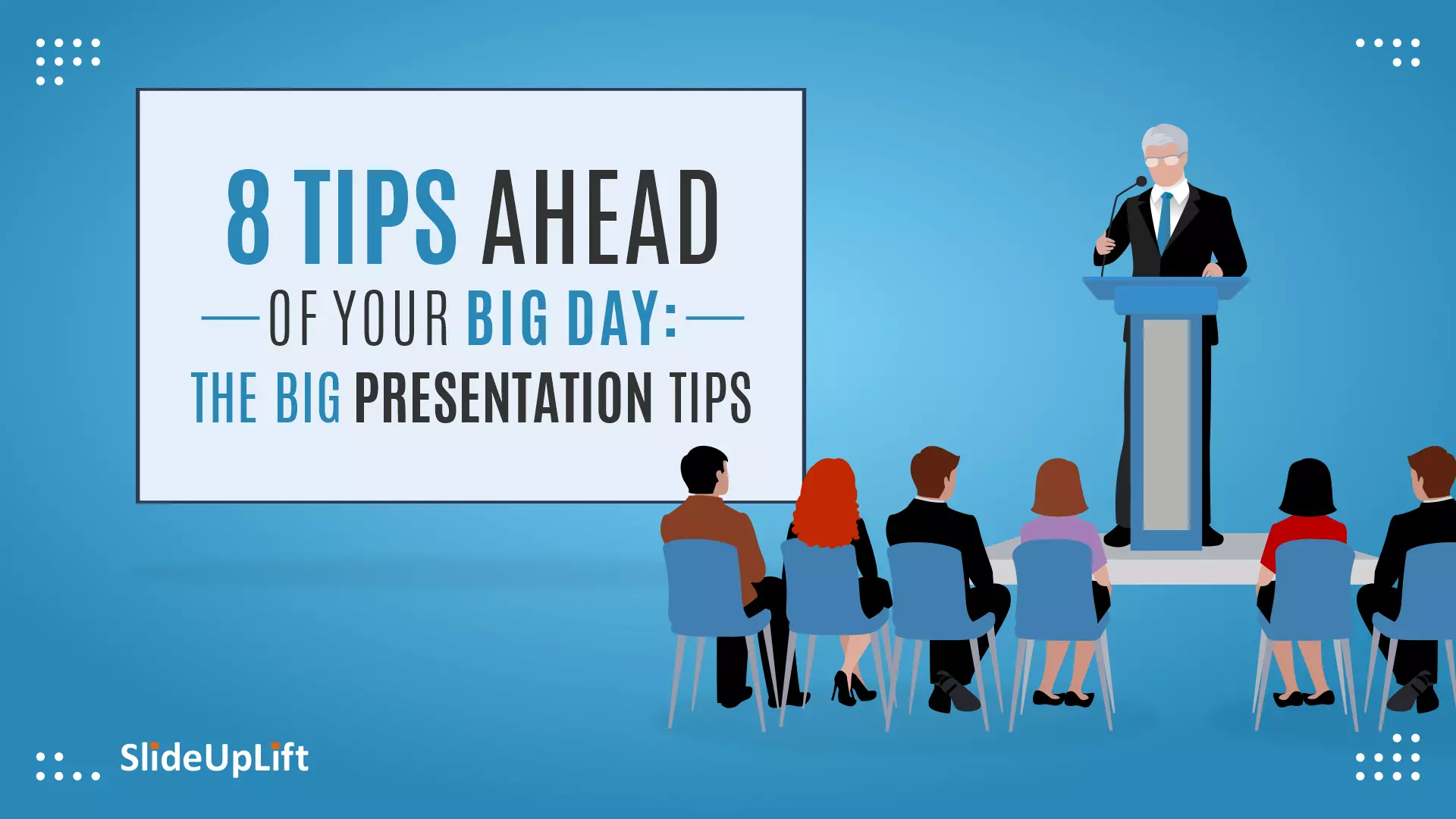
3 Feb, 2022 | SlideUpLift
8 Tips Ahead Of Your Big Day: The Big Presentation Tips
Are you preparing for your next big presentation? Aside from preparing, writing, and practicing your speech, there are certain other actions you should do to ensure you are truly prepared

12 Jun, 2018 | SlideUpLift
Microsoft PowerPoint Shortcuts That You Didn’t Know
PowerPoint is nothing short of a phenomenal tool when it comes to building business presentations. If you have been a regular PowerPoint user, you would already know that it has

10 Nov, 2021 | SlideUpLift
PowerPoint Presentation Tips: How to Make a Good PowerPoint Presentation
A well-crafted PowerPoint presentation can have a lasting impact on your audience. However, creating an effective presentation can be daunting, especially if you are unsure how to make it engaging
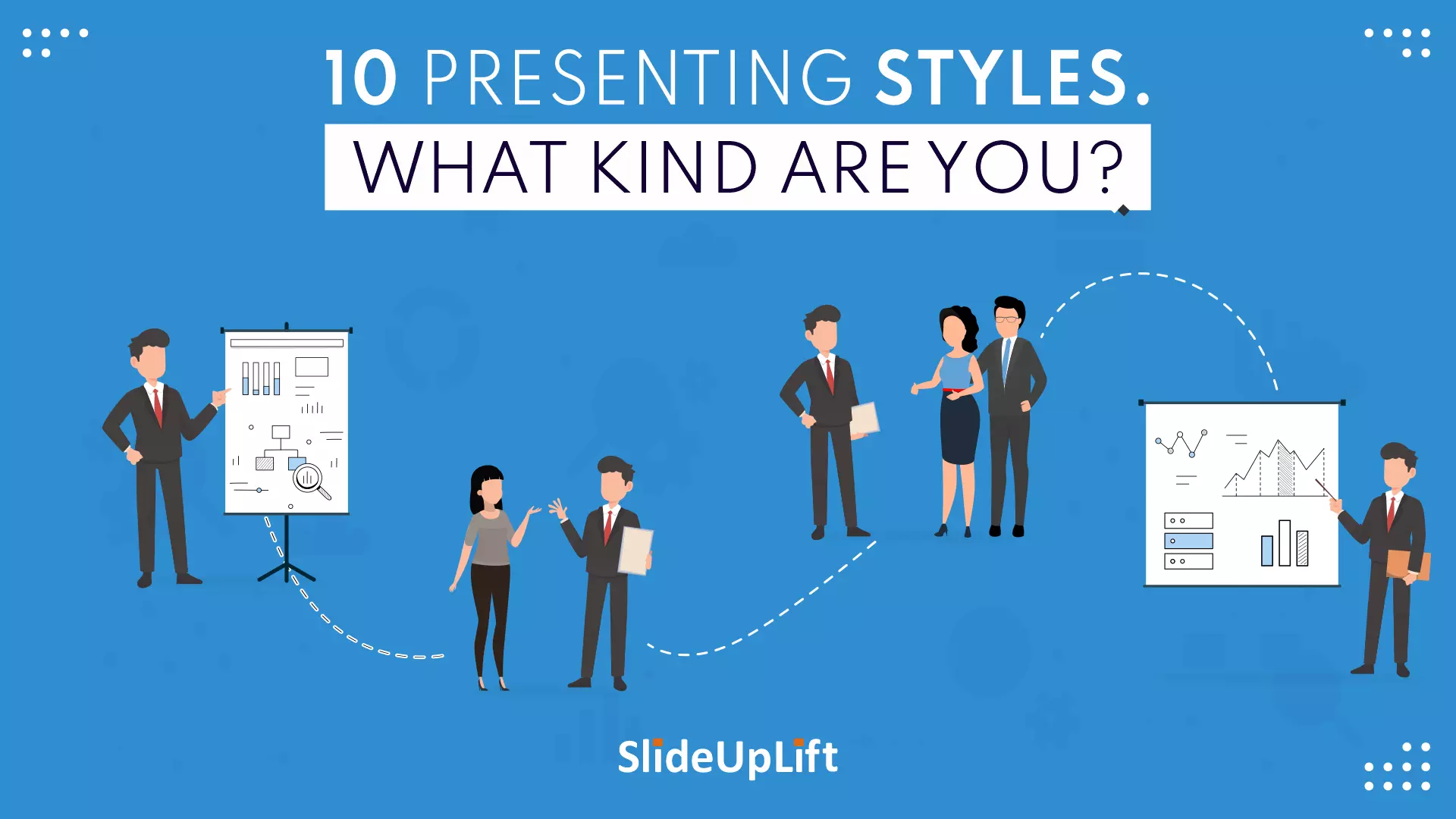
8 Feb, 2022 | SlideUpLift
Ten Presenting Styles : What Kind Are You?
Do you feel nervous when it comes to public speaking? Don’t worry; you’re not alone. Do you know that according to research, one of the biggest phobias in 2014 was
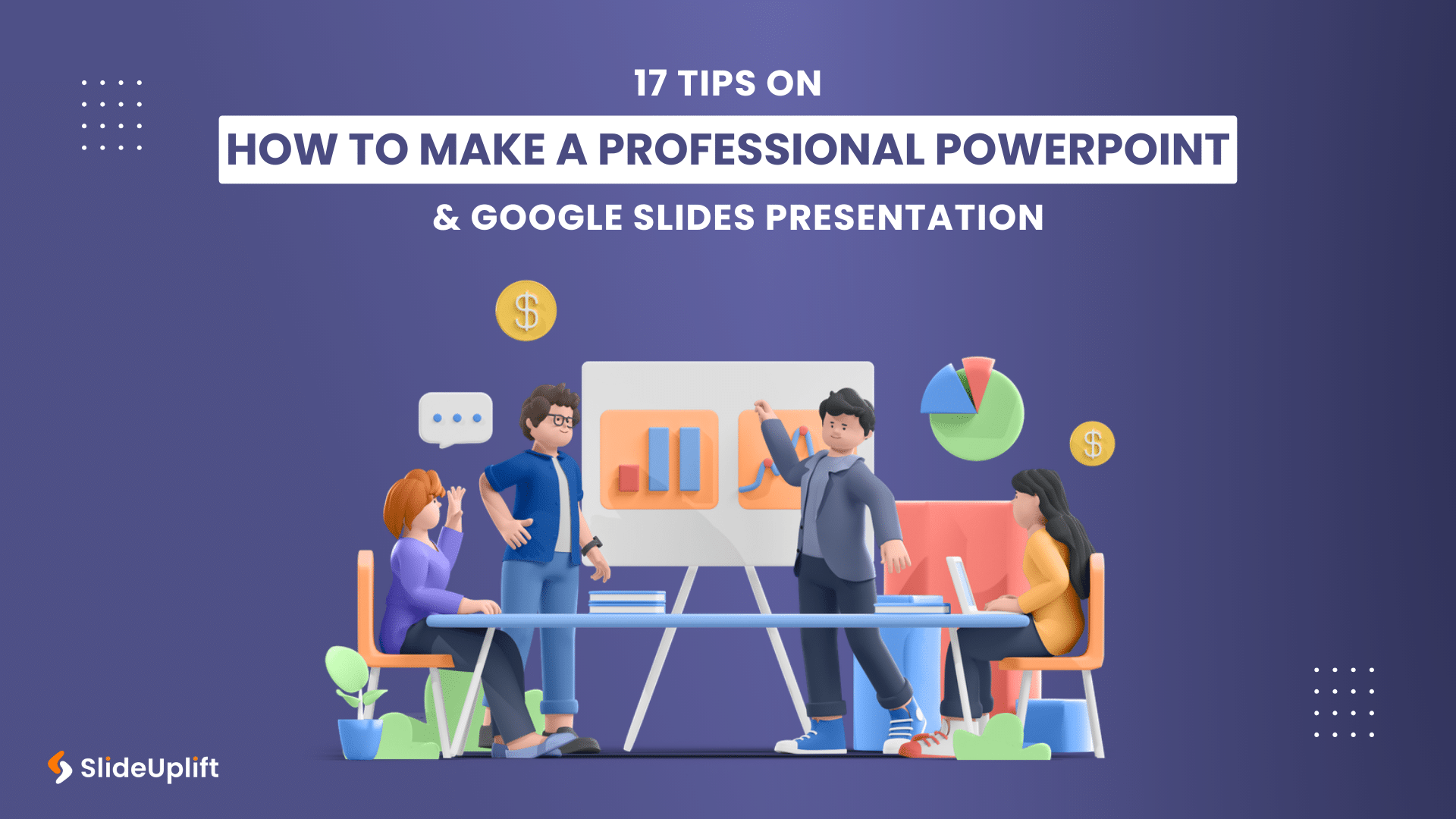
24 Apr, 2024 | SlideUpLift
17 Tips On How To Make A Professional PowerPoint & Google Slides Presentation
A PowerPoint presentation is a fantastic tool for communicating vital information. Even though people think it's simple to put all your content together and make a presentation, arranging and preparing

25 Mar, 2019 | SlideUpLift
PowerPoint Hacks You Did Not Know For Effective Presentations
Being a consultant to professionals for creating the perfect business presentations, we have come across a vast multitude of issues faced by clients on a regular basis. The deep experience

20 Aug, 2021 | SlideUpLift
Storytelling Tips to Change the Way You Present Ideas
A piece of oft-given advice surrounding making presentations is that in order to engage an audience, your presentation and speech need to have a narrative. And we wholeheartedly agree with

2 Jul, 2020 | SlideUpLift
Building an effective PowerPoint presentation is part art and part science. This article discusses the three most important PowerPoint presentation tips that form the basis of every successful presentation. In

14 Feb, 2023 | SlideUpLift
Are you tired of mediocre presentations that leave your audience bored and uninterested? Presentations are a crucial aspect of communication in the modern world, whether in the workplace, school, or

2 Aug, 2021 | SlideUpLift
Public Speaking Demystified: Tips To Successful Workplace Communication
We live in a world where we are overwhelmed with content, and communicating information effectively to others is more important today than ever before. Public speaking is a great way
Forgot Password?
Privacy Overview
Necessary cookies are absolutely essential for the website to function properly. This category only includes cookies that ensures basic functionalities and security features of the website. These cookies do not store any personal information
Any cookies that may not be particularly necessary for the website to function and is used specifically to collect user personal data via ads, other embedded contents are termed as non-necessary cookies. It is mandatory to procure user consent prior to running these cookies on your website.
PowerPoint.Guru
Types of Presentations

Presentations can be called ideal objects for visualizing ideas. Slides allow you to focus on important things in more detail or discuss complex things. There are usually some types of visuals for presentations that are extremely effective in illustrating the relationships between things and processes. You can use images, text, drawings, graphs, charts, and screenshots when creating slides. But how to design a presentation? What are the nuances you need to know before crafting slides? For starters, you should know the difference between presentation types.
Why Do You Need to Craft Slides?
There is a simple rule of storytelling: if you can't tell something, you have to show it! That is why people of different professions and fields of activity should use presentations. A set of slides greatly simplifies the visualization and systematization of various information nuances. In addition, presentations are a great addition to public speaking, reporting, or academic debates.
Presentations: Types of Slides and Their Purpose
Any presentation is not just a set of slides. Instead, your goal is to keep important aspects related to the general topic, goals, and ideas. But how to design a presentation? And where to start in the first place? To begin with, you should pay attention to the types of presentations and their purpose. Such knowledge will give you the key to further action.
Presentations for Business
Your presentation graphic design will be very different from standard slides. Much of the difference will come from the goals of your presentation. For example, a business needs clear statistics, direct answers, and slide control. Here are the types of presentations you should know.
As a rule, pitch deck presentations help young entrepreneurs get funding by showing business prospects. Such slides allow you to list your company's benefits, the number of new customers, or revenue growth over a certain period. In other words, each slide is a demonstration of your attractiveness in a commercial sense.
In addition, pitch deck presentations allow you to present to investors the project team, new talented employees, or growth paths that will become real by investing in your project. In some way, such a presentation is analogous to a shop window where representatives of business structures can see the most important things.
Sales Presentation
Imagine that your company has been successful for a certain period. Surely you need details to report to investors or the project team. That is why you need a sales presentation because it can show how profitable and effective the period of the company's activity was through such a presentation. For example, you can show the gross income, operating profit, the growth rate of your product, and other information.
Sometimes such a sales presentation aims to promote new teams within the company based on the statistics of the goods or services provided. You can also add selling propositions, pricing information, testimonials, and other things that will show the positive growth dynamics of your company.
Marketing Presentations
Most marketing presentations consist of slides designed to promote products and services. Your goal as a presentation creator is to find effective ways to promote your sales pitch. For example, you must show how profitable cooperation with you is or how good your products or services are.
As a rule, marketing presentations contain graphic elements designed to create a solid image and reputation of a good company worth trusting. That is why you should choose bright facts that allow you to gather a loyal audience. Also, such slides may include future business plans or goals that can be implemented through certain actions.
30-60-90 Day Plan
Many people who want a good position in any company should create a 30-60-90 day plan. So this is a strategic action plan for thirty, sixty, and ninety days. In other words, you must show what you intend to do in a new position to justify your trust.
In a way, your 30-60-90 day plan is a manifesto and a demonstration of your ambitions. Showing the action plan on slides demonstrates the steps you are ready to take and the tools you use to implement all the ideas. In addition, such a presentation aims to achieve loyalty among the company owners or top managers.
Business Plan
And here is the most important type of presentation for startups. Your business plan is a step forward to attract investors and show the prospects of your ideas and the possibilities of their implementation. Moreover, you are selling an idea that will become a reality if someone gives you money.
In addition, a business plan is a type of presentation that should show the niche you want to occupy. Perhaps you should also point out your competitors and the ways you are using to leave them far behind. As a rule, such presentations should be concise and provide the final audience with a summary of the prospects for your business.
Budget Presentations
Most startups and companies need budget presentations, as they allow you to determine the appropriateness of certain financial flows. In addition, slides with data are needed to visualize spending on payroll projects and purchasing goods and services. In other words, most financial processes can be visualized through the presentation.
Let's say the company's management wants to optimize the costs of managing subsidiaries and decides to hold a meeting. With detailed budget presentations, they can quickly consolidate their focus on those transactions that can be reduced in number.
Slides for Teachers
Presentation graphic design can be especially amazing if you are a teacher. Your task is to prepare for classes and create a comfortable springboard for students ready to gain knowledge. That is why every slide must be polished. Here are examples to help you learn more.
Lecture Presentation
Many teachers must create slides to visualize information and a springboard for academic activities. For example, a good lecture presentation allows you to focus on certain facts, terms, or research results. In other words, slides are vital for visualizing important lecture facts. The lecture presentation has a classical academic structure, graphs, images, tables, and diagrams.
Course Presentation
Each course presentation is a set of slides vital to condense a piece of learning content in a structured and interactive format. All slides are based on information relevant to the main topic. In addition, the course presentation should contain key ideas, goals, and tools to achieve them. In general, these are academic slides that make it extremely easy to visualize the tasks of your course.
Lessons Plan Presentation
Teachers must craft lessons plan presentation weekly to interact more effectively with students. As a rule, such a set of slides allows young people to learn more about what information they will receive during the lesson. In addition, the lessons plan presentation is a springboard for teachers who do not want to forget important details while explaining new topics.
Research Presentation
Typically, the average research presentation includes a short intro, your hypotheses, a brief description of the methods, and graphs related to your findings. Here you will interpret the data and be able to show how valuable your finds turned out to be. As a rule, any research presentation is a springboard that helps students understand exactly how students should approach the visualization of the results of their work.
Interactive Planner
Sometimes your main goal may be to create a so-called interactive planner. So this is a presentation, the purpose of which is to create a systematic approach to the company's development. It is all about the visualization of goals that can be changed in the future. In other words, your interactive planner is a set of slides aimed at systematically analyzing a business or individual goals in the context of a common (global) idea.

Case Presentation
As a rule, any case presentation is a way of interaction between the professor and the audience. Such a set of slides allows you to organize the most important information related to the academic or medical process. In other words, your case presentation is a way to tailor complex terms and key data to the needs of a specific audience.
For Students
Every student should know how to design presentation slides right. But your slides' type and visual style depend on your academic assignment. Here are the most popular presentation types you should know about.
Thesis Presentation
As a rule, creating a solid thesis presentation can take time. The fact is that such a set of slides should describe in detail the goals, research methods, and results of your work. Each thesis presentation slide is a brick that forms a solid wall of information relevant to your topic. Here you can add graphs, charts, images, and tables to visualize in detail the work you have done.
Dissertation Defense Presentations
While writing your dissertation, you must prepare data to defend your position and research. Typically, you will need to create data comparison slides, research graphs, and visual patterns to help build a base for your judgments. So this is why dissertation defense presentations are so important. They should become a mix of your ideas and an auxiliary source for your speech. Try to sort your slides according to the order of your paragraphs. And do not forget about the data you will use during your performance. That is why dissertation defense presentations should copy the general paper structure.
Research Paper Presentation
Imagine that you have to write a research paper and craft a dozen slides to support your idea. Usually, a research paper presentation is a basis that is needed to emphasize certain parts of your paper. As a rule, students must craft 10-15 slides with background information, key ideas, results, and data interpretation. In other words, your research paper presentation is important for you and your professor, who will probably analyze the results of your work.
Admission Presentation
As a rule, each first-year student must create an admission presentation as an addition to the essay. This work is part of the admission process to show that the future student is worthy of becoming part of the academic community. Usually, the average admission presentation is a set of slides that contain key ideas, goals, ambitions, and sources of your inspiration. Plus, colleges and universities don't have strict formatting and style requirements, so you can craft your slides to suit your inspiration.
Presentation Design Tips: Everything You Need to Know About Slides
Surely you want to craft your slides well and stick to certain rules. That is why you should check out these design tips for presentations. Read each tip carefully, and you will surely be able to create a good presentation.
1. Stay Away From Bullet Points
The bullet points aren't necessary. Moreover, they can turn an original presentation into a trivial PowerPoint template. Instead, list important aspects of your presentation using the paragraph form. Such a presentation graphic design idea will allow you to stick to the original approach and say no to the boring enumeration of dozens of parameters. Try to keep your slides lighter regarding the amount of content on the page.
2. Insert a Single Animation Style
The animation style is important for storytelling because your audience should not be distracted from key information. In addition, different animation styles when switching slides can confuse your audience. Try to choose only animations that work and look natural. Surely you are not interested in visual effects that will lead to total design presentation failure.
3. Highlight Key Points
Try to use shapes, bright fonts, or characters pointing to put a visual emphasis on some piece of information. This strategy is extremely effective as it allows you to focus your audience's attention on the things that matter most. In addition, highlighting key data using graphic elements helps to prioritize zones and makes it easier to perceive any information.
4. Incorporate Data Visualization
Data visualization is what you need to make your presentation look solid. Use pie charts, bar charts, graphs, and other types of content that allow your audience to understand certain nuances quickly. For example, you can add a percentage pie chart describing the percentage of people who do not subscribe to streaming services. Visualization is the key to simplicity and elegance.
5. Keep Your Slide Design Consistent
You may love variety and vibrant color combinations, but your presentation needs to be solid. Keep your slide design consistent, and you'll see how much better your visual style will get. Use the same fonts, color elements, and data visualization types. This approach is extremely important for those who want to achieve effective presentations.
6. Break Up Sections
One of the key secrets is to break up sections. This strategy allows you to separate important information blocks and prepare your audience for new slides. For example, use blank slides with pictures, large print for subtitles, or even short videos. Your visual content should create a clear transition that will help the audience prepare for a new block of slides ahead of time.
7. Limit A Single Takeaway Per Slide
Some people like to create 3-5 slide presentations and add a few paragraphs to each page. But such a strategy is not profitable in advance since it will be difficult for your audience to focus on important things. So instead, center all your text and visuals around one takeaway or idea. First, this strategy will allow you to make each slide lighter and more visually appealing. Secondly, each page will be like one of the chain links that look monolithic.
Final Words
As you can see, there are quite a few types of presentations depending on the goals you are pursuing. Knowing a clear differentiation and approach to create each slide will help you stand out from the crowd and craft something special. And don't forget about tips to help you avoid common mistakes. Many ideas are simple enough that you won't have to analyze them for long.

Keynote vs Powerpoint

Presentation design techniques

Types of presentations
We use essential cookies to make Venngage work. By clicking “Accept All Cookies”, you agree to the storing of cookies on your device to enhance site navigation, analyze site usage, and assist in our marketing efforts.
Manage Cookies
Cookies and similar technologies collect certain information about how you’re using our website. Some of them are essential, and without them you wouldn’t be able to use Venngage. But others are optional, and you get to choose whether we use them or not.
Strictly Necessary Cookies
These cookies are always on, as they’re essential for making Venngage work, and making it safe. Without these cookies, services you’ve asked for can’t be provided.
Show cookie providers
- Google Login
Functionality Cookies
These cookies help us provide enhanced functionality and personalisation, and remember your settings. They may be set by us or by third party providers.
Performance Cookies
These cookies help us analyze how many people are using Venngage, where they come from and how they're using it. If you opt out of these cookies, we can’t get feedback to make Venngage better for you and all our users.
- Google Analytics
Targeting Cookies
These cookies are set by our advertising partners to track your activity and show you relevant Venngage ads on other sites as you browse the internet.
- Google Tag Manager
- Infographics
- Daily Infographics
- Popular Templates
- Accessibility
- Graphic Design
- Graphs and Charts
- Data Visualization
- Human Resources
- Beginner Guides
Blog Data Visualization 18 Presentation Design Tips For Success
18 Presentation Design Tips For Success
Written by: Midori Nediger May 15, 2023

Bad presentations. We’ve all had to sit through them. Heck, we’ve probably all given one or two. I know I have.
You know the type: twice as long as they need to be, slides chock-full of text, no visuals in sight.
How can you ensure you don’t fall victim to these presentation faux-pas when designing your next presentation for your team, class, or clients?
In this blog, I’ll walk you through tips on how to design an impactful presentation along with presentation templates that can help you deliver it with style to leave a lasting impression.
Tips for designing and delivering an impactful presentation
What makes a presentation memorable?
It usually comes down to three things:
- The main idea.
- The presenter.
- The visuals.
All three elements work together to create a successful presentation. Just like how different presentation styles serve different purposes, having a good presentation idea will give the audience a purpose for listening.
Here are some top tips to consider to help you design and deliver an impactful presentation:
- Include less text and more visuals in your presentation design
- Identify one core message to center your presentation design around
- Eliminate any information that doesn’t immediately support the core message
- Create a strong presentation outline to keep you focused
- Use text to reinforce, not repeat, what you’re saying
- Design your presentation with one major takeaway per slide
- Use visuals to highlight the key message on each slide
- Use scaffolding slides to orient your audience and keep them engaged
- Use text size, weight, and color for emphasis
- Apply design choices consistently to avoid distraction
- Split a group presentation by topic
- Use a variety of page layouts to maintain your audience’s interest
- Use presentation templates to help you get started
- Include examples of inspiring people
- Dedicate slides to poignant questions
- Find quotes that will inspire your audience
- Emphasize key points with text and images
- Label your slides to prompt your memory
1. Include less text and more visuals in your presentation design
According to David Paradi’s annual presentation survey , the 3 things that annoy audiences most about presentations are:
- Speakers reading their slides
- Slides that include full sentences of text
- Text that is too small to read
The common thread that ties all of these presentation annoyances is text. Audiences are very picky about the text found in presentation slide decks .
In my experiences speaking at conferences and in webinars over the past few years, audiences respond much more positively to presentations that use visuals in place of text.
Audiences are more engaged, ask more questions, and find my talks more memorable when I include lots of visual examples in my slide decks.
I’m not the only one who has found this. We recently surveyed nearly 400 conference speakers about their presentation designs and found that 84.3% create presentations that are highly visual.
A great example of a high visual presentation is the iconic AirBnB pitch deck design , which includes no more than 40 words per slide. Instead of repeating the speaker’s script on the slides, it makes an impact with keywords, large numbers, and icons:

Learn how to customize this presentation template:
To help you take your presentations to the next level, I’d like to share my process for creating a visually-focused presentation like the one above. I’ll give you my top presentation design tips that I’ve learned over years of presenting:
- Class presentations
- Online courses
You can then apply this process to our professional presentation templates or pitch decks , creating unique presentation decks with ease! Our user-friendly editor tools make customizing these templates a breeze.
To leave a lasting impression on your audience, consider transforming your slides into an interactive presentation. Here are 15 interactive presentation ideas to enhance interactivity and engagement.
We’ll cover the most important steps for summarizing lengthy text into a presentation-friendly format. Then we’ll touch on some presentation design tips to help you get visual with your slide decks. Read on for the best creative presentation ideas .
2. Identify one core message to center your presentation design around
We know from David Paradi’s survey that audiences are easily overwhelmed with lots of text and data, especially when presentations are long.

(You when you see a presentation with lots of text and data and it’s long)
So unlike in a white paper , report , or essay , you can’t expect to tackle many complex ideas within a single presentation.
That would be a recipe for disaster.
Instead, identify a single central message that you would like to communicate to your audience. Then build your presentation around that core message.
By identifying that core message, you can ensure that everything you include in your presentation supports the goal of the presentation .
As seen below, a great presentation tells you exactly what you’re going to learn (the core message), then gets right to the facts (the supporting information).

To ensure you create an asset that’s clear, concise, impactful, and easy to follow, design your presentation around a single core message.
3. Create a strong presentation outline to keep you focused
Think of your outline as a roadmap for your presentation. Creating a strong presentation outline straight away helps make sure that you’re hitting all of the key points you need to cover to convey a persuasive presentation .
Take this presentation outline example:
- Introduction and hellos
- Vision and value proposition
- Financial profit
- Your investment
- Thanks and questions
These are all things that we know we need to talk about within the presentation.
Creating a presentation outline makes it much easier to know what to say when it comes to creating the actual presentation slides.
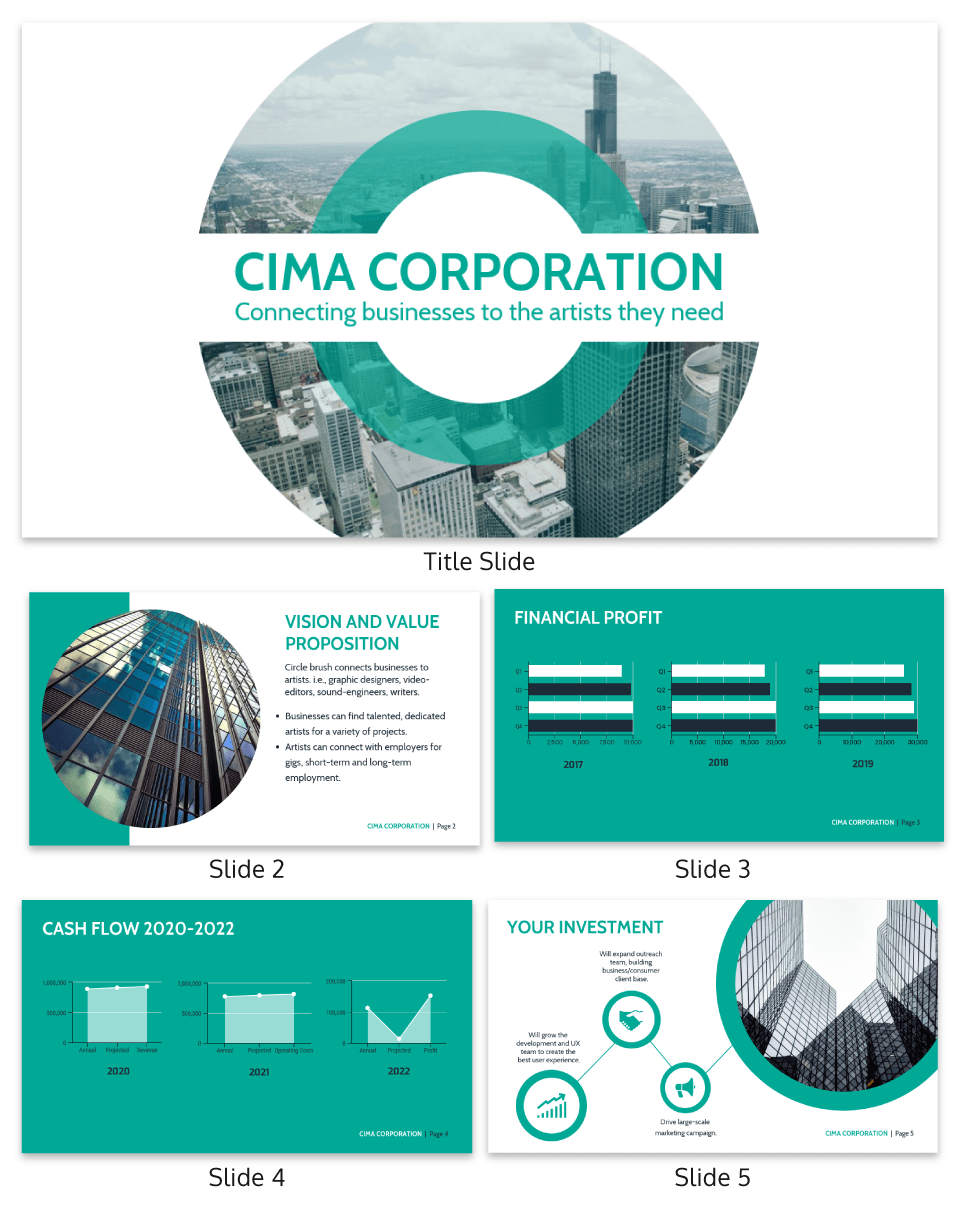
You could even include your presentation outline as a separate slide so that your audience knows what to expect:
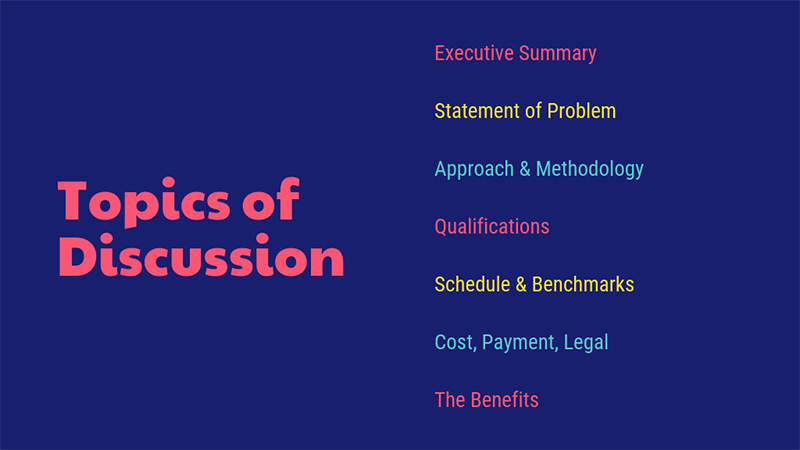
The opening moments of your presentation hold immense power – check out these 15 ways to start a presentation to set the stage and captivate your audience.
4. Eliminate any information that doesn’t support the core message
Next, use that core message to identify everything that doesn’t belong in the presentation.
Aim to eliminate everything that isn’t immediately relevant to the topic at hand, and anything remotely redundant. Cut any information that isn’t absolutely essential to understanding the core message.
By cutting these extra details, you can transform forgettable text-heavy slides:
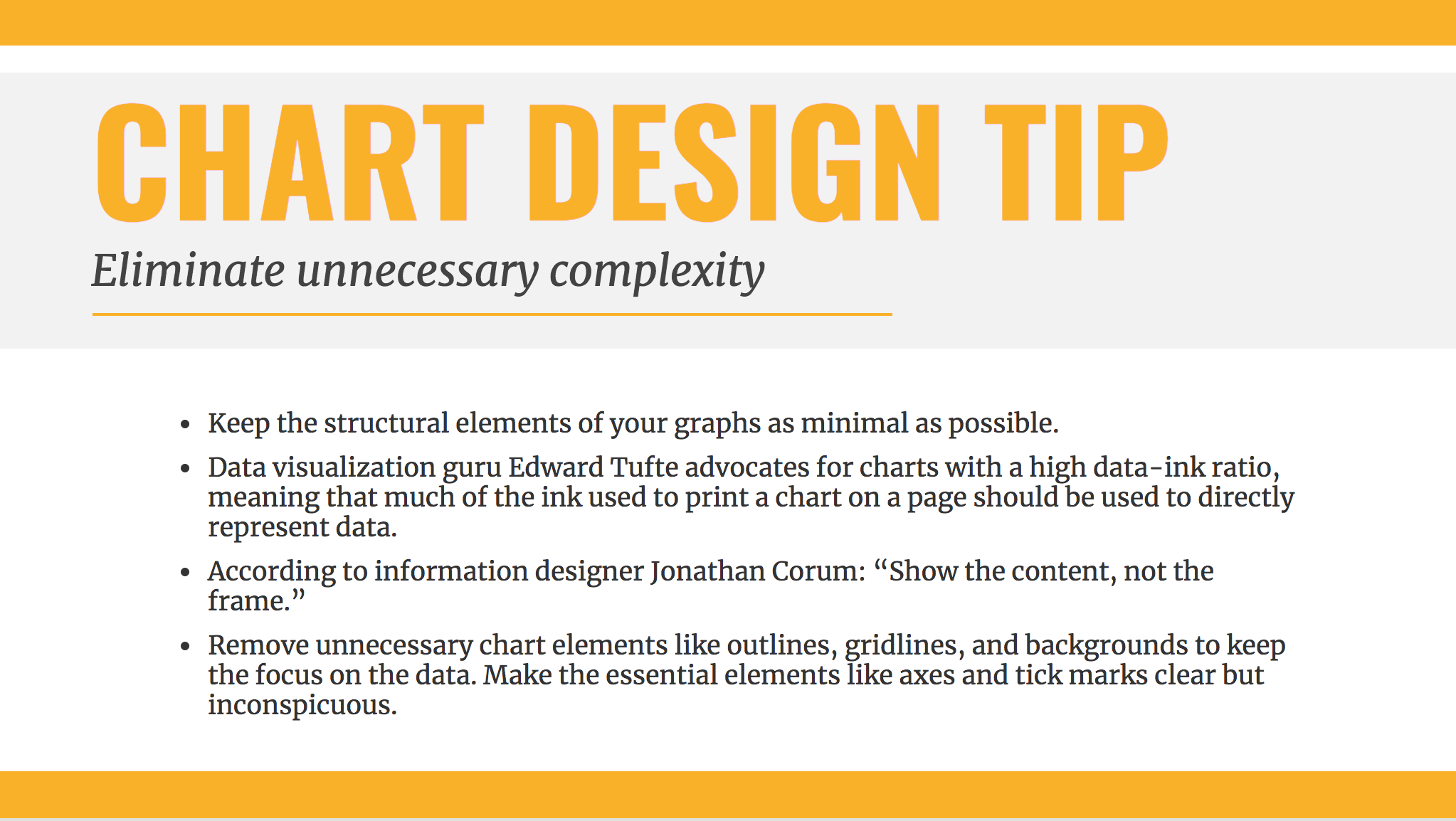
Into memorable slides with minimal text:
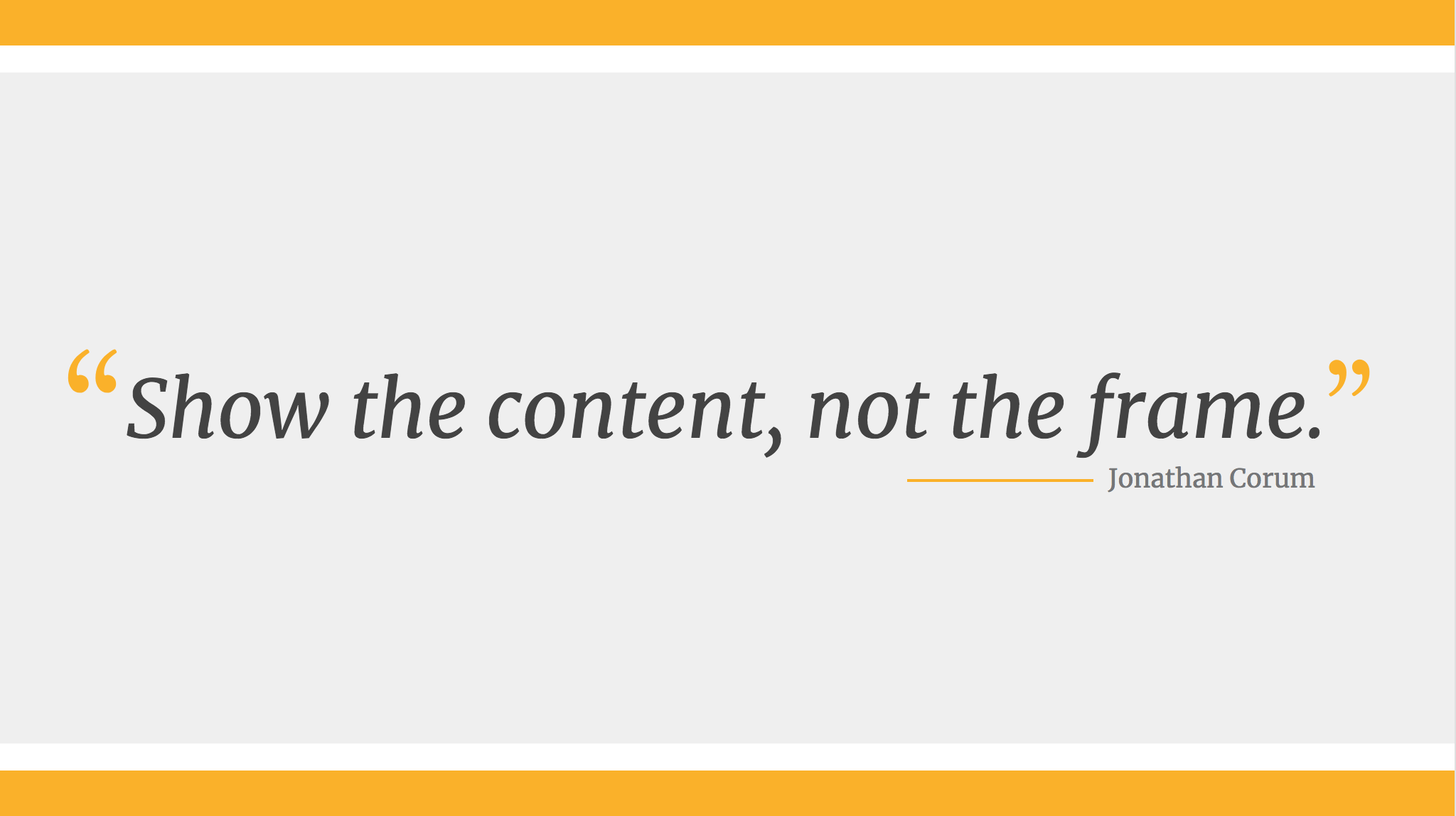
Here’s a quick checklist to help you cut out any extra detail:
Get rid of:
- Detailed descriptions
- Background information
- Redundant statements
- Explanations of common knowledge
- Persuasive facts and figures
- Illustrative examples
- Impactful quotes
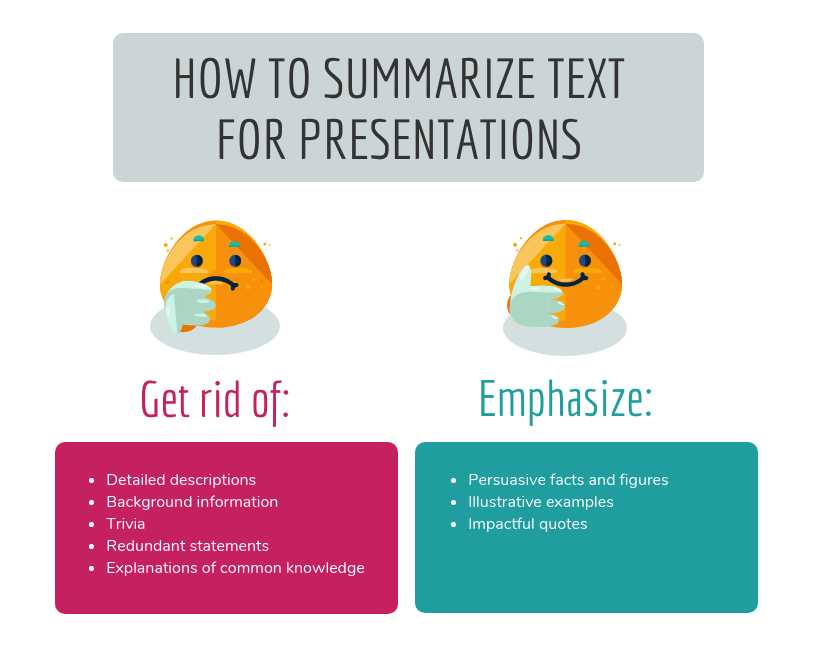
This step may seem obvious, but when you’re presenting on a topic that you’re passionate about, it’s easy to get carried away with extraneous detail. Use the recommendations above to keep your text in check.
Clarity is key, especially if you’re presenting virtually rather than in-person. However, Lisa Schneider (Chief Growth Officer at Merriam-Webster) has had plenty of experience making that adjustment. She recently shared her tips for adapting in-person presentations into virtual presentations on Venngage that you can check out.
Watch: How to design a presentation [10 ESSENTIAL TIPS]
5. Use text to reinforce, not repeat, what you’re saying
According to presentation guru Nancy Duarte , your audience should be able to discern the meaning of your slides in 6 seconds or less.
Since your audience will tend to read every word you place on each slide, you must keep your text to an absolute minimum. The text on your slides should provide support for what you’re saying without being distracting.
Never write out, word for word, what you’re going to be saying out loud. If you’re relying on text to remember certain points, resist the urge to cram them into your slides. Instead, use a tool like Venngage’s speaker notes to highlight particular talking points. These can be imported into PowerPoint — along with the rest of your presentation — and will only be viewable to you, not your audience.
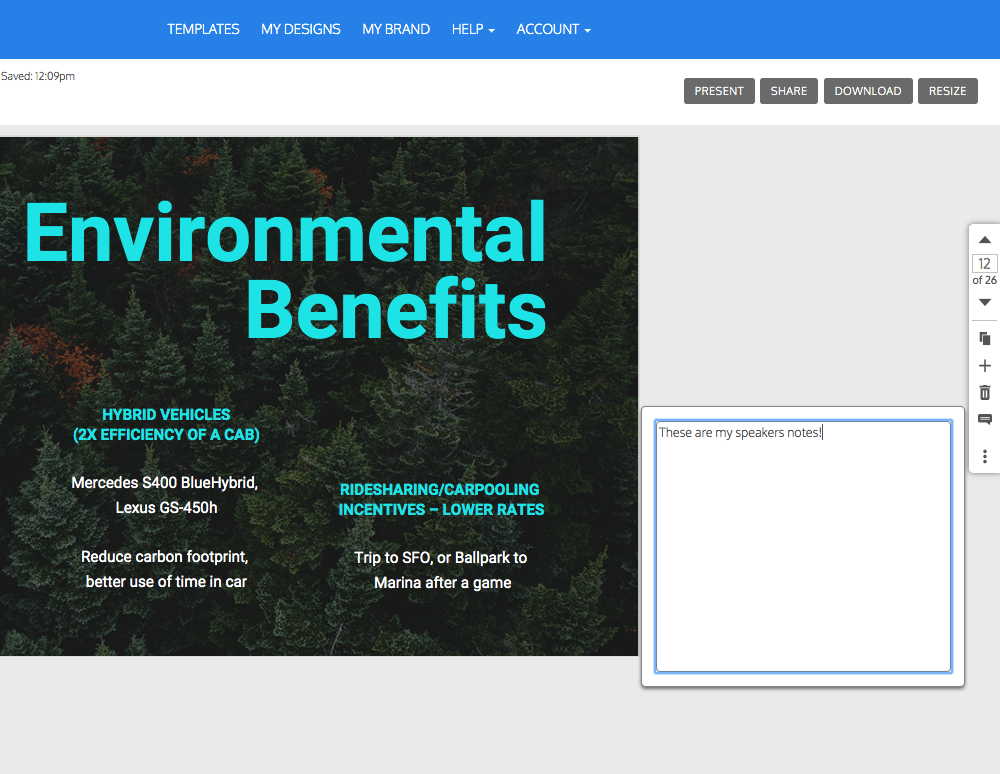
For the actual slides, text should only be used to reinforce what you’re saying. Like in the presentation design below, paraphrase long paragraphs into short bulleted lists or statements by eliminating adjectives and articles (like “the” and “a”).
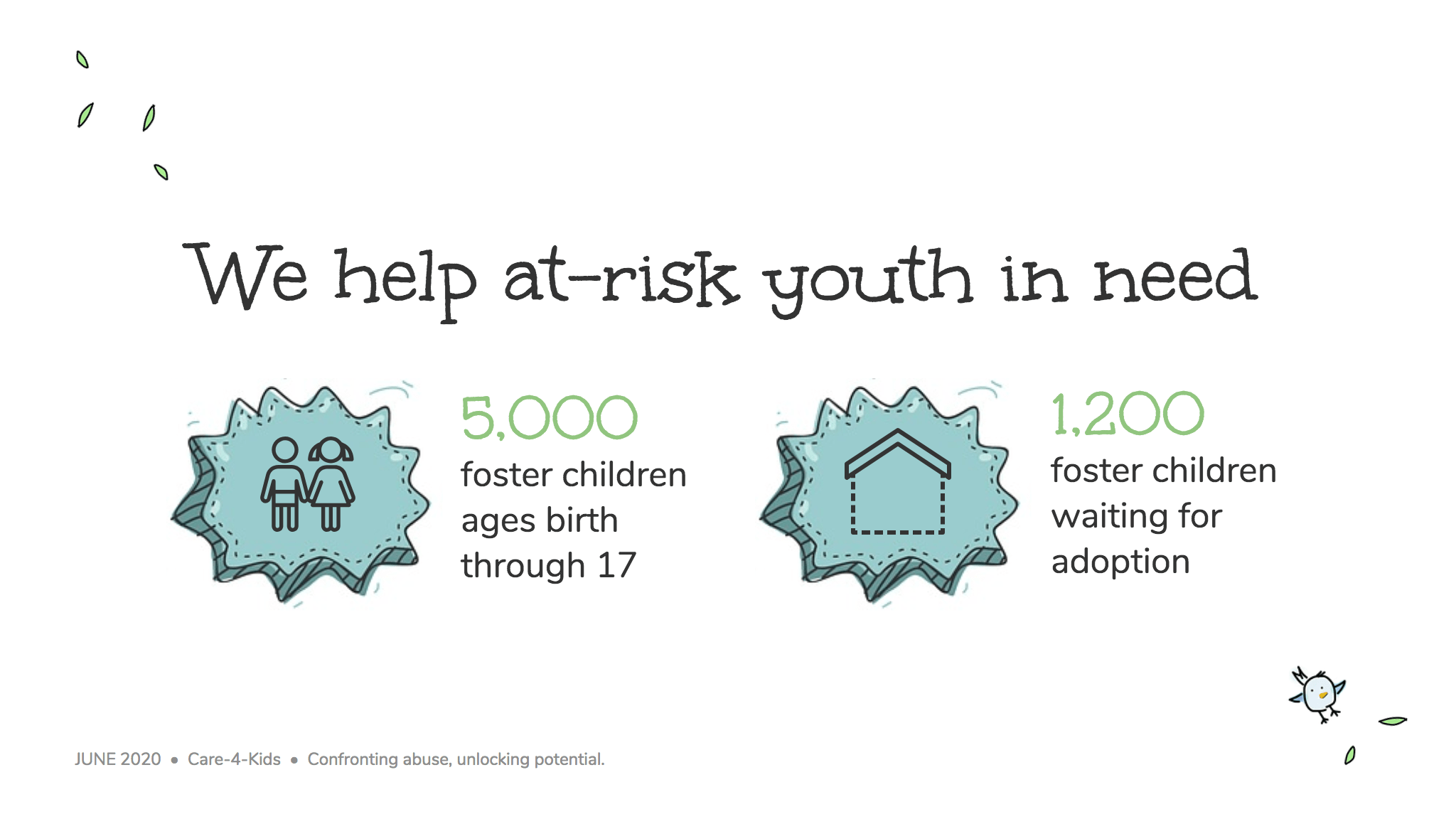
Pull out quotes and important numbers, and make them a focus of each slide.
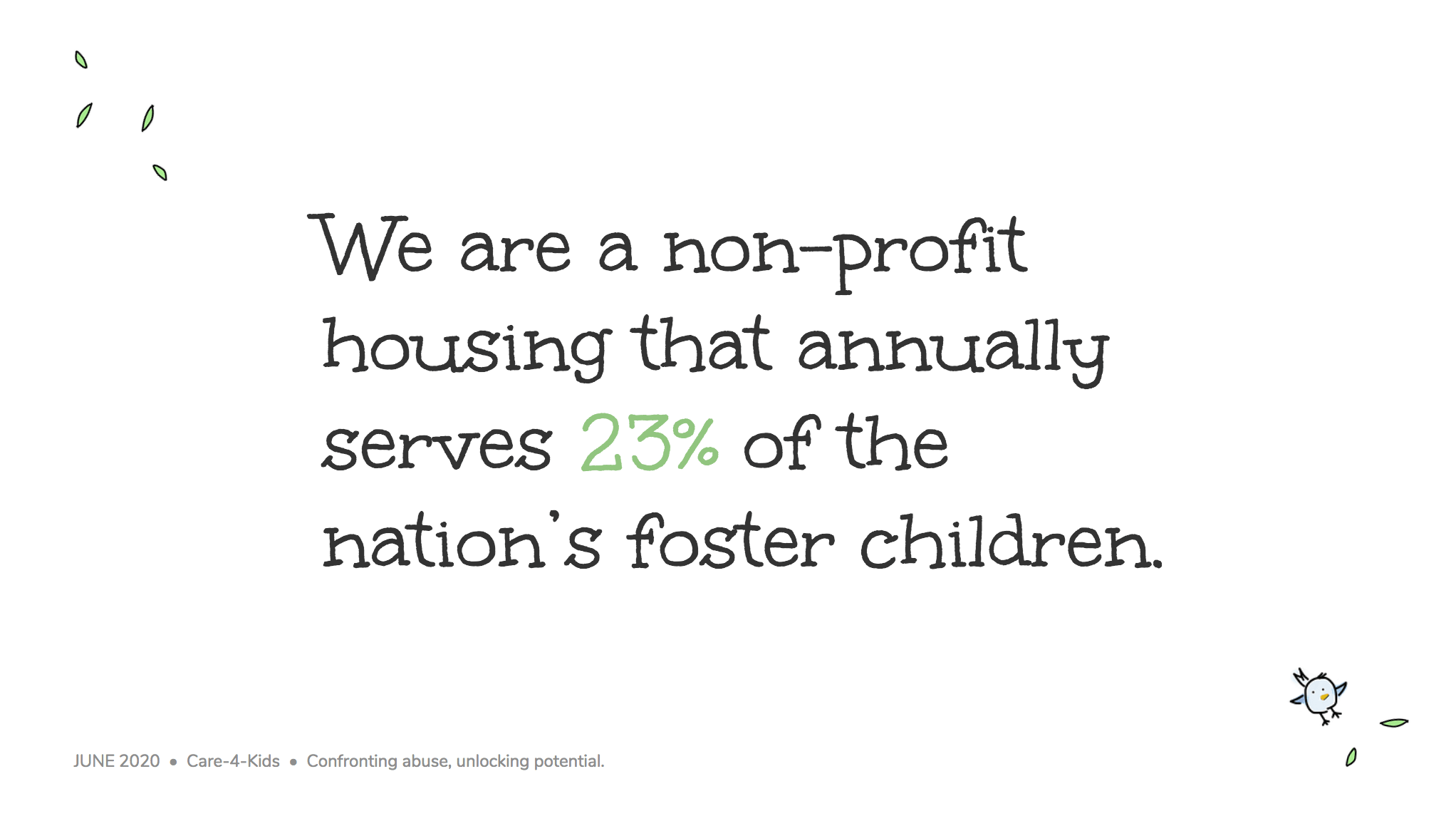
6. Design your presentation with one major takeaway per slide
As I mentioned above, audiences struggle when too much information is presented on a single slide.
To make sure you don’t overwhelm your audiences with too much information, spread out your content to cover one major takeaway per slide.
By limiting each slide to a single simple statement, you focus your audience’s attention on the topic at hand.
My favorite way to do this is to pick out the core message of whatever I’m talking about and express it in a few keywords, as seen in this presentation slide below.
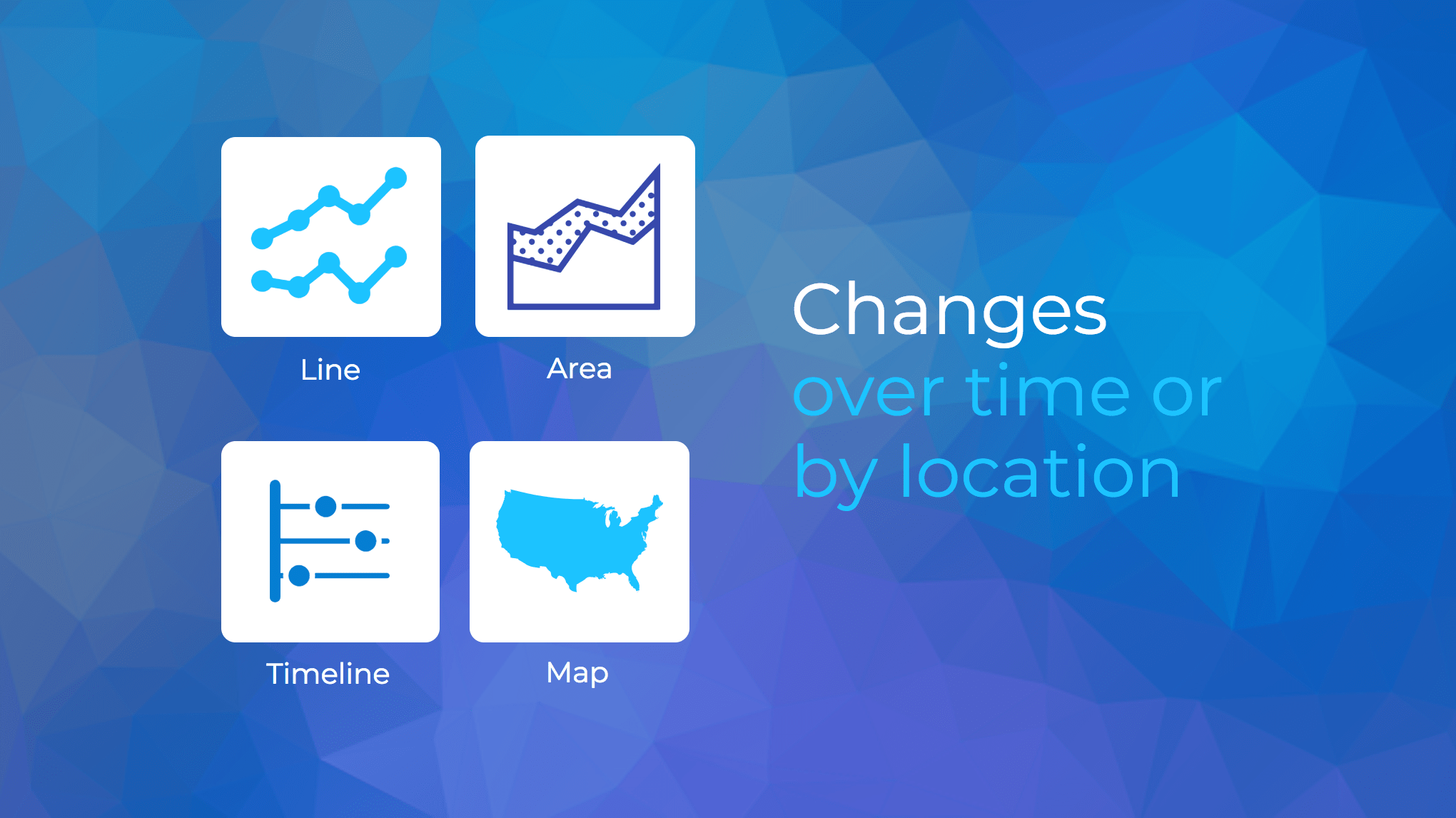
This helps ensure that the visuals remain the focus of the slide.
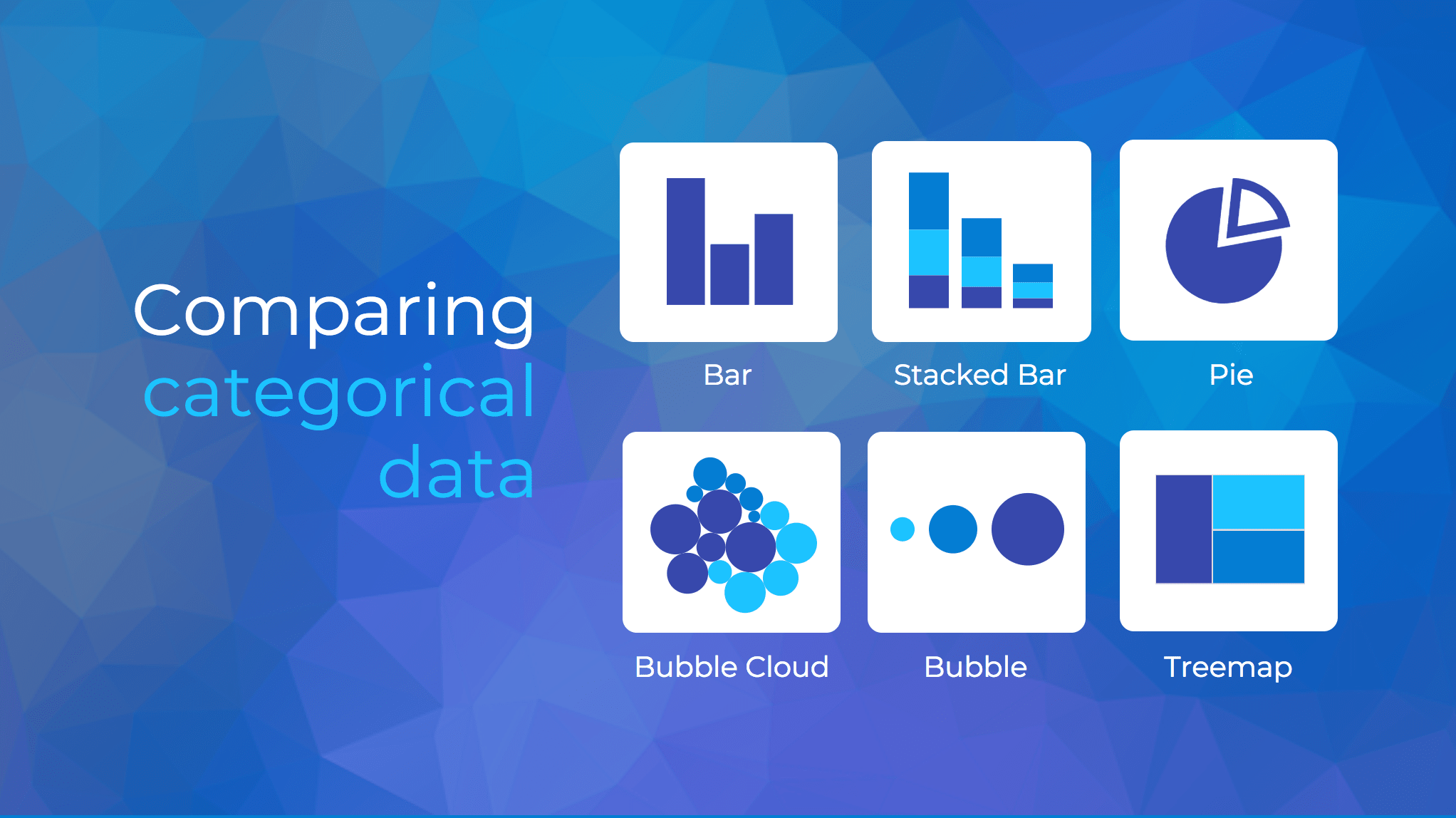
Using the text in this way, to simply state a single fact per slide, is a sure-fire way to make an impact in your presentation.
Alternatively, pull out a significant statistic that you want to stick in your audience’s minds and make it a visual focus of the slide, as seen in this popular presentation by Officevibe .
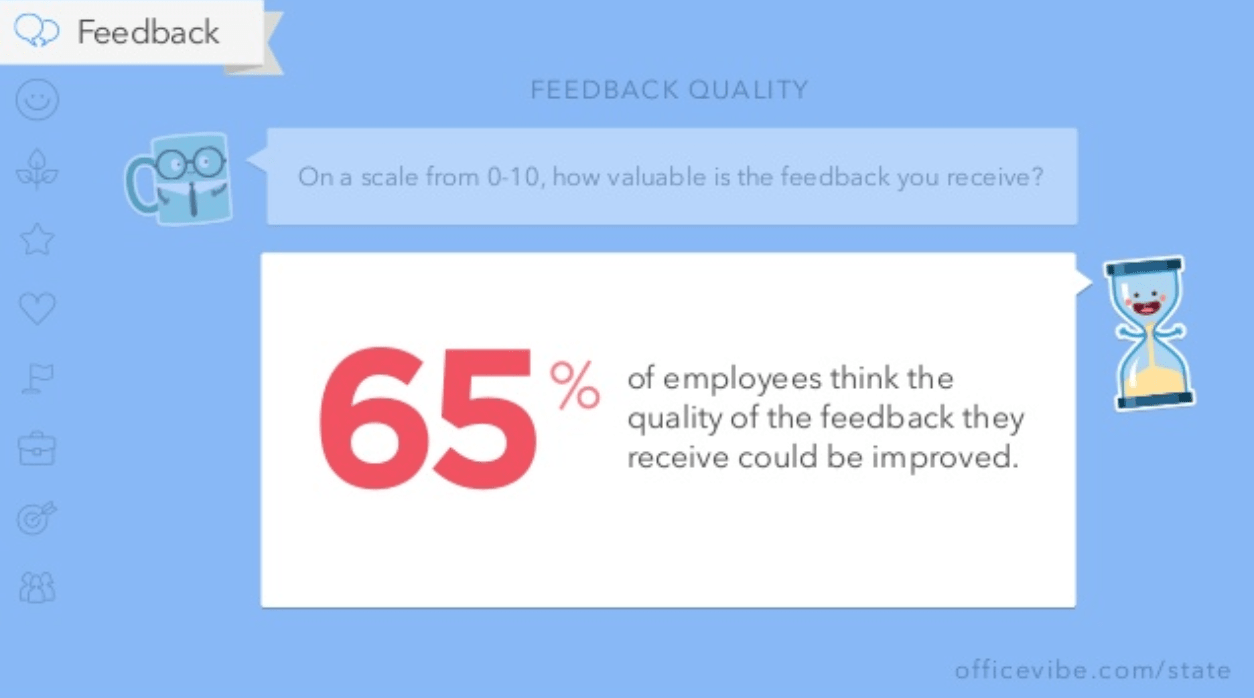
This might mean you end up with a slide deck with a ton of slides. But that’s totally ok!
I’ve talked to many professionals who are pressured by their management teams to create presentations with a specific number of slides (usually as few as 10 or 15 slides for a 30-minute presentation).
If you ask me, this approach is completely flawed. In my mind, the longer I spend sitting on a single slide, the more likely I am to lose the interest of my audience.
How many slides should I use for a 10 minute presentation?
A good rule of thumb is to have at least as many slides as minutes in your presentation. So for a 10 minute presentation you should have at least 10 slides .
Use as many slides as you need, as long as you are presenting a single message on each slide, (as seen in the lengthy presentation template below). This is especially important if you’re presenting your business, or delivering a product presentation. You want to wow your audience, not bore them.
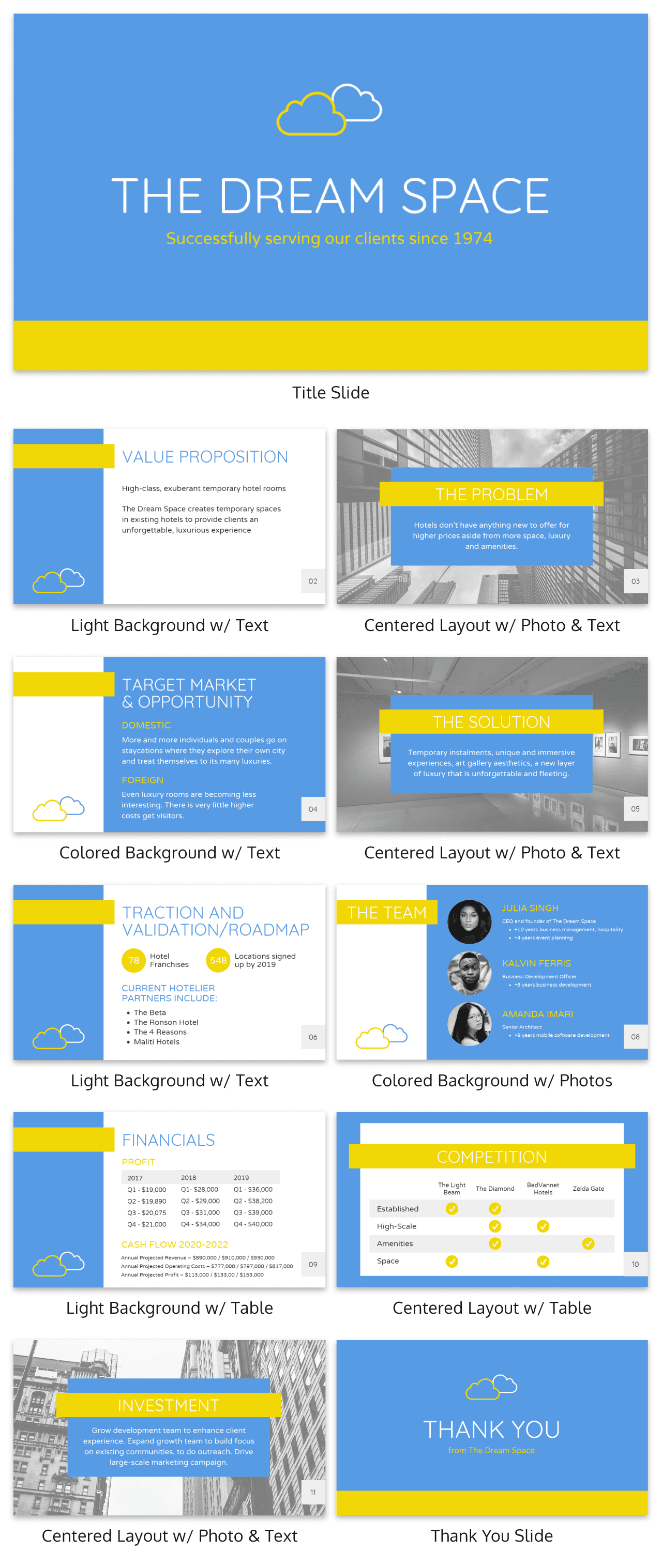
7. Use visuals to highlight the key message on each slide
As important as having one major takeaway per slide is having visuals that highlight the major takeaway on each slide.
Unique visuals will help make your message memorable.
Visuals are a great way to eliminate extra text, too.
You can add visuals by creating a timeline infographic to group and integrate information into visual frameworks like this:
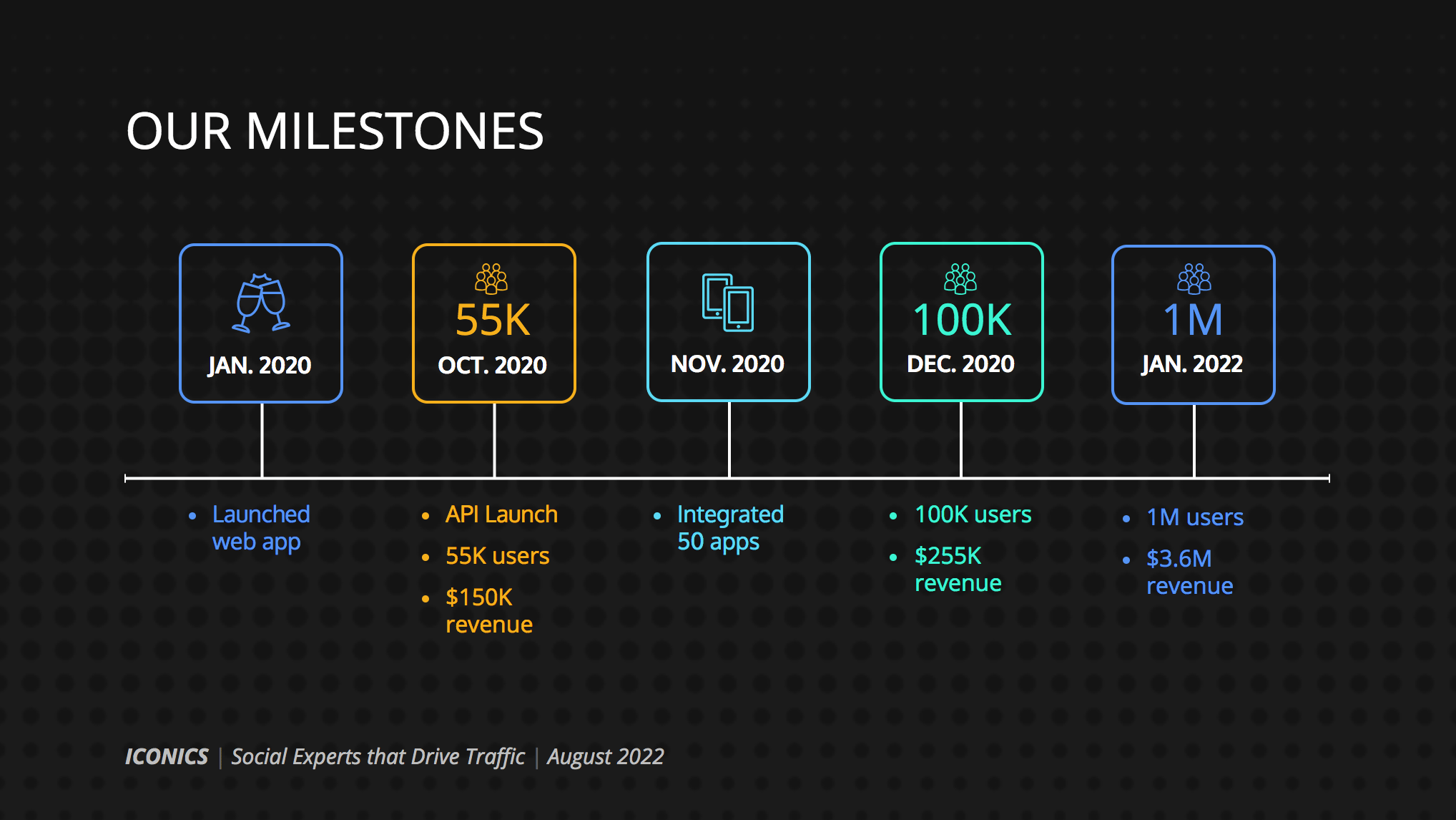
Or create a flowchart and funnels:
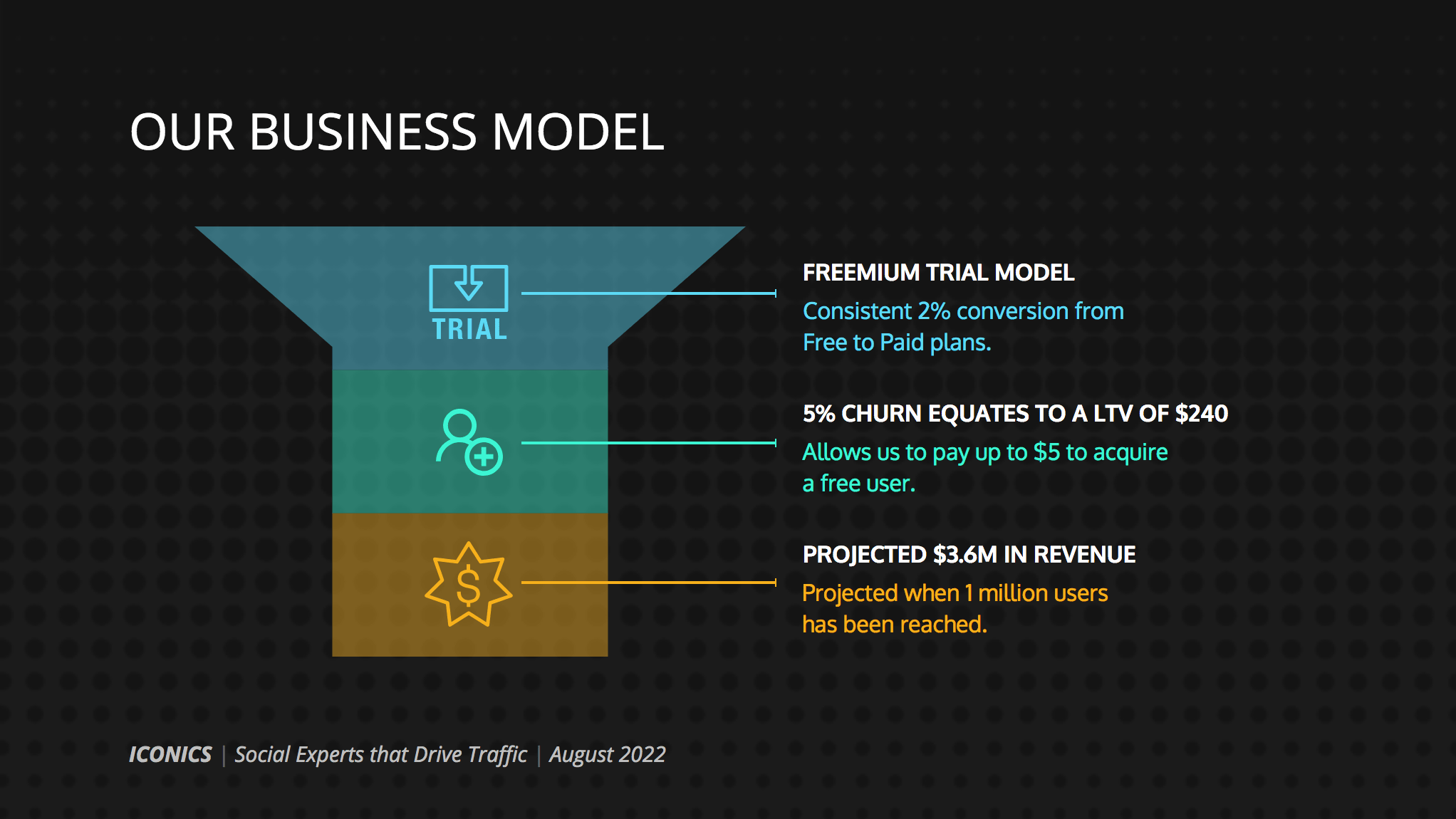
Or by representing simple concepts with icons, as seen in the modern presentation design below. Using the same color for every icon helps create a polished look.
Using visuals in this way is perfect for when you have to convey messages quickly to audiences that you aren’t familiar with – such as at conferences. This would also make the ideal interview presentation template.
You can alternatively use icons in different colors, like in the presentation templates below. Just make sure the colors are complimentary, and style is consistent throughout the presentation (i.e. don’t use sleek, modern icons on one slide and whimsically illustrated icons on another). In this example, presentation clipart style icons have been used.
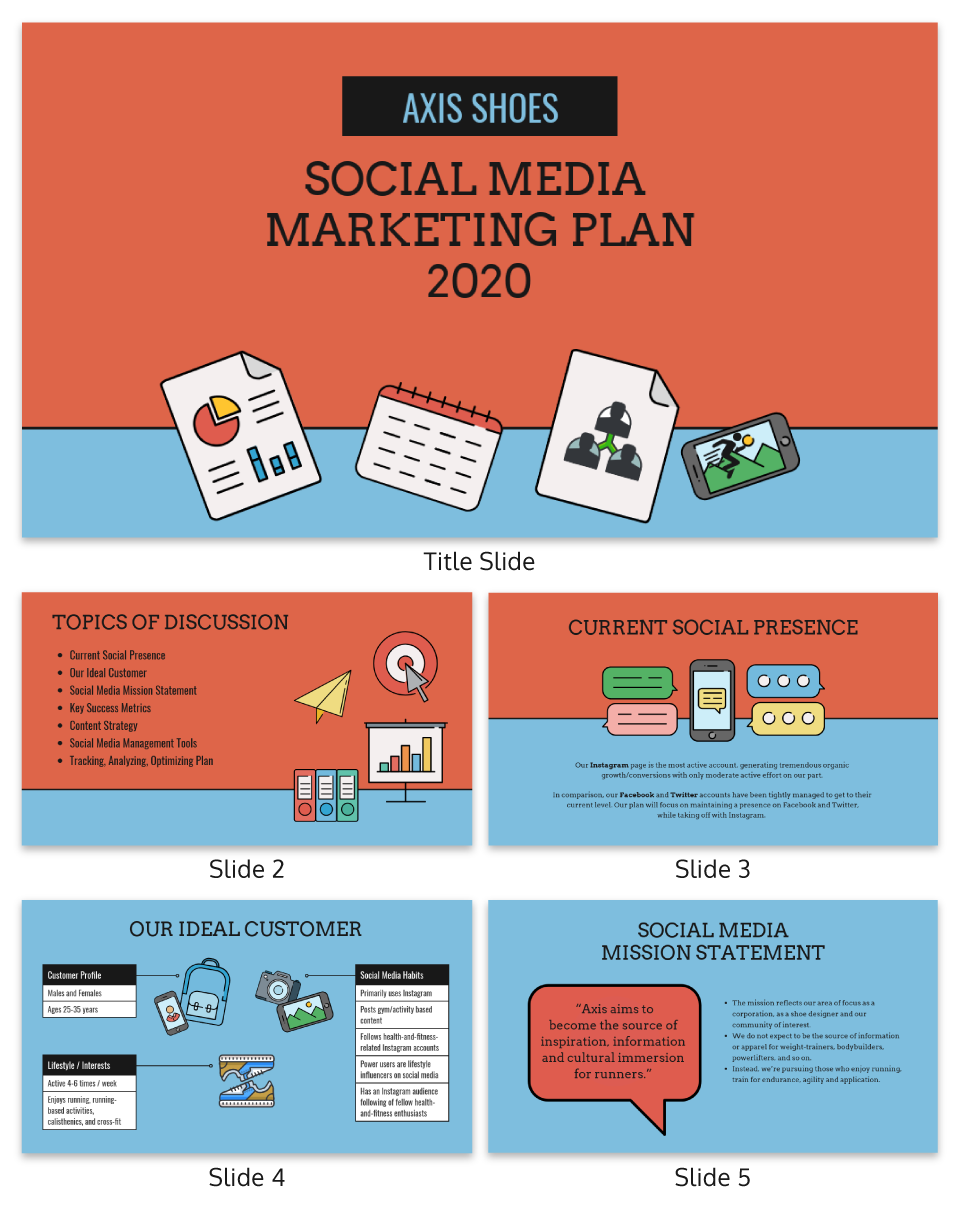
Any time you have important stats or trends you want your audience to remember, consider using a chart or data visualization to drive your point home. Confident public speaking combined with strong visualizations can really make an impact, encouraging your audience to act upon your message.
One of my personal favorite presentations (created by a professional designer) takes this “key message plus a visual” concept to the extreme, resulting in a slide deck that’s downright irresistible.
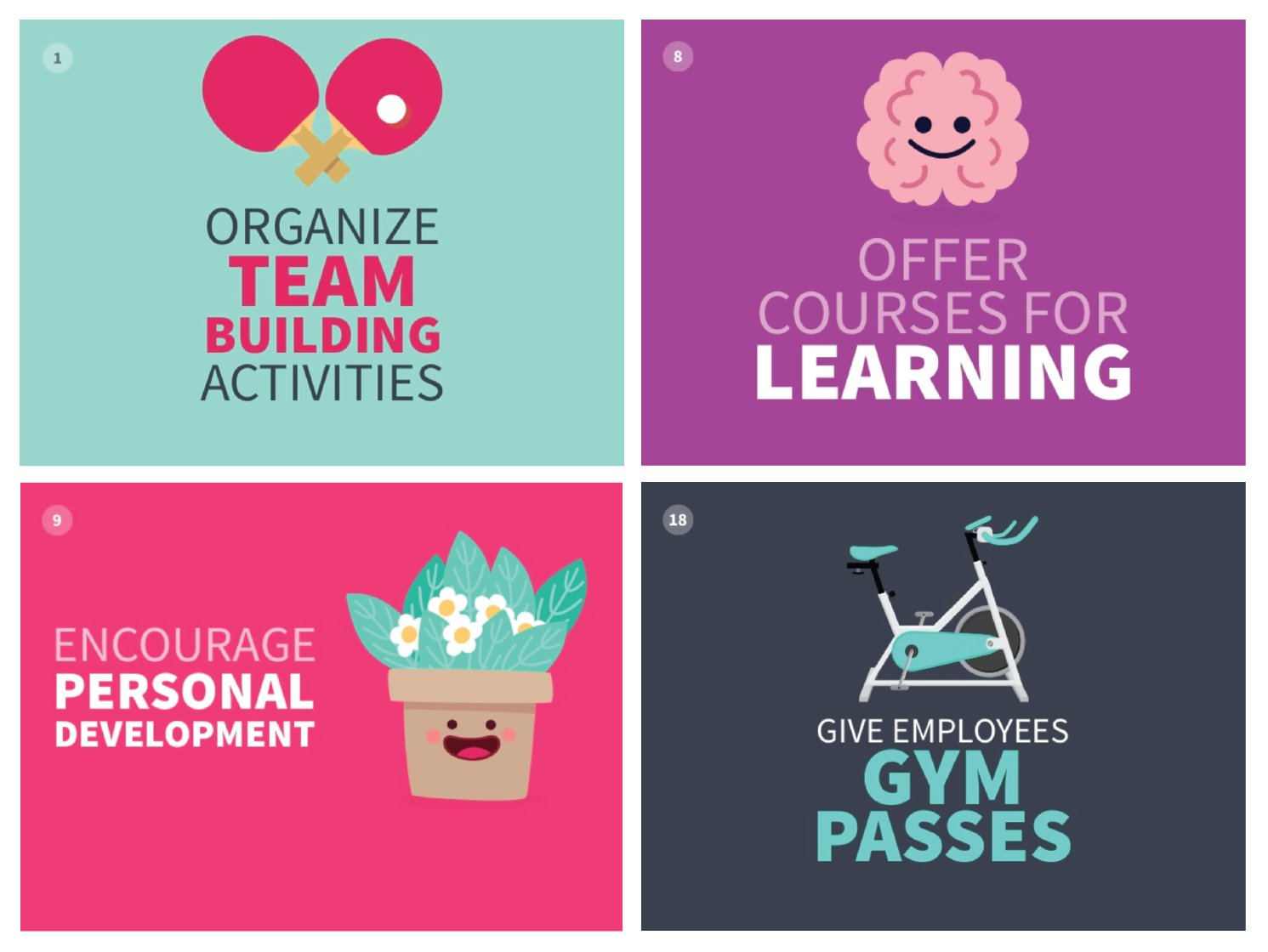
When applying this concept, don’t fall into the trap of using bad stock photos . Irrelevant or poorly chosen visuals can hurt you as much as they help you.
Below is an example of how to use stock photos effectively. They are more thematic than literal and are customized with fun, bright icons that set a playful tone.
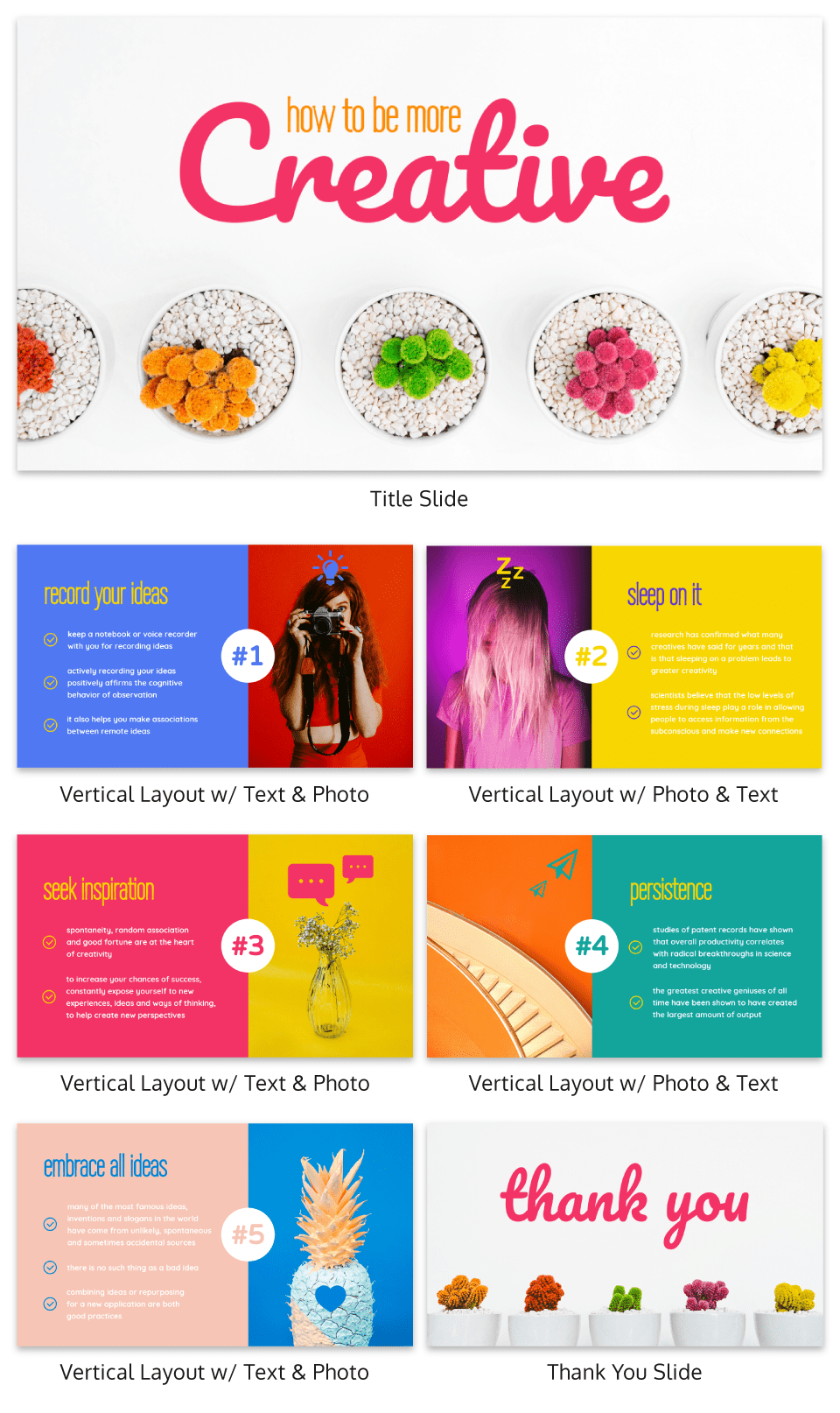
The content and visual design of a presentation should be seamless.
It should never seem like your text and visuals are plopped onto a template. The format and design of the slides should contribute to and support the audience’s understanding of the content.

8. Use scaffolding slides to orient your audience and keep them engaged
It’s easy for audiences to get lost during long presentations, especially if you have lots of slides. And audiences zone out when they get lost.
To help reorient your audience every once in a while, you can use something I like to call scaffolding slides. Scaffolding slides appear throughout a presentation to denote the start and end of major sections.
The core scaffolding slide is the agenda slide, which should appear right after the introduction or title slide. It outlines the major sections of the presentation.
At the beginning of each section, you should show that agenda again but highlight the relevant section title, as seen below.
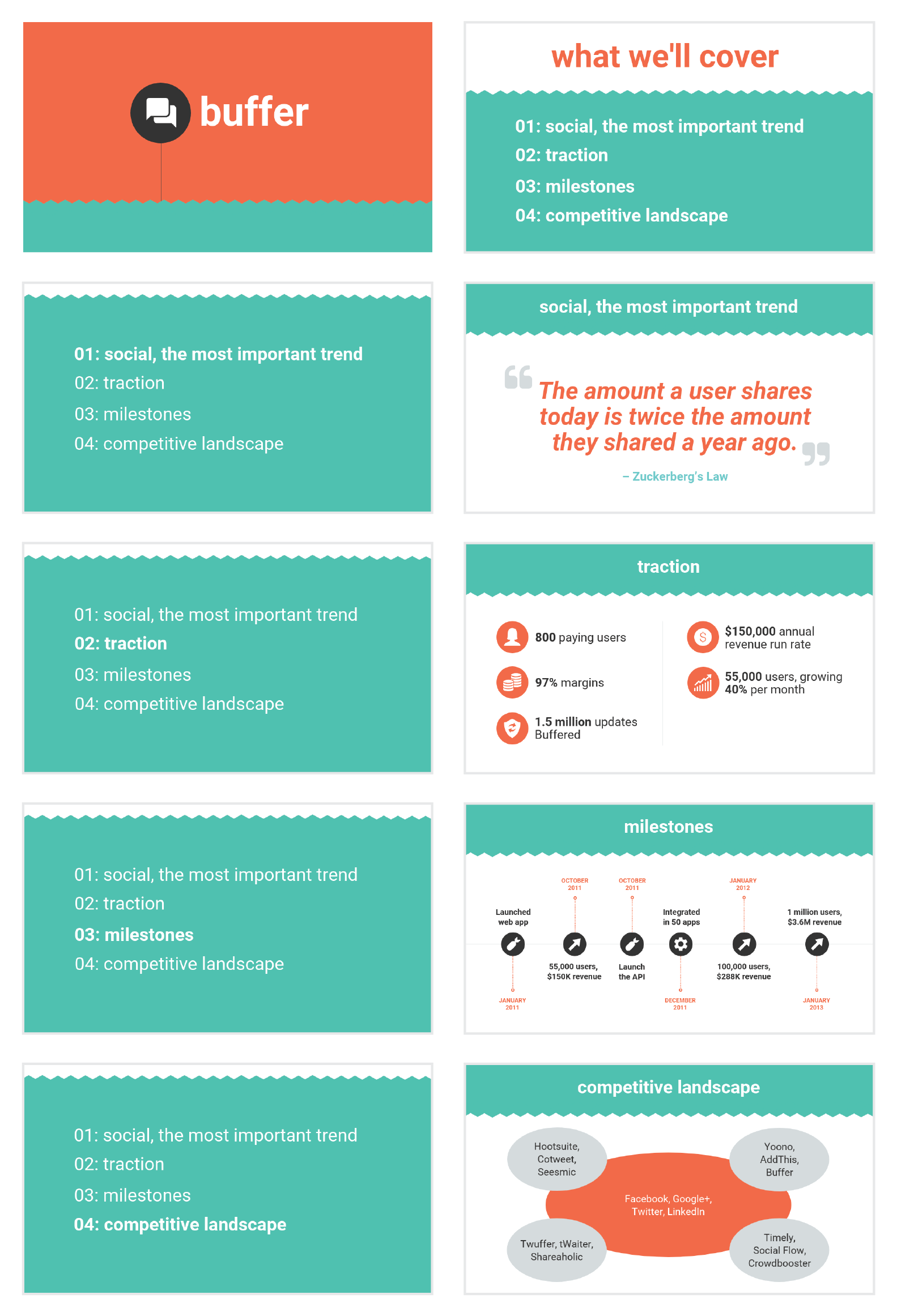
This gives audiences the sense that you’re making progress through the presentation and helps keep them anchored and engaged.
Alternatively, you can achieve a similar effect by numbering your sections and showing that number on every slide. Or use a progress bar at the bottom of each slide to indicate how far along you are in your presentation. Just make sure it doesn’t distract from the main content of the slides.

You can imagine using this “progress bar” idea for a research presentation, or any presentation where you have a lot of information to get through.
Leila Janah, founder of Sama Group, is great at this. Her Innovation and Inspire talk about Sama Group is an example of a presentation that is well organized and very easy to follow.
Her presentation follows a logical, steady stream of ideas. She seems comfortable talking in front of a crowd but doesn’t make any attempts to engage directly with them.
9. Use text size, weight and color for emphasis
Every slide should have a visual focal point. Something that immediately draws the eye at first glance.
That focal point should be whatever is most important on that slide, be it an important number, a keyword, or simply the slide title.

We can create visual focal points by varying the size, weight, and color of each element on the slide. Larger, brighter, bolder elements will command our audience’s attention, while smaller, lighter elements will tend to fade into the background.
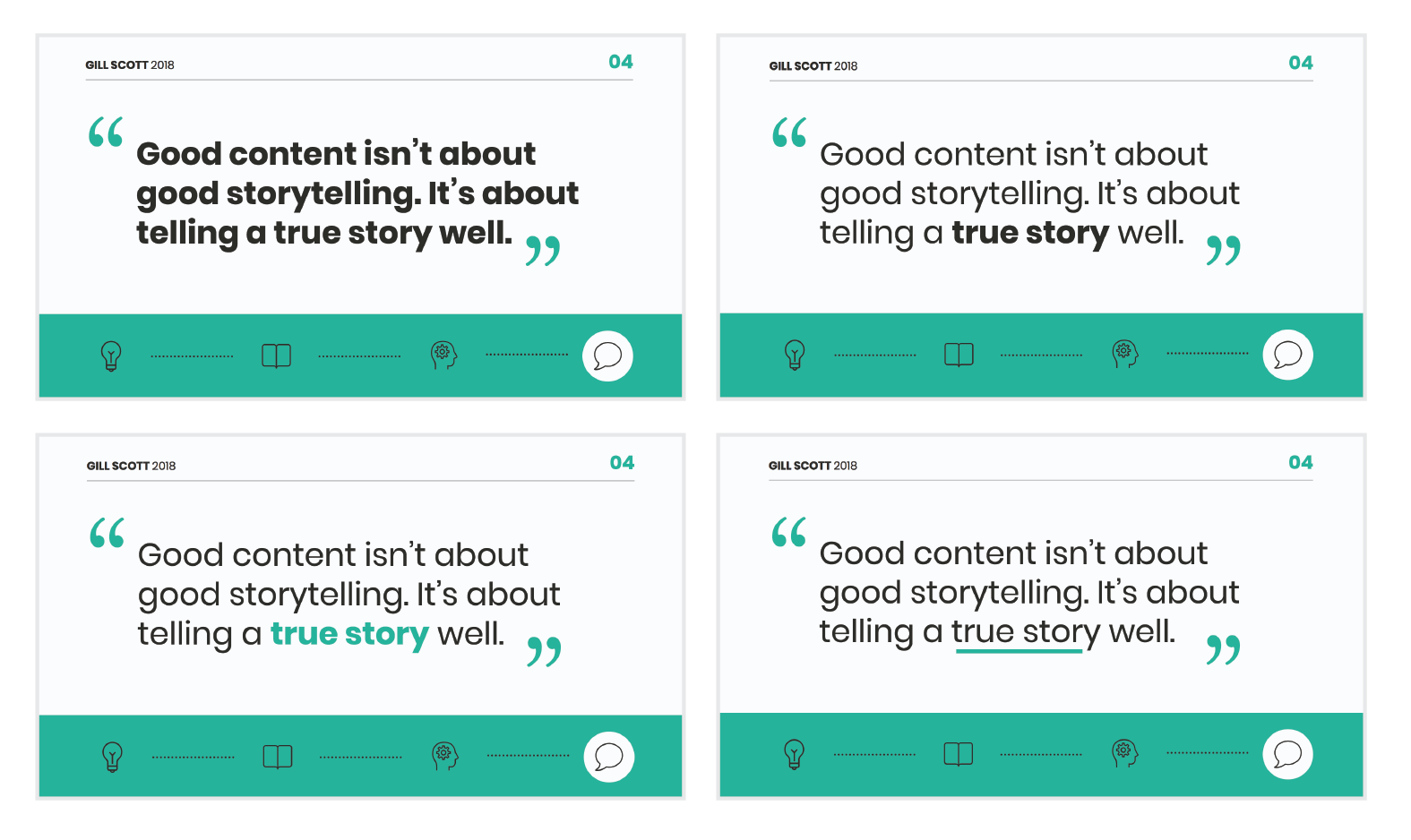
As seen in the presentation template above, this technique can be especially useful for drawing attention to important words within a long passage of text. Consider using this technique whenever you have more than 5 words on a slide.
And if you really want your audience to pay attention, pick a high-contrast color scheme like the one below.
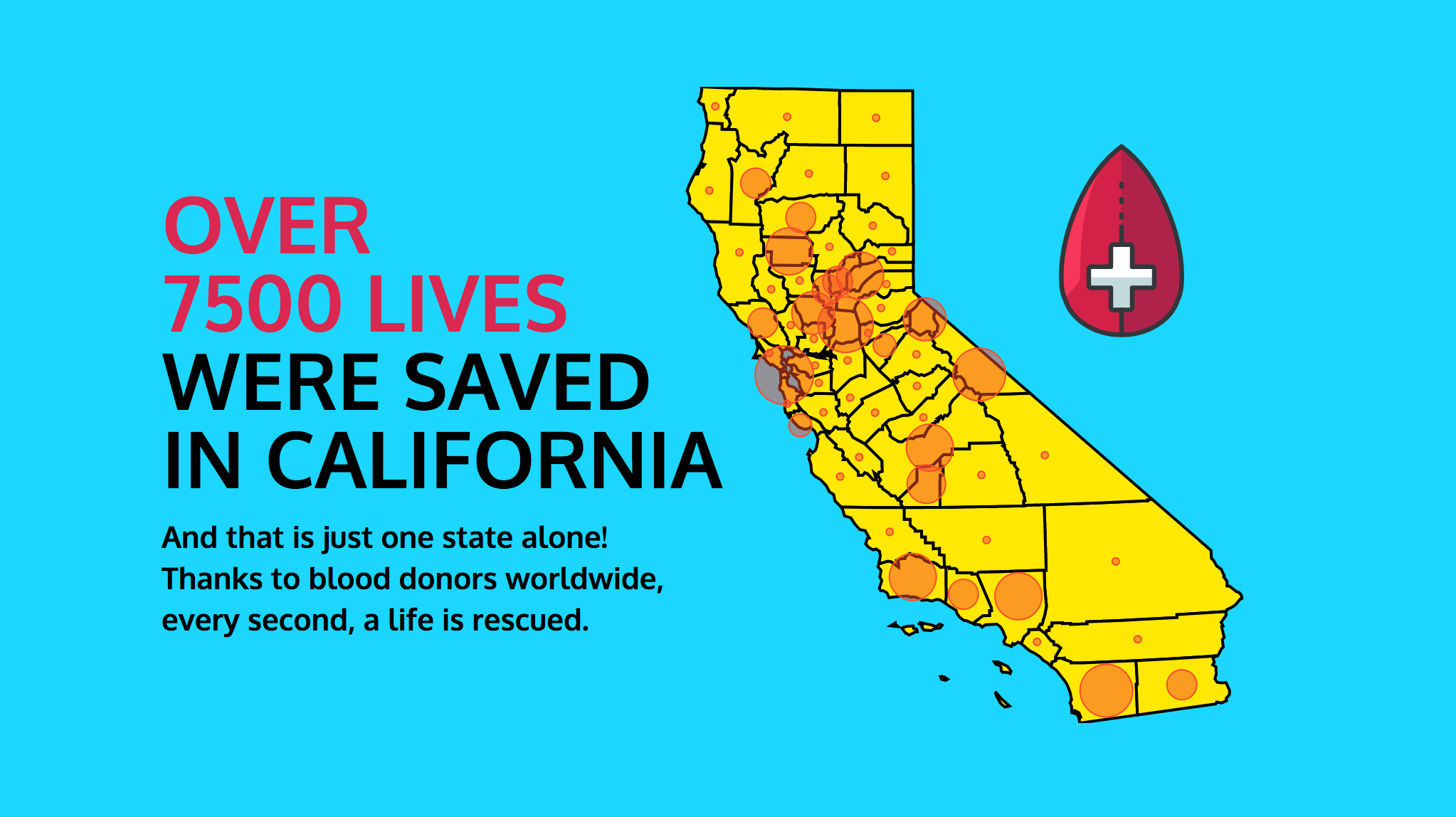
When picking fonts for your presentation, keep this technique in mind. Pick a font that has a noticeable difference between the “bold” font face and the “regular” font face. Source Sans Pro, Times New Roman, Montserrat, Arvo, Roboto, and Open Sans are all good options.
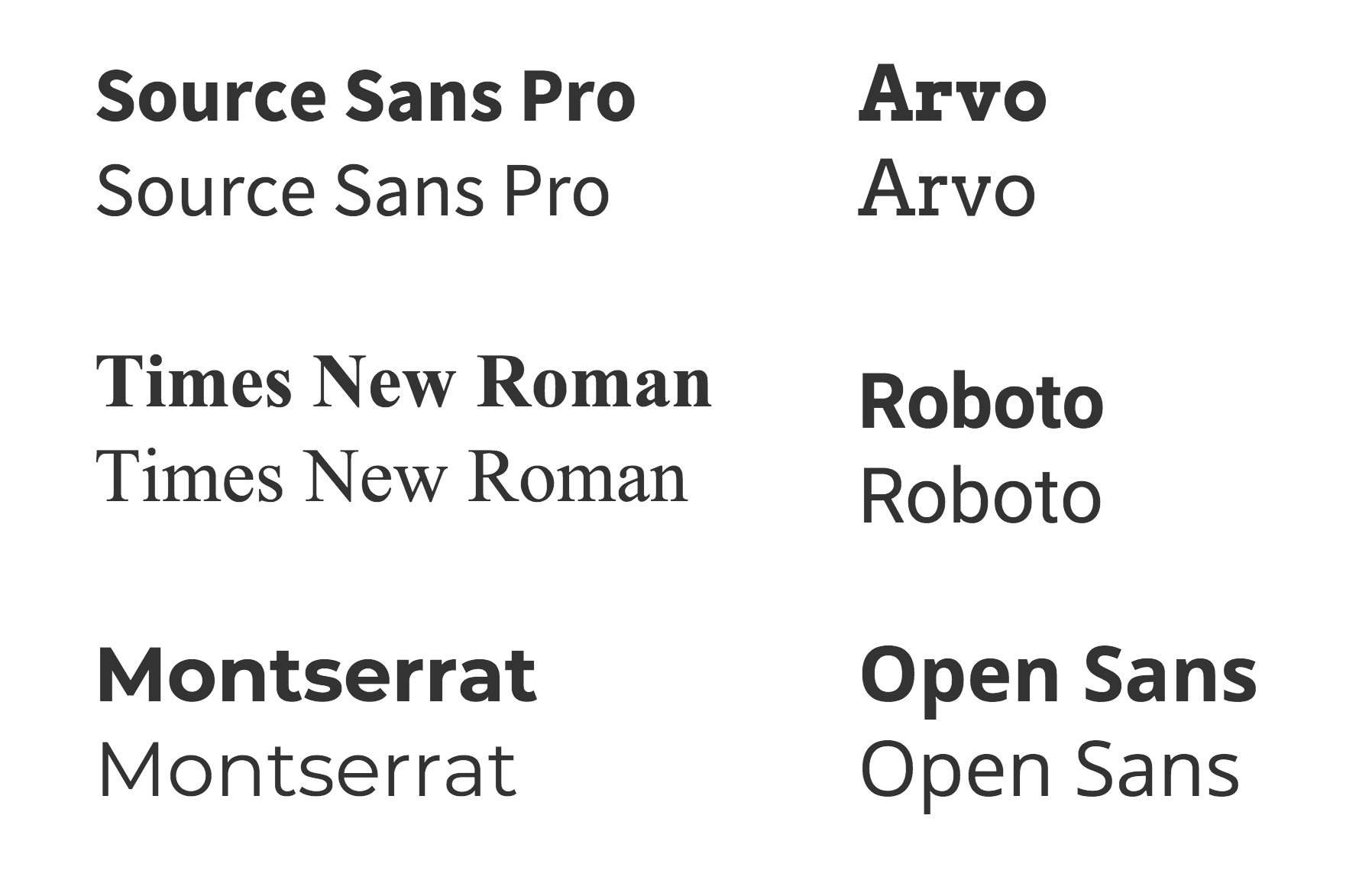
The last thing to remember when using size, weight, and color to create emphasis on a slide: don’t try to emphasize too many things on one slide.
If everything is highlighted, nothing is highlighted.
10. Apply design choices consistently to avoid distraction
Audiences are quick to pick out, and focus on, any inconsistencies in your presentation design. As a result, messy, inconsistent slide decks lead to distracted, disengaged audiences.
Design choices (fonts and colors, especially), must be applied consistently across a slide deck. The last thing you want is for your audience to pay attention to your design choices before your content.
To keep your design in check, it can be helpful to create a color palette and type hierarchy before you start creating your deck, and outline it in a basic style guide like this one:

I know it can sometimes be tempting to fiddle around with text sizes to fit longer bits of text on a slide, but don’t do it! If the text is too long to fit on a slide, it should be split up onto multiple slides anyway.
And remember, a consistent design isn’t necessarily a boring one. This social media marketing presentation applies a bright color scheme to a variety of 3-column and 2-column layouts, remaining consistent but still using creative presentation ideas.

11. Split a group presentation by topic
When giving a group presentation it’s always difficult to find the right balance of who should present which part.
Splitting a group presentation by topic is the most natural way to give everybody the chance to attempt without it seeming disjointed.
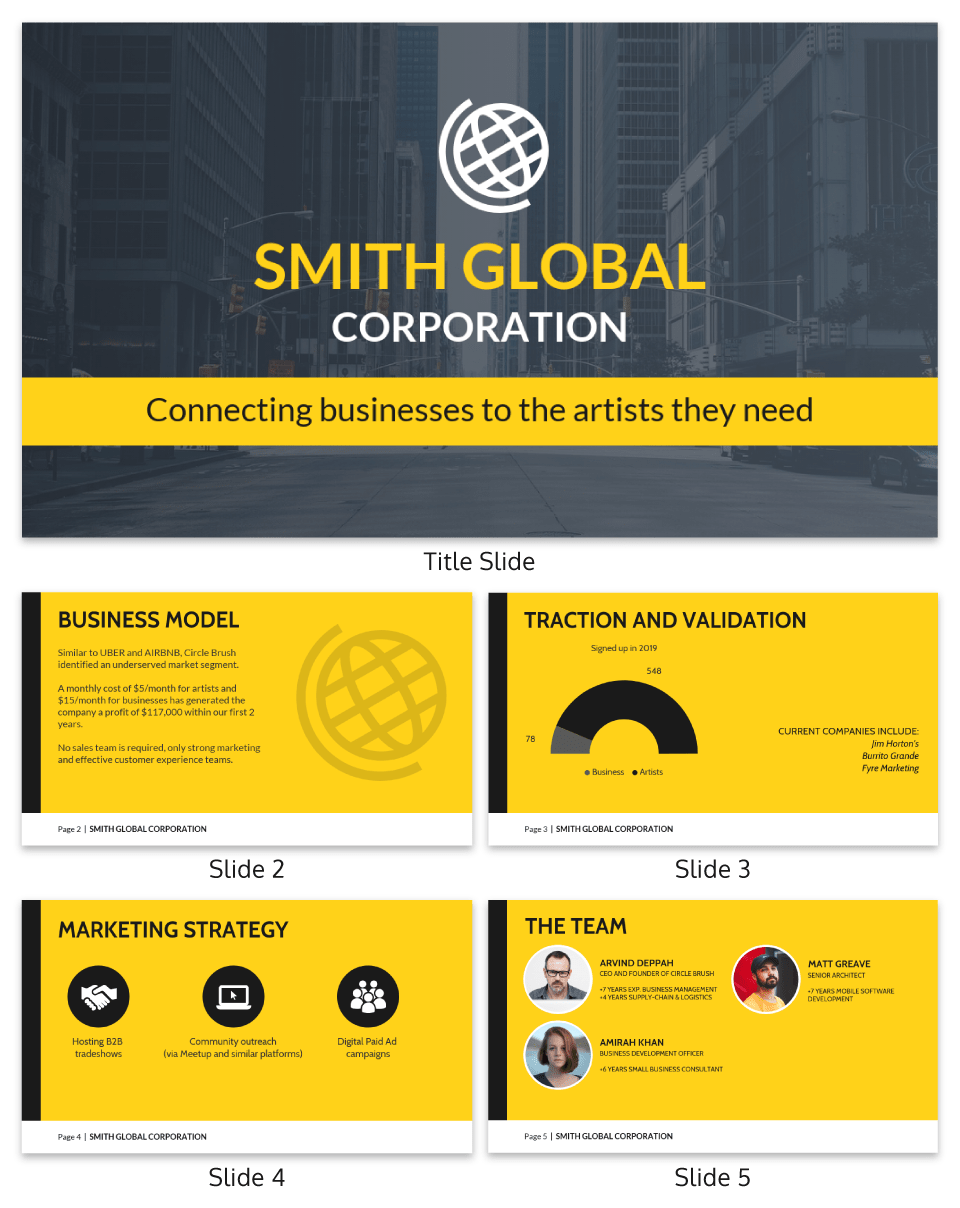
When presenting this slide deck to investors or potential clients, the team can easily take one topic each. One person can discuss the business model slide, and somebody else can talk about the marketing strategy.
Top tips for group presentations:
- Split your group presentation by topic
- Introduce the next speaker at the end of your slide
- Become an ‘expert’ in the slide that you are presenting
- Rehearse your presentation in advance so that everybody knows their cue to start speaking
12. Use a variety of page layouts to maintain your audience’s interest
Page after page of the same layout can become repetitive and boring. Mix up the layout of your slides to keep your audience interested.
In this example, the designer has used a variety of combinations of images, text, and icons to create an interesting and varied style.
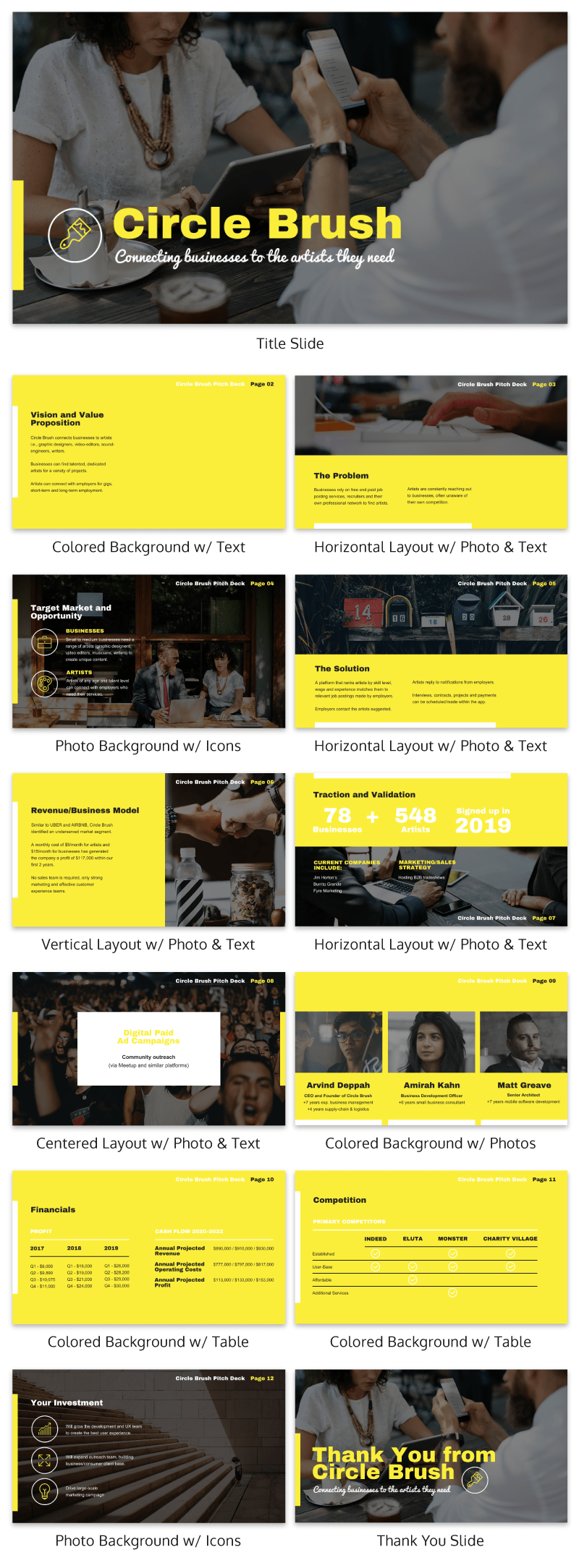
There are hundreds of different combinations of presentation layers and presentation styles that you can use to help create an engaging presentation . This style is great for when you need to present a variety of information and statistics, like if you were presenting to financial investors, or you were giving a research presentation.
Using a variety of layouts to keep an audience engaged is something that Elon Musk is an expert in. An engaged audience is a hyped audience. Check out this Elon Musk presentation revealing a new model Tesla for a masterclass on how to vary your slides in an interesting way:
13. Use presentation templates to help you get started
It can be overwhelming to build your own presentation from scratch. Fortunately, my team at Venngage has created hundreds of professional presentation templates , which make it easy to implement these design principles and ensure your audience isn’t deterred by text-heavy slides.
Using a presentation template is a quick and easy way to create professional-looking presentation skills, without any design experience. You can edit all of the text easily, as well as change the colors, fonts, or photos. Plus you can download your work in a PowerPoint or PDF Presentation format.
After your presentation, consider summarizing your presentation in an engaging manner to r each a wider audience through a LinkedIn presentation .
14. Include examples of inspiring people
People like having role models to look up to. If you want to motivate your audience, include examples of people who demonstrate the traits or achievements, or who have found success through the topic you are presenting.
15. Dedicate slides to poignant questions
While you might be tempted to fill your slides with decorative visuals and splashes of color, consider that sometimes simplicity is more effective than complexity. The simpler your slide is, the more you can focus on one thought-provoking idea.
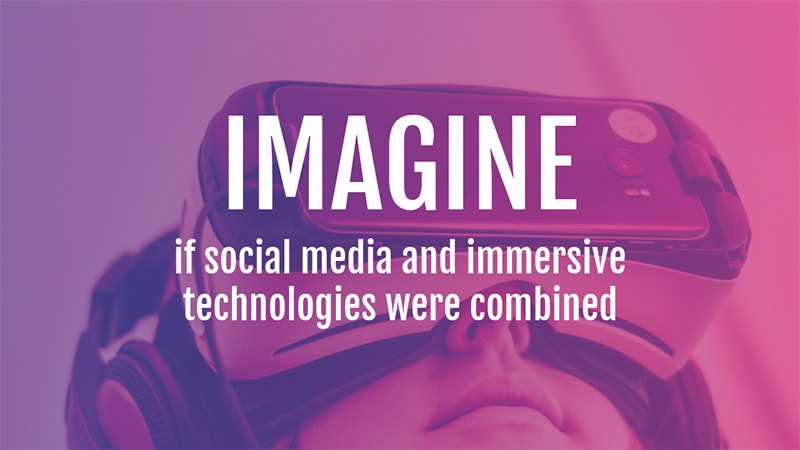
16. Find quotes that will inspire your audience
A really good quote can stick in a person’s mind for weeks after your presentation. Ending your presentation with a quote can be a nice way to either begin or finish your presentation.
A great example of this is Tim Ferriss’ TED talk:
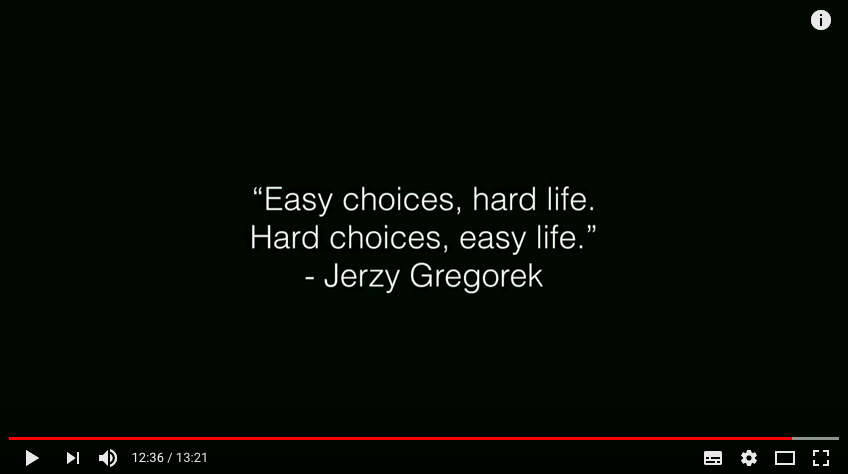
Check out the full talk below.
17. Emphasize key points with text and images
When you pair concise text with an image, you’re presenting the information to your audience in two simultaneous ways. This can make the information easier to remember, and more memorable.
Use your images and text on slides to reinforce what you’re saying out loud.
Doing this achieves two things:
- When the audience hears a point and simultaneously read it on the screen, it’s easier to retain.
- Audience members can photograph/ screencap the slide and share it with their networks.
Don’t believe us? See this tip in action with a presentation our Chief Marketing Officer Nadya gave recently at Unbounce’s CTA Conference . The combination of text and images on screen leads to a memorable presentation.

18. Label your slides to prompt your memory
Often, presenters will write out an entire script for their presentation and read it off a teleprompter. The problem is, that can often make your presentation seem too rehearsed and wooden.
But even if you don’t write a complete script, you can still put key phrases on your slides to prompt jog your memory. The one thing you have to be wary of is looking back at your slides too much.
A good presentation gets things moving! Check out the top qualities of awesome presentations and learn all about how to make a good presentation to help you nail that captivating delivery.
Audiences don’t want to watch presentations with slide decks jam-packed with text. Too much text only hurts audience engagement and understanding. Your presentation design is as important as your presentation style.
By summarizing our text and creating slides with a visual focus, we can give more exciting, memorable and impactful presentations.
Give it a try with one of our popular presentation templates:

Discover popular designs

Infographic maker

Brochure maker

White paper online

Newsletter creator

Flyer maker

Timeline maker

Letterhead maker

Mind map maker

Ebook maker
6 Different Types of Presentations

Presentations should be as unique as your business and the information you’re trying to present. However, there are certain types of presentations that are common across industries and teams. Before you worry about which slides to include or how to organize your information, you’ll need to determine which type of presentation is best for your audience.
To figure this out, ask yourself: Are you entertaining or informing? Are you speaking to colleagues, investors, or potential customers? Asking these questions will help you choose the type of presentation that supports you best. Beautiful.ai is here to make this even easier with a description of different types of presentations to help you choose.
Informative Presentations
An informative presentation is educational, concise, and to the point. While other presentations may entertain or inspire, the main goal of an informative presentation is to share information.
A good example of an informative presentation is a human resources benefits presentation. Human resources needs to explain what benefits employees receive, how benefits work, which important dates employees need to remember, where employees can find more information, and so on.
An HR benefits presentation for new hires (or any informational presentation) should be short, straightforward, and easy to understand so that new employees will remember the information they’re given.
Instructive Presentations
A presentation that teaches something is similar to an informative presentation, but it goes beyond sharing facts. It also instructs the audience on a specific topic. People attend or view an instructive presentation with the intention to learn, and they leave with a better understanding of the topic of the presentation.
There are many examples of instructive presentations. Workshops, training sessions, or webinars teach audiences a new skill or procedure by offering specific information or instructions. Explaining new policies to a company is another type of instructive presentation. For example, an HR benefits presentation for new employees may be informative, but a presentation for existing employees about policy changes might lean more towards instructive, especially if employees have to take action or need to ask questions.
Persuasive Presentations
Many presentations hope to sell something or persuade the audience to take certain actions. Persuasive presentations often present a problem and explain their solution using data. Examples of persuasive presentations include business pitches or sales proposals.
For example, a startup company looking for initial funding may need a startup pitch deck or a Series A presentation to convince investors to back their idea. A startup pitch deck would explain a problem in the market, how their startup will solve that problem, and how they’ll monetize their business. A Series A presentation can help a startup secure more rounds of funding to grow their company and pursue further goals.
Motivational Presentations
One of the most prominent examples of inspiring presentations? TEDTalks. Many motivational speakers use TEDTalks to inspire people to think or change their behavior.
Motivational presentations in the business world may not be as dramatic or life-changing as a TEDTalk, but they still aim to generate interest or gain an audience’s approval. A company overview presentation is a good example of a motivational presentation. It may present the information of a company — how it was founded, who is leading it, what the company does — but more importantly, it tells the company’s story.
A company overview presentation connects with the audience. A manager may use it to boost morale at a team meeting. Or an executive may present a company overview to convince potential customers or investors to work with them. Or, an HR rep may use it to make new hires feel welcome and excited to join the company.
Decision-making Presentations
Need to make a decision within the company? A presentation that shares a problem, solution options, and their outcomes can help speed along the process. Decision making presentations might be found in business meetings, government meetings, or all-hands meetings.
For example, let’s say a company wants to improve engagement on their social media channels. There are many ways they might achieve their goal, including hosting giveaways, dedicating more resources to creating Facebook posts or Instagram stories, and researching their audience or competitors to see how they can improve. A marketing campaign plan template for a presentation would keep details of the problem, different options, and possible outcomes organized in one place. It would inform and guide everyone involved in the meeting, helping them make informed decisions on how to move forward.
Progress Presentations
Imagine our hypothetical company decided on a marketing strategy to meet their goals. Now that they have a campaign in place, they need to report on the progress of said campaign. This sixth presentation type shares status updates, progress towards deadlines, collected data so far, any obstacles popping up, and tasks that need to be added or adjusted.
A team stand up presentation is a great example of this type of presentation. Team stand up presentations usually include an agenda, talking points, deliverable updates, discussion topics, and time for questions at the end. This presentation keeps everyone organized and focused, ensuring that everyone is still on the same page and working towards the same end goal.
Whichever Presentation Type You Choose, Create it With Beautiful.ai
Now that you know which presentation type is right for your project, it’s time to create a beautiful and effective presentation. With Beautiful.ai , you don’t need to set aside hours of time to build your presentation, nor do you need design expertise to do it. Use one of our many presentation templates that can be customized for your needs in minutes. No matter what type of presentation you create, Beautiful.ai can help you do it.
Beautiful.AI Team
Beautiful is an AI-powered presentation tool that makes it fast and easy for anyone to build clean, modern and professionally designed slides that they can be proud of.
Recommended Articles
9 easy ways to kicka$$ at public speaking with tedxtalk's bobby umar, sales pitch training: how to build pitch templates that will power up your junior sales team, tedxtalker bobby umar's 5 popular public speaking mistakes to learn from, top tips for preparing and delivering a remote presentation.
The 8 Types of Presentation Styles: Which Category Do You Fall Into?
Updated: December 16, 2020
Published: September 24, 2018
Types of Presentations
- Visual Style
- Freeform Style
- Instructor Style
- Coach Style
- Storytelling Style
- Connector Style
- Lessig Style
- Takahashi Style
Everyone on the internet has an opinion on how to give the “perfect” presentation.

One group champions visual aids, another thinks visual aids are a threat to society as we know it. One expert preaches the benefits of speaking loudly, while another believes the softer you speak the more your audience pays attention. And don’t even try to find coordinating opinions on whether you should start your presentation with a story, quote, statistic, or question.
But what if there wasn’t just one “right” way to give a presentation? What if there were several? Below, I’ve outlined eight types of presentation styles. They’re used by famous speakers like Steve Jobs and Al Gore -- and none of them are wrong.
Check out each one and decide which will be most effective for you.
![different types of ppt presentation → Free Download: 10 PowerPoint Presentation Templates [Access Now]](https://no-cache.hubspot.com/cta/default/53/2d0b5298-2daa-4812-b2d4-fa65cd354a8e.png)
Types of Presentation Styles
1. visual style.
What it is: If you’re a firm believer slides simply exist to complement your talking points, this style is for you. With this speaking style, you might need to work a little harder to get your audience engaged, but the dividends can be huge for strong public speakers, visionaries, and storytellers.
When to use it: This style is helpful when speaking to a large audience with broad interests. It’s also great for when you need to throw together slides quickly.
Visual style presenter: Steve Jobs
2. Freeform Style
What it is: This impromptu style of presenting doesn’t require slides. Instead, the speaker relies on strong stories to illustrate each point. This style works best for those who have a short presentation time and are extremely familiar with their talking points.
When to use it: Elevator pitches, networking events, and impromptu meetings are all scenarios in which to use a freeform style of speaking. You’ll appear less rehearsed and more conversational than if you were to pause in the middle of a happy hour to pull up your presentation on a tablet.
Freeform style presenter: Sir Ken Robinson
3. Instructor Style
What it is: This presentation style allows you to deliver complex messages using figures of speech, metaphors, and lots of content -- just like your teachers and professors of old. Your decks should be built in logical order to aid your presentation, and you should use high-impact visuals to support your ideas and keep the audience engaged.
When to use it: If you’re not a comfortable presenter or are unfamiliar with your subject matter (i.e., your product was recently updated and you’re not familiar with the finer points), try instructor-style presenting.
Instructor style presenter: Al Gore
4. Coach Style
What it is: Energetic and charismatic speakers gravitate towards this style of presenting. It allows them to connect and engage with their audience using role play and listener interaction.
When to use it: Use this presentation style when you’re speaking at a conference or presenting to an audience who needs to be put at ease. For example, this style would work well if you were speaking to a group of executives who need to be sold on the idea of what your company does rather than the details of how you do it.
Coach style presenter: Linda Edgecombe
5. Storytelling Style
What it is: In this style, the speaker relies on anecdotes and examples to connect with their audience. Stories bring your learning points to life, and the TED’s Commandments never let you down: Let your emotions out and tell your story in an honest way.
When to use it: Avoid this style if you’re in the discovery phase of the sales process. You want to keep the conversation about your prospect instead of circling every point or question back to you or a similar client. This style is great for conference speaking, networking events, and sales presentations where you have adequate time to tell your stories without taking minutes away from questions.
Storytelling style presenter: Jill Bolte Taylor
6. Connector Style
What it is: In this style, presenters connect with their audience by showing how they’re similar to their listeners. Connectors usually enjoy freeform Q&A and use gestures when they speak. They also highly encourage audience reaction and feedback to what they’re saying.
When to use it: Use this style of presenting early in the sales process as you’re learning about your prospect’s pain points, challenges, and goals. This type of speaking sets your listener at ease, elicits feedback on how you’re doing in real time, and is more of a dialogue than a one-sided presentation
Connector style presenter: Connie Dieken
7. Lessig Style
What it is: The Lessig Style was created by Lawrence Lessig , a professor of law and leadership at Harvard Law School. This presentation style requires the presenter to pass through each slide within 15 seconds. When text is used in a slide, it’s typically synchronized with the presenter’s spoken words.
When to use it: This method of presentation is great for large crowds -- and it allows the speaker to use a balance of text and image to convey their message. The rapid pace and rhythm of the slide progression keeps audiences focused, engaged, and less likely to snooze.
Lessig style presenter: Lawrence Lessig
8. Takahashi Style
What it is: This method features large, bold text on minimal slides. It was devised by Masayoshi Takahashi , who found himself creating slides without access to a presentation design tool or PowerPoint. The main word is the focal point of the slide, and phrases, used sparingly, are short and concise.
When to use it: If you find yourself in Takahashi’s shoes -- without presentation design software -- this method is for you. This style works well for short presentations that pack a memorable punch.
Takahashi style presenter: Masayoshi Takahashi
Slides from one of Takahashi’s presentations:
Whether you’re speaking on a conference stage or giving a sales presentation , you can find a method that works best for you and your audience. With the right style, you’ll capture attention, engage listeners, and effectively share your message. You can even ask an AI presentation maker tool to create presentations for you in your preferred style
![different types of ppt presentation Blog - Beautiful PowerPoint Presentation Template [List-Based]](https://no-cache.hubspot.com/cta/default/53/013286c0-2cc2-45f8-a6db-c71dad0835b8.png)
Don't forget to share this post!
Related articles.
![different types of ppt presentation 10 Best Sales Presentations To Inspire Your Sales Deck [+ 5 Tips]](https://blog.hubspot.com/hubfs/sales-deck.jpg)
10 Best Sales Presentations To Inspire Your Sales Deck [+ 5 Tips]

15 Sales Presentation Techniques That Will Help You Close More Deals Today

9 Ways to End Your Sales Presentation With a Bang

7 Apps That Help Salespeople Become Even Better Speakers

7 Secrets of a Winning Capabilities Presentation

Insight Selling: The 8-Slide Framework for a Better Pitch

The Best Work-Appropriate GIFs to Use in Your Next Sales Slide Deck
![different types of ppt presentation How to Make a Business Presentation in 7 Easy Steps [Free Business Presentation Templates]](https://blog.hubspot.com/hubfs/how-to-make-a-business-presentation.jpg)
How to Make a Business Presentation in 7 Easy Steps [Free Business Presentation Templates]

How to Handle Difficult Sales Calls Like a Pro

Technology Give You the Middle Finger in a Demo? 7 Reactions to Avoid
Download ten free PowerPoint templates for a better presentation.
Powerful and easy-to-use sales software that drives productivity, enables customer connection, and supports growing sales orgs

6 Types of Presentations and Which One is the Best for You
Last updated on April 22nd, 2024
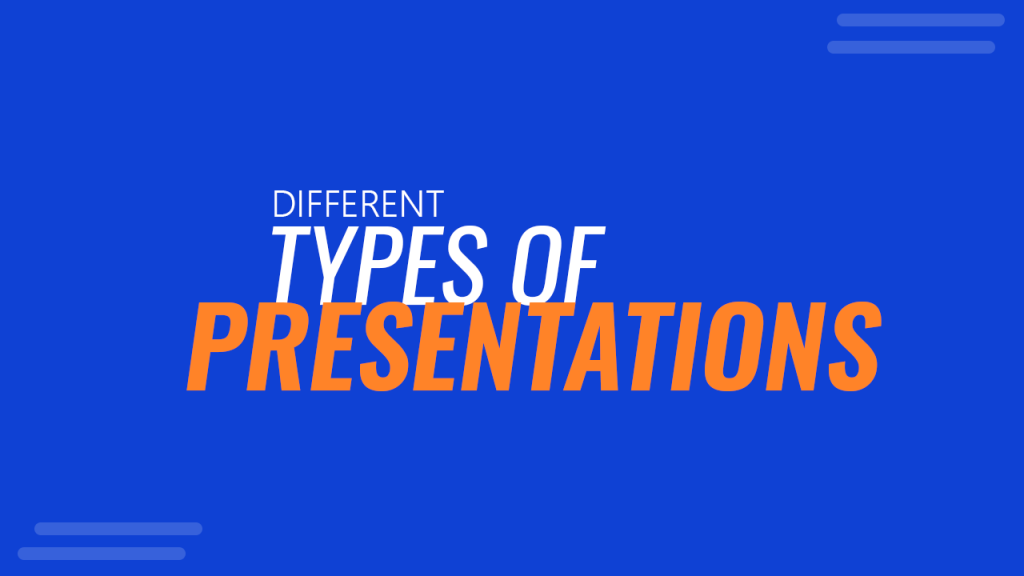
Presentations are an important part of the routine lives of students, business people, and other professionals. Different presentations are used for different occasions and purposes, such as student speeches, seminars, conferences, webinars, other eLearning activities, etc.
Choosing a proper presentation type for your next activity or meeting can be hectic for many professionals. That is why you must have a quick idea about how many presentation types are actually there and which one is best for you to achieve your specific goal or objective.
Are there any specific categories of presentations? Why is there a need for different types of presentation methods? This article will answer all of these questions in addition to some free premade presentation templates that have been made to save time and other resources for professionals, students, and business people.
Why Do You Need Different Types of Presentation Styles?
To deliver a persuasive and results-oriented presentation , the speaker must use techniques and tools to engage his audience and retain their attention. To achieve different objectives, a speaker may implement various techniques and methods of delivering his message.
If one expert says that the presenter should speak loudly, the other professional may argue that the visuals must be present throughout your presentation slides. Someone may stress the need for storytelling, while another mentor may think that statistics, infographics, or quotes are integral parts of successful presentations.
What if there was not a single way of delivering a presentation? What if there are several types of presentations that are used on different occasions for achieving specific objectives? Below, 6 different types of presentation styles are mentioned that are used for specific purposes only.
6 Different Types of Presentations (Plus Actionable Tips to Deliver Them)
When do you need specific types of presentation methods? How do they fulfill your specific purposes? Let’s have a look at 6 different types of presentations.
1. Informative Presentations
One of the most common presentation types is an informative presentation used for endless occasions, from educational to corporate business activities.
Why is there a need for informative presentations?
When you want to deliver detailed information or data about a specific product, service, idea, or process to a specific audience, these kinds of presentations are ideal. In such presentations, the speaker may seem analytical and rational to prove and make his concepts understandable to listeners. Informative presentations can be used in many situations . A news anchor may use informative presentations to present his data and information more systematically and comprehensively. Businesses and institutions’ decision-makers use such presentations to discuss the pros and cons of a specific process, situation, or activity to reach effective solutions for specific problems. Hence, if you are looking forward to delivering a relatively longer presentation, an informative presentation can prove to be an appropriate choice for you. You can look at articles regarding how many slides for a long presentation or how many slides for 30 minutes to have a better idea of how to effectively present longer-duration presentations.
Tips for delivering effective informative presentations
Here are a few tips for informative presentations.
- You should focus on the main points or agenda of your topic first
- Don’t use complex sentences and graphics to avoid confusion among listeners.
- Try telling your presentation’s outline in the introduction section
- Summarize important points and ideas of your presentation in the end
2. Persuasive Presentations
Persuasion is an art through which an individual influences the opinions, thoughts, decisions, and actions of others. Delivering persuasive presentations is a need of the hour for many business people like marketers, project managers, and salespersons.
Why is there a need for persuasive presentations?
There are various circumstances in which persuasive presentations can be used.
Governmental institutions can use persuasive presentations in policy-making and election campaigns to convince their listeners to respond to a specific call to action . Senior executives or management of an organization can leverage such presentations to win the trust and confidence of their relevant stakeholders. Speakers in TED Talks also need to convince their listeners regarding their concepts and ideas, and they use persuasive presentations to leave a significant impact on the minds of their audience . From youtube videos to sermons of religious leaders, persuasive presentations find their applications in many fields of life. If you are looking for premade free templates for your next persuasive presentation, look at our best PowerPoint Templates specifically made for your needs.
Tips for delivering effective persuasive presentations
Here are some actionable tips for delivering persuasive presentations.
- To develop credibility, start your presentation with a relevant quote or statistical analysis.
- Try to relate your arguments and data with personal experiences and stories.
- Try delivering your presentation passionately with genuine interest and attention.
- Your presentation should be an answer to the queries of your audience. Try to leave no stone unturned to deliver your message efficiently.
3. Demonstrative Presentations
Known as a demonstrative presentation when a presentation is based on the step-by-step demonstration of a product, service, or process . The audience is usually more attentive in such presentations, and you can leverage this added characteristic to your maximum advantage by implementing effective measures.
Why is there a need for demonstrative presentations?
When an employer or trainer teaches his employees about a specific operational process, activity, or task systematically, he usually uses demonstrative presentation. Instructional videos and training generally depend on such presentations to effectively guide the audience.
You don’t need to develop demonstrative presentations from scratch all by yourself. Our website Free PowerPoint Templates offers quality premade templates with in-built process demonstrations and infographics for your every possible need. Just download any of your desired templates with a simple click. You can make a few changes to the specific areas of your template as per your requirements, and in no time, your own professionally crafted demonstrative presentation will be ready to deliver. You can also easily get ideas regarding different presentation backgrounds for your next eye-catching and persuasive presentation.
Tips for delivering effective demonstrative presentations
Here are some effective tips for you.
- Try introducing your product, service, or process a bit before its elaborative demonstration.
- Use the maximum number of diagrams and visuals.
- Try clearing the doubts of your listeners during your presentation for better understanding.
- Spend less time on the introduction part and more time on the demonstration part.
- Try mentioning some options or alternatives for the audience in the end so that they can implement the suggested measures as per their own desires and needs.
4. Inspirational Presentations
Also known as motivational presentations, inspirational presentations aim to inspire and motivate the audience . By developing an emotional connection with the listeners, the speaker tries to convey his ideas and thoughts through stories, personal experiences, and even humor sometimes.

Why is there a need for inspirational presentations?
Motivational speakers use such presentations to inspire their audience and make them see the positive aspects of life and the circumstances they face. For example, in TED Talks, a speaker uses a slide presentation along with his/her verbal speech to influence his/her listeners more effectively. Farewell speeches and presentations delivered by senior executives or management of businesses can also be considered examples of inspirational presentations.
Tips for delivering effective inspirational presentations
By following the below-mentioned tips, you can become an appealing inspirational speaker.
- Start with a startling question or statement that will leave the audience thinking for a long time.
- Use the storytelling approach to resonate with the minds of your listeners.
- Emphasize your presentation’s main points and ideas.
- Use humor if it helps in achieving your audience’s attention.
- Improve your body language and posture to establish authority on the stage.
5. Business Presentations
In the business landscape, presentations are used for countless purposes like business planning, decision-making, developing a strategy, forecasting future results, hiring new employees, analyzing project management activities, etc.
Why is there a need for business presentations?
As told before, business presentations have numerous applications in several areas of the business world . One of the most common usage of such presentations is in sales and marketing activities. A salesperson can use such a presentation to market his product effectively to convert his listener into a customer.
Look at our Sales PowerPoint Templates to better understand such presentations. Business presentations are also used in corporate training sessions, meetings, e-presentations, seminars, webinars, one-on-one interviews, etc.
Tips for delivering effective business presentations
Here are some actionable business presentation tips for you.
- Use concise and solid points in your slides by making important keywords either bold or highlighted.
- Avoid informal tone of speech. Business presentations are usually formal and should be delivered accordingly.
- Be punctual during such presentations. Being late or showing irresponsible behavior is highly discouraged by the audience in such kinds of presentations.
- Go prepared in front of the audience so that you can answer all of their questions effectively.
6. PowerPoint Presentations
PowerPoint presentations are one of the most effective and widely used presentation types worldwide . They are easy to develop, deliver and understand. No matter what type of purpose you are trying to achieve, PowerPoint presentations can always come in handy in almost all possible situations you may find yourself in.
Why is there a need for PowerPoint presentations?
You can deliver such presentations for any audience, like for educational, business, formal, or informal purposes. You can use them to educate your listeners and inform them about a specific issue or process. PechaKucha presentations are also very popular for telling a story or narrating a personal experience. You don’t need to design and develop PowerPoint presentations yourself, as our website Free PowerPoint Templates is now offering thousands of free premade templates. Delivering and designing any PowerPoint presentation was never this easy.
In Conclusion
Although all types of presentations have their benefits and specific use cases , some are universal, and by modifying them a little bit, you can use them for various purposes. The best examples of such types of presentations are PowerPoint Presentations that can be used for a variety of purposes with the help of premade templates (as mentioned above).
Every audience has different requirements; therefore, the presenter must be ready to deliver the desired message or idea per the needs of his listeners. Using the previously mentioned presentation types and methods, any user can now fulfill the demands of every possible situation in which he may have to deliver a presentation. With actionable tips, strategies, and premade templates mentioned above, you are now fully equipped to efficiently hit your desired presentation targets.
Leave a Comment Cancel reply
Your email address will not be published. Required fields are marked *
Save my name, email, and website in this browser for the next time I comment.
Sign up to our newsletter
We will send you our curated collections to your email weekly. No spam, promise!

- Get started with computers
- Learn Microsoft Office
- Apply for a job
- Improve my work skills
- Design nice-looking docs
- Getting Started
- Smartphones & Tablets
- Typing Tutorial
- Online Learning
- Basic Internet Skills
- Online Safety
- Social Media
- Zoom Basics
- Google Docs
- Google Sheets
- Career Planning
- Resume Writing
- Cover Letters
- Job Search and Networking
- Business Communication
- Entrepreneurship 101
- Careers without College
- Job Hunt for Today
- 3D Printing
- Freelancing 101
- Personal Finance
- Sharing Economy
- Decision-Making
- Graphic Design
- Photography
- Image Editing
- Learning WordPress
- Language Learning
- Critical Thinking
- For Educators
- Translations
- Staff Picks
- English expand_more expand_less
PowerPoint - Slide Basics
Powerpoint -, slide basics, powerpoint slide basics.

PowerPoint: Slide Basics
Lesson 5: slide basics.
/en/powerpoint/saving-presentations/content/
Introduction
Every PowerPoint presentation is composed of a series of slides . To begin creating a slide show, you'll need to know the basics of working with slides. You'll need to feel comfortable with tasks like inserting a new slide, changing the layout of a slide, arranging existing slides, changing the slide view , and adding notes to a slide.
Optional: Download our practice presentation .
Watch the video below to learn more about slide basics in PowerPoint.
Understanding slides and slide layouts
When you insert a new slide , it will usually have placeholders to show you where content will be placed. Slides have different layouts for placeholders, depending on the type of information you want to include. Whenever you create a new slide, you'll need to choose a slide layout that fits your content.
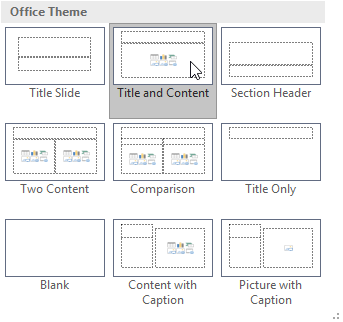
Placeholders can contain different types of content, including text, images, and videos. Many placeholders have thumbnail icons you can click to add specific types of content. In the example below, the slide has placeholders for the title and content .
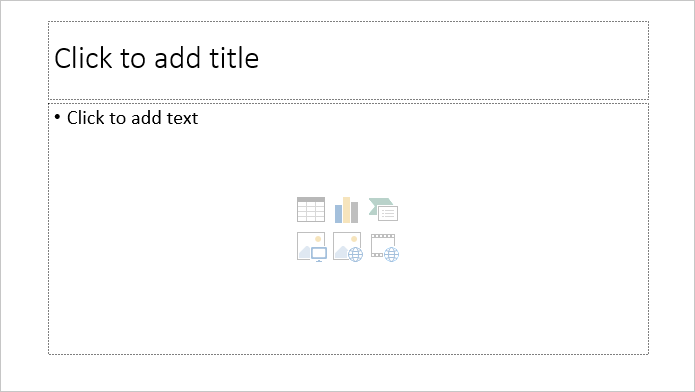
To insert a new slide:
Whenever you start a new presentation, it will contain one slide with the Title Slide layout. You can insert as many slides as you need from a variety of layouts.

To change the layout of an existing slide, click the Layout command, then choose the desired layout.
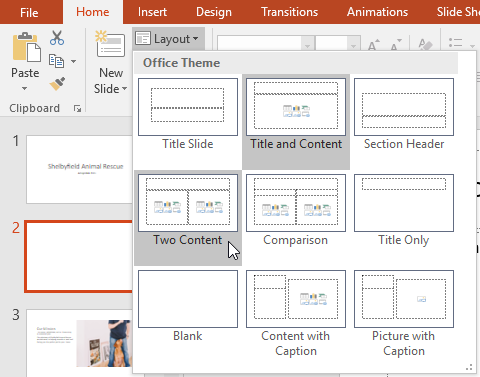
To quickly add a slide that uses the same layout as the selected slide, click the top half of the New Slide command.

Organizing slides
PowerPoint presentations can contain as many slides as you need. The Slide Navigation pane on the left side of the screen makes it easy to organize your slides. From there, you can duplicate , rearrange , and delete slides in your presentation.
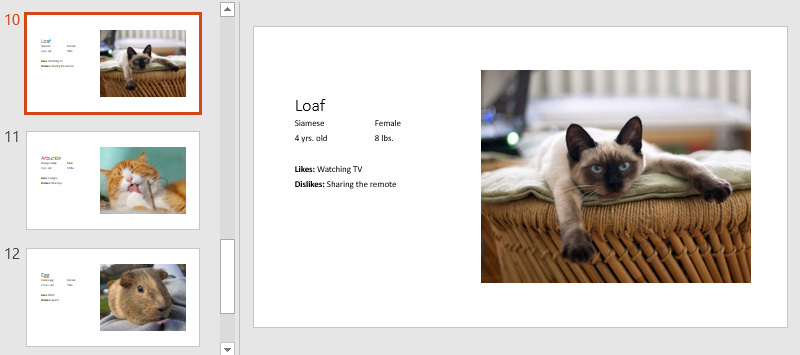
Working with slides
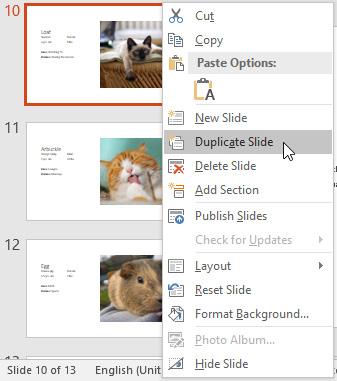
- Delete slides : If you want to remove a slide from your presentation, you can delete it. Simply select the slide you want to delete, then press the Delete or Backspace key on your keyboard.
To copy and paste slides:
If you want to create several slides with the same layout, you may find it easier to copy and paste a slide you've already created instead of starting with an empty slide.
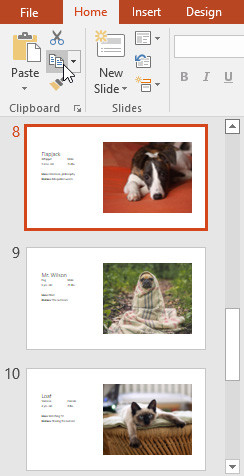
Customizing slide layouts
Sometimes you may find that a slide layout doesn't exactly fit your needs. For example, a layout might have too many—or too few—placeholders. You might also want to change how the placeholders are arranged on the slide. Fortunately, PowerPoint makes it easy to adjust slide layouts as needed.
Adjusting placeholders
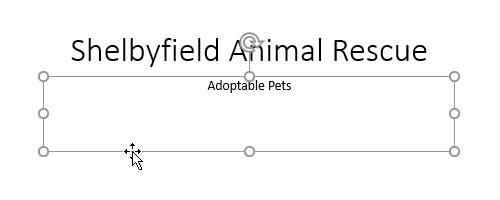
- To delete a placeholder : Select the placeholder you want to delete, then press the Delete or Backspace key on your keyboard.
To add a text box:
Text can be inserted into both placeholders and text boxes . Inserting text boxes allows you to add to the slide layout. Unlike placeholders, text boxes always stay in the same place, even if you change the theme.

Using blank slides
If you want even more control over your content, you may prefer to use a blank slide , which contains no placeholders. Blank slides can be customized by adding your own text boxes, pictures, charts, and more.
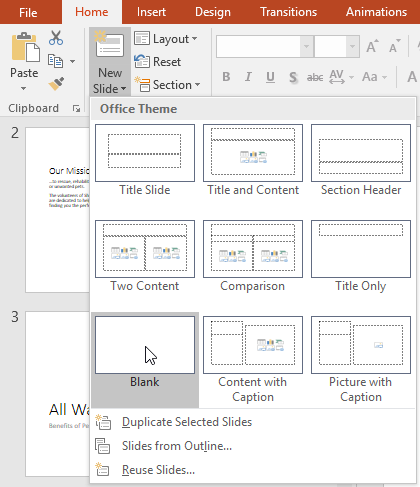
While blank slides offer more flexibility, keep in mind that you won't be able to take advantage of the predesigned layouts included in each theme.
To play the presentation:
Once you've arranged your slides, you may want to play your presentation. This is how you will present your slide show to an audience.
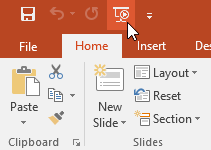
- The presentation will appear in full-screen mode.
- You can advance to the next slide by clicking your mouse or pressing the spacebar on your keyboard. You can also use the arrow keys on your keyboard to move forward or backward through the presentation.
- Press the Esc key to exit presentation mode.
You can also press the F5 key at the top of your keyboard to start a presentation.
Customizing slides
To change the slide size:.
By default, all slides in PowerPoint 2013 use a 16 - by-9 —or widescreen —aspect ratio. You might know that widescreen TVs also use the 16-by-9 aspect ratio. Widescreen slides will work best with widescreen monitors and projectors. However, if you need your presentation to fit a 4-by-3 screen, it's easy to change the slide size to fit.
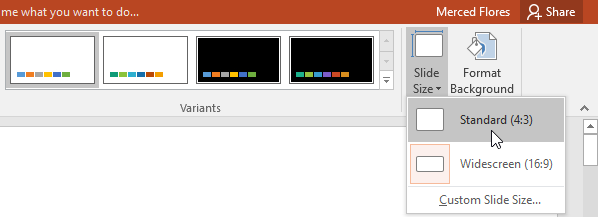
To format the slide background:
By default, all slides in your presentation use a white background . It's easy to change the background style for some or all of your slides. Backgrounds can have a solid , gradient , pattern , or picture fill.

- The background style of the selected slide will update.
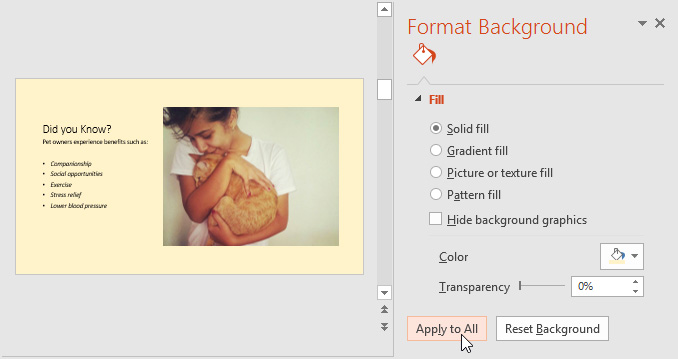
To apply a theme:
A theme is a predefined combination of colors, fonts, and effects that can quickly change the look and feel of your entire slide show. Different themes also use different slide layouts , which can change the arrangement of your existing placeholders. We'll talk more about themes later in our Applying Themes lesson.

Try applying a few themes to your presentation. Some themes will work better than others, depending on your content.
- Open our practice presentation .
- Change the theme of the presentation.
- Delete slide 7. This slide should be blank.
- Add a new slide with the Title and Content layout to the end of the presentation.
- In the Title placeholder, type Adoption Event Dates .
- Select the Content placeholder and delete it.
- Insert a text box and type July 17, 2017 inside it.
- Change the slide size to Standard (4:3) . A dialog box will appear asking if you want to maximize or ensure fit. Choose Ensure Fit .
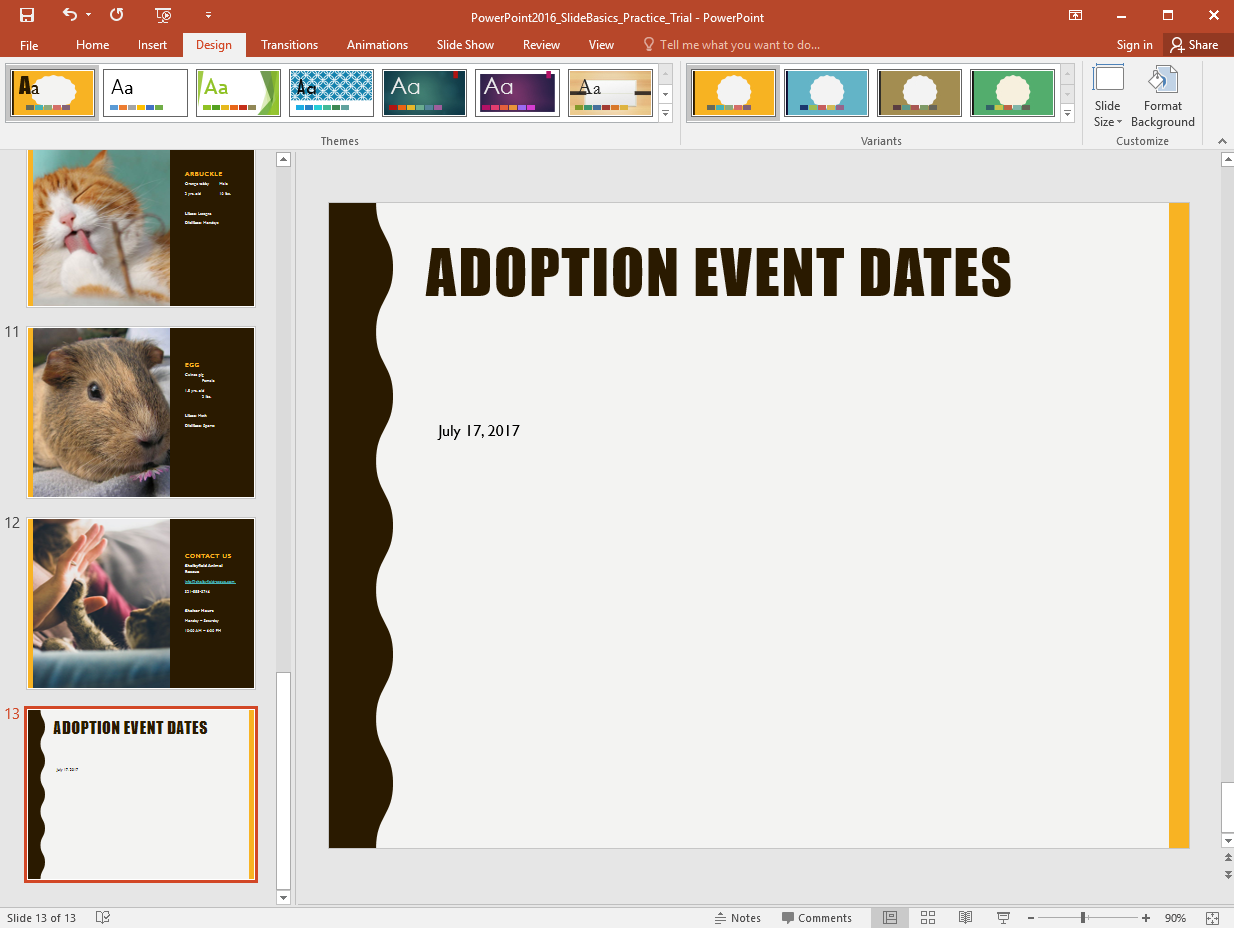
/en/powerpoint/text-basics/content/
- Google Slides Presentation Design
- Pitch Deck Design
- Powerpoint Redesign
- Other Design Services

- Business Slides
- Guide & How to's
- Types of presentations
Presentations are used in almost every sphere, be it business presentation, education, or even entertainment. Naturally, there’s no single solution for a presentation. In fact, there’s a lot of things to consider when you choose the types of presentation . While your presentation’s goal certainly matters, there’s also the visuals, the lengths, the type of presentation style and a lot of other features to consider. In other words, that’s a lot to choose from. How to figure out what suits you best among the types of PowerPoint presentation ? Let’s review some of the common ones and you’ll certainly get some fresh ideas!
Type 1: Elevator Pitch
One of the most common types of presentations in business , the elevator pitch is quick, informative, and incredibly versatile. It derives its name from the business world, where sometimes you only have time during the elevator ride to present your idea and persuade your potential investor. The initial type of presentation in business doesn’t actually require slides, since it is basically a speech lasting up to three minutes that explains your idea and its benefits. However, in a broader sense, it is a name used for short presentations up to 10 slides, describing the main points and having minimal visual support, mostly centered around simple infographics or graphs.
Type 2: Informative presentation
This type of presentation is usually a longer one, and naturally it contains a lot of information, since its goal is to inform the audience on a subject. This is probably the most common type of presentation style for college, but it is widely used in business as well, mainly for internal tasks, like explanation of the changes in company’s structure etc. This type of presentation usually features a lot of text and may also include rather complex visuals. So, there’s naturally a risk of being really boring. A good thing to do in this presentation type is to try to make it interactive – ask questions, add some videos and so on.
Type 3: Storytelling
Another great type of presentation in business (or actually any other sphere) is the storytelling presentation type. In essence, it is a presentation built like a story — where your points are illustrated by examples, either from your life or from life in general. This presentation type is usually heavy on text content, but using visuals in support can make for a much better experience. Even the most interesting story might be rather dull when it is too long. Using media may present a great distraction for your audience that would, however, still keep them on track.
Type 4: Visual presentation
This presentation is where the text part gives way to the visuals. Graphs, infographics, videos and pictures, visualization powerpoint — everything that can illustrate your point properly will fit. This type of PowerPoint presentation is probably the most captivating for the audience and certainly the most good looking. To succeed with this presentation, you’ll have to use visuals that would require minimum explanation. To a certain extent, such presentations can actually present themselves with little participation of a speaker. Your task as a presenter here is to guide the audience through your amazing visuals.
Type 5: Roadmap presentation
A rather innovative and mostly a type of presentation in business , the Roadmap is built to show how to get to the objective. For presentation design service an objective is usually presented at the beginning, and the whole presentation basically consists of the milestones that should be achieved on the way to said objective. Among the different types of presentation , this one is really heavy on infographics. What is more, there’s plenty of opportunities here to experiment with unusual slide layouts and the continuity of images on slides, since such presentations tend to follow the “road” structure and use the road imagery in the design.
Type 6: Problem solving presentation
As you have probably guessed, in this presentation your content would be built around a certain problem for which you then design a solving strategy. It is a pretty universal type of presentation since it can be used in pretty much every sphere. What is especially good about this presentation is that you can apply any of the problem-solving techniques to it, which makes you really flexible in terms of structure. What is more, the problem might (and actually should) resonate with the audience, increasing the involvement and interest in what you are talking about.
Type 7: Instructor presentation
This presentation type is quite similar to the informative presentation: there’s lots of content and a lot of text to deliver in your speech. It is a perfect type of presentation for really complex topics that require high levels of understanding from both the audience and the presenter. Instructor presentations usually feature quite a lot of visual support and are longer than the average presentations. While it may be hard to make the presentation as light as for example the elevator pitch or a visual presentation, it is better to reserve this style for the subjects in which both you and your audience are greatly interested. You can also use professional presentation services to help you with it.
Type 8: Text only presentation
At first glance it may seem like a really bad idea, but who said that text can’t look beautiful? Text only presentation allows you to throw away all the unnecessary elements and make the audience focus entirely on your content. Keep in mind that this presentation type doesn’t suggest that you should use walls of text and bore your audience to death. On the contrary, you can conveniently organize your text into bullet points and one-sentence statements that can be a great backbone to your speech.
In conclusion
There’s no shortage of presentation types and creative ideas. Depending on the type of your content and the message that you convey you can choose any of them. But what is more, you can combine them as well, creating a unique and engaging work that would really impress your audience! We really hope that this article will give you some ideas of where to start with your presentation and what path to choose .
#ezw_tco-2 .ez-toc-widget-container ul.ez-toc-list li.active::before { background-color: #ededed; } Table of contents
- Presenting techniques
- 50 tips on how to improve PowerPoint presentations in 2022-2023 [Updated]
- Keynote VS PowerPoint
- Present financial information visually in PowerPoint to drive results

How to create a business plan presentation?

Writing an outline: creating a presentation blueprint

Business case presentation: how to prepare, write, and present
- Stream Your Favorite Sports
- Where to Watch WNBA Games
Slide Layouts in PowerPoint
Tips for setting up Slide Layouts
- Brock University
In This Article
Jump to a Section
- Understanding the Opening Slide
- Add a New Slide
Work With the Title and Content Slide
- Change Slide Layouts
- Work With the Slides Tab
- Customize a Slide
PowerPoint's built-in slide layouts give you the versatility and creativity you need to create slideshows that communicate your message clearly and effectively. Here are a few tips to help you use slide layouts in your workflow and structure information that reaches your audience.
These instructions apply to PowerPoint 2019, 2016, 2013, 2010; PowerPoint for Microsoft 365, PowerPoint Online, PowerPoint for Mac, PowerPoint for iPhone, and PowerPoint for Android.
Understand the Opening PowerPoint Slide
When you first open PowerPoint, your screen resembles the image above and includes these areas:
- Slide Pane : Each page of a presentation is called a slide . New presentations open with a Title slide in Normal view. The Slide Pane is where you'll add the text, images, and other screen-show elements that are a part of your presentation.
- Slides Tab : This area toggles between Slides view and Outline view . Slides view shows a tiny picture of all the slides in your presentation. Outline view shows the hierarchy of the text in your slides.
- Menus : This part of the user interface (UI) is known as the Ribbon . The Ribbon gives you access to all of PowerPoint's features and commands.
When you open a new presentation in PowerPoint, the first slide is the Title slide and contains text placeholders. To customize this slide layout, select the placeholder text and enter a new title and subtitle.
Add a New PowerPoint Slide
To add a new slide to your presentation, select Home > New Slide . This adds the Title and Content slide layout. This is the default slide layout and it contains placeholders for a title, bullet text, images , and illustrations.
If you need a different type of slide, select the New Slide down arrow . This opens a menu that contains nine different slide layouts. Choose one of these slide layouts to add it to your presentation.
When you select Home > New Slide , a new slide is added using the current slide layout. For example, if the current slide on the screen uses the Picture With Caption slide layout, the new slide will also be of that type.
The Title and Content slide layout contains placeholders for a title, a bullet list, images, and illustrations.
To add bullet text to this slide, select the bullet placeholder and enter your new text. Each time you press Enter , a new bullet appears for the next line of text.
To add content other than text to the Title and Content slide layout, select an icon from the set of six content types. The different types of content that can be inserted in this slide layout include a table, chart , SmartArt graphic, pictures, online pictures, and video.
Change PowerPoint Slide Layouts
If you've created a slide and you don't like the layout, change it to one of the nine different slide layout choices in PowerPoint. Display the slide you want to change in the Slide Pane and select Home > Layout (in PowerPoint 2019, select Slide Layout ) to see the list of available slide layouts. The current slide layout is highlighted. Select a different slide layout and the current slide takes on this new slide layout.
Here's a description of each of the built-in slide layouts:
- Title Slide : Use a title slide at the beginning of your presentation to introduce your topic.
- Title and Content : The default slide layout and the most commonly used slide layout.
- Section Header : Separates different sections of the same presentation.
- Two Content : Use this slide layout to show two columns of text and graphic content.
- Comparison : Similar to the Two Content slide layout, but this slide type also includes a heading text box over each type of content. Use this type of slide layout to compare two types of the same content type (for example, two different charts).
- Title Only : Use this slide layout if you want to place only a title on the page, rather than a title and subtitle. The area below the title is blank so that other content (such as clip art, WordArt , pictures, or charts) can be added as needed.
- Blank : A blank slide layout is often used when a picture or other graphic object needs no further information.
- Content With Caption : Contains two columns for text and content. The left column contains placeholders for text. The right column contains placeholders for images and illustrations.
- Picture With Caption : This slide layout is similar to the Content With Caption slide layout. The left side contains a placeholder for text and the right side contains a placeholder for a picture that is stored on your computer or cloud account.
Work With the PowerPoint Slides Tab
The Slides Tab is located on the left side of the PowerPoint screen. The default setting is Normal and shows thumbnail views of the slides in your presentation. If you'd rather see an outline of your presentation, select View > Outline View .
Each time you add a new slide, a miniature version of that slide appears in the Slides Tab on the left side of the screen. Select a thumbnail to place that slide in the Slides Pane for editing.
Customize a PowerPoint Slide
You're not limited to the layout of a slide as it first appears in PowerPoint. You may add, move, and remove text boxes and other objects at any time on any slide.
If no slide layout suits your specific needs, insert a Blank slide and add text boxes or other objects to fit the information you want to convey.
Get the Latest Tech News Delivered Every Day
- How to Use Copilot in Powerpoint
- An Introduction to PowerPoint
- A Guide to Using PowerPoint Slide Layouts
- How to Make a PowerPoint Presentation
- The 10 Most Common PowerPoint Terms
- Create Family Trees Using PowerPoint Organization Chart
- How to Create a Microsoft Sway Presentation
- How to Use PowerPoint Slide Master Layouts
- What Is a PowerPoint Placeholder?
- Different Ways to View Slides in PowerPoint
- Add, Delete or Change the Order of PowerPoint Slides
- Use Multiple Design Themes in the Same Powerpoint Presentation
- PowerPoint Master Slide
- Simple Quizzes in PowerPoint
- Create a Pie Chart Graphic in PowerPoint
- How to Add Page Numbers in PowerPoint

File formats that are supported in PowerPoint
PowerPoint supports several different presentation-file formats, as described below.
Use File > Save As to save your presentation as one of the file types listed below.
Important: PowerPoint doesn't support Pack and Go Wizard (.ppz) files.
Top of Page
Save as JPEG or other image type
When you save a presentation as a JPEG or other image file type, each slide becomes a picture and is saved as a separate file in a new folder.
Click File > Export .
Choose the location where you want to save your files, and then in the File Format box, click an option: JPEG, TIFF, PNG, GIF, or BMP.
Click Save .
In PowerPoint for the web, you can open these types of files for editing:
You can also open these older file types, but only to read the file, not edit it. If you want to edit a file of this type, open it and then use File > Save a Copy to save the file as a .pptx that can be edited:
You can't open the following file formats in PowerPoint for the web, but you can open a .pptx, .ppsx, or .odp file and then use File > Download As to save a presentation in these formats:
.jpg (When you choose this format, each slide in the presentation is saved as an individual .jpg image file.)
Video and audio file formats supported in PowerPoint
Package a presentation for CD or USB flash drive
Block or unblock external content in Office documents
Get Microsoft PowerPoint templates

Need more help?
Want more options.
Explore subscription benefits, browse training courses, learn how to secure your device, and more.

Microsoft 365 subscription benefits

Microsoft 365 training

Microsoft security

Accessibility center
Communities help you ask and answer questions, give feedback, and hear from experts with rich knowledge.

Ask the Microsoft Community

Microsoft Tech Community

Windows Insiders
Microsoft 365 Insiders
Was this information helpful?
Thank you for your feedback.

IMAGES
VIDEO
COMMENTS
Here are more than ten common different effective presentation styles: 1. Visual Presentation Style. The visual style is great for anyone who wants to use your presentation to complement the main points of your speech. This visual presentation technique is perfect for people who have many important talking points.
8 Different types of presentations every presenter must know. When it comes to presentations, versatility is the name of the game. Having a variety of presentation styles up your sleeve can make a world of difference in keeping your audience engaged. Here are 8 essential presentation types that every presenter should be well-acquainted with: 1.
6. "Blitzscaling: Book Trailer," Reid Hoffman. If you're going to go the minimalistic route, I'd take note of this PowerPoint presentation example from Reid Hoffman. This clean design adheres to a simple, consistent color scheme with clean graphics peppered throughout to make the slides more visually interesting.
Quick Read. Using different types of presentations helps you to adapt to different settings, improves audience interest and response, enhances the quality of presentations and increases the likelihood of recognition and promotion. The different types of presentations include; Educational, Instructional, Motivational, Persuasive and Problem ...
6. Powerpoint presentations. PowerPoint presentations or PPTs are the most effective ones among all types of presentations simply because they are convenient and easy to understand. They are available in different formats and are suitable to use in practically any type of presentation and context, be it business, educational, or for informal ...
7. The table slide. Similar to chart and diagram slides, table slides visually support your data and facts. They help declutter presentations and clearly convey your messages to your audience. This type of PowerPoint slide also helps you avoid overly long blocks of text that honestly, your audience won't read anyway. 8.
Tip #1: Build a narrative. One memorable way to guarantee presentation success is by writing a story of all the points you desire to cover. This statement is based on the logic behind storytelling and its power to connect with people. Don't waste time memorizing slides or reading your presentation to the audience.
Different types of PowerPoint presentations have specific goals, and entertaining presentations are often used in settings such as events, social gatherings, etc. Tips for Creating Effective Entertaining Presentations. Use Humor: Humor is a powerful tool that helps to engage and entertain the audience. Use jokes, puns, and witty remarks to add ...
Each of these has exactly 20 seconds, and they should transition automatically. This way, the speaker won't have the temptation of staying in one for too long. Because of all this, Pecha Kucha is a highly visual, concise presentation style. As you can probably imagine, It is a really hard presentation style to use.
Use clear and legible fonts, and maintain a consistent design throughout the presentation. 2. Visual appeal: Incorporate visually appealing elements such as relevant images, charts, graphs, or diagrams. Use high-quality visuals that enhance understanding and make the content more engaging.
Presentations can be called ideal objects for visualizing ideas. Slides allow you to focus on important things in more detail or discuss complex things. There are usually some types of visuals for presentations that are extremely effective in illustrating the relationships between things and processes. You can use images, text, drawings, graphs ...
Emphasize key points with text and images. Label your slides to prompt your memory. 1. Include less text and more visuals in your presentation design. According to David Paradi's annual presentation survey, the 3 things that annoy audiences most about presentations are: Speakers reading their slides.
This sixth presentation type shares status updates, progress towards deadlines, collected data so far, any obstacles popping up, and tasks that need to be added or adjusted. A team stand up presentation is a great example of this type of presentation. Team stand up presentations usually include an agenda, talking points, deliverable updates ...
Simple Slide Layout in PowerPoint Template. The Simple Presentation PowerPoint template has a multipurpose design that can be used for any type of presentation. It includes a light and a dark version and drag and drop image placeholders. The template is easy to customize. 4. Boris PowerPoint Template. The Boris template has a clean and minimal ...
Instructor Style. Coach Style. Storytelling Style. Connector Style. Lessig Style. Takahashi Style. Everyone on the internet has an opinion on how to give the "perfect" presentation. One group champions visual aids, another thinks visual aids are a threat to society as we know it. One expert preaches the benefits of speaking loudly, while ...
Summarize important points and ideas of your presentation in the end. 2. Persuasive Presentations. Persuasion is an art through which an individual influences the opinions, thoughts, decisions, and actions of others. Delivering persuasive presentations is a need of the hour for many business people like marketers, project managers, and ...
It's one of the best PowerPoint presentation graphics options thanks to its inclusion of graphics across 30 unique slides. 3. Groningen - PowerPoint Template. Remember, there are many types of PowerPoint presentation graphics. The best PPT graphics templates have a range of infographics, shapes, and more.
Download an inspirational presentation design now. Add your ideas to the slide layouts quickly to present with impact to your audience. And remember, premium PowerPoint presentation designs are a better value than free designs for PowerPoint. Discover more popular PowerPoint presentation design templates from Envato Elements.
Step-1: Select the Slide first. At first, you have to go to the slide you want to change the layout of and then click on the 'Layout' button in the 'Slides' section of the 'Home' tab. This will open a drop-down menu of all the slide layouts in your presentation. Step-2: Click on Layout and Select a Different Layout.
From the Home tab, click the bottom half of the New Slide command. Choose the desired slide layout from the menu that appears. The new slide will appear. Click any placeholder and begin typing to add text. You can also click an icon to add other types of content, like a picture or chart.
Method 4: Rehearse. Don't rush to tell your presentation just once you've made it. Instead, try to first rehearse your presentation in front of a mirror. This presentation technique allows you to spot the mistakes and downfalls in your speech and visual part and improve powerpoint presentation.
Type 4: Visual presentation. This presentation is where the text part gives way to the visuals. Graphs, infographics, videos and pictures, visualization powerpoint — everything that can illustrate your point properly will fit. This type of PowerPoint presentation is probably the most captivating for the audience and certainly the most good ...
There are 4 different types of presentations I would like to discuss in this article: informative, demonstrative, persuasive and special occasions. Different Types of Presentations. Informative. An informative presentation provides information about a topic and is for explanatory or educational purposes.
To add a new slide to your presentation, select Home > New Slide. This adds the Title and Content slide layout. This is the default slide layout and it contains placeholders for a title, bullet text, images, and illustrations. If you need a different type of slide, select the New Slide down arrow. This opens a menu that contains nine different ...
PowerPoint supports several different presentation-file formats, as described below. Windows macOS Web. Use File > Save As to save your presentation as one of the file types listed below. File type. Extension. Use to save. PowerPoint Presentation. .pptx. A presentation that you can open on a PC or a Mac.